

Over the past few days, Beijing has seen the heaviest rainfall since records began 140 years ago.
The torrential rains and massive floods have left 11 dead in Beijing and 9 dead in Hebei province.
Authorities are mobilizing an all-out effort to safeguard the people from the impact of disasters.

Continuous efforts have been made in reconstruction work in Beijing, Tianjin and Hebei province after severe rainstorms and flooding affected the area in late July and early August.
The work is aimed at ensuring that local residents live in comfort and that their homes remain heated during the winter.
In Zhaowang, a village in Zhuozhou, Hebei, Zhao Jie used a feather duster on a painting newly hung on a wall in her living room. The work depicts a flock of birds flying over a boat floating on a stretch of water against a backdrop of mountains and trees.
"This painting, Wealthy Water and Golden Mountain, symbolizes the hope we have here for life in the future," Zhao said.
The village is one of many in Zhuozhou that were severely affected in the summer, when rainstorms battered northern China and the Yellow and Huaihe river valleys, causing flooding and natural disasters.
At around 9 am on Dec 6, Zhang Shubin, team leader of a work group from the city's healthcare security bureau stationed in the village, visited Zhao's home and asked, "What is the temperature inside the house?"
Zhao said, "It is around 21 C, so it's quite warm."
Zhang's team arrived in the village immediately after the floodwaters receded, with a mission to help villagers recover their livelihoods as soon as possible.
Zhuozhou, which is situated just under 60 kilometers from Beijing, occupies 751 square km, and has a population of about 700,000. The county-level city is administered by Baoding city.

In the summer, rivers in Zhuozhou flooded more than 200 villages and 150 residential areas, affecting over 490,000 people and 1,685 businesses, the local government said, adding that the direct economic losses were 19.48 billion yuan ($2.74 billion).
In Zhaowang, more than 130 households experienced flooding that caused significant damage to properties throughout the village. Zhao's house was classified as a level-C dangerous home, meaning that her family could remain in the property, but some repair work was needed.
After the floodwaters receded, the family began repairing and reinforcing the house. "The reinforcement work was successfully completed with the help of the local government and the work group," she said. "We then bought some new furniture and moved back into the house in early November."
Statistics from the Zhuozhou bureau of housing and urban-rural development show that some 18,000 rural houses in the city have been repaired, 29,000 such properties reinforced, and 124 new rural homes built. All the recovery and reconstruction work scheduled for the area last year has been completed.
Work on the remaining 6,000 rural houses that need to be rebuilt will start in the spring, said the local government, which has also provided free construction materials for those in need.
On a bitterly cold day last month in Diaowosi, another flood-affected village in Zhuozhou, the streets were clean and tidy, with a number of wall paintings appearing on the roadsides, including one depicting relief work after the flooding.
"We showed the rescue work in the form of cartoons on the walls to remind us of the importance of working together in the face of disaster," said Zhang Kewei, 44, the village's Party chief, who took office immediately after the floods receded.
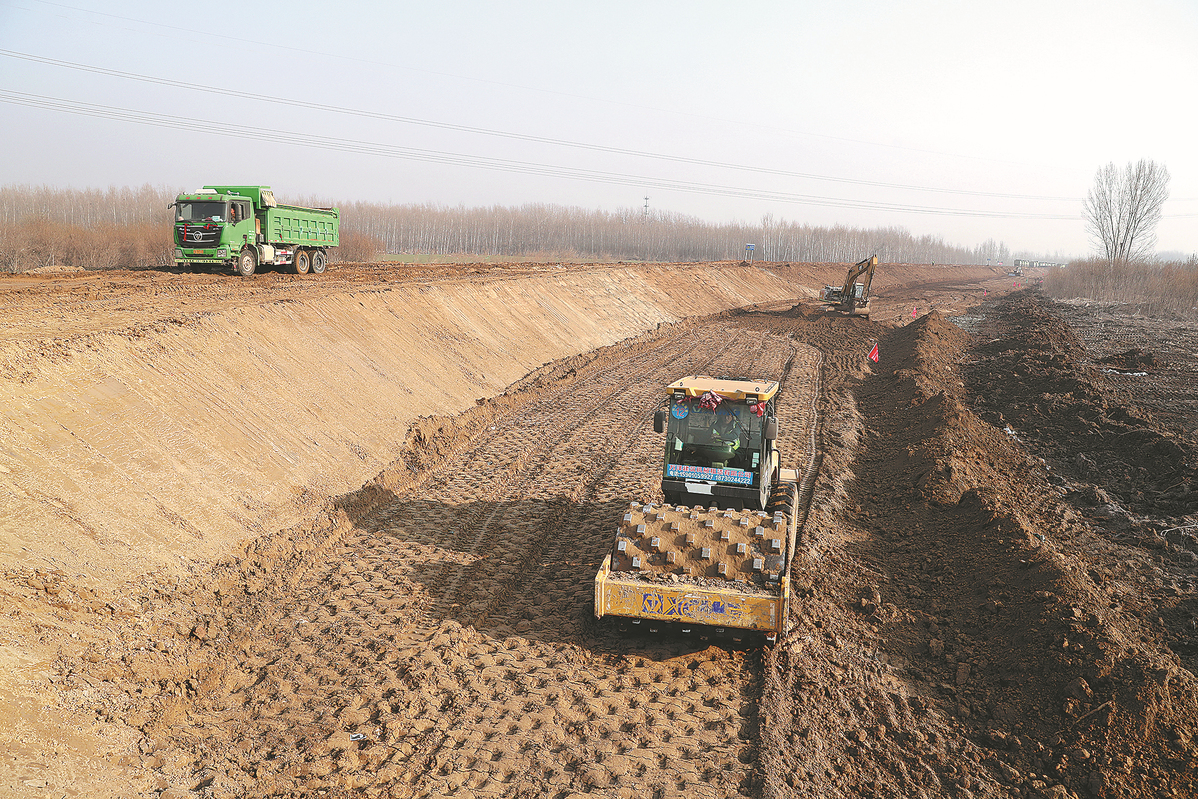
Abundant harvest
In Tianjin, Hao Xiangfeng, 46, a farmer from Diliufu village, Xinkou town, Xiqing district, is expecting a bumper harvest from the vegetables he planted in newly renovated greenhouses.
"Thanks to solid flood drainage efforts, the floodwaters receded in mid-September. During that month, I received a loan of 100,000 yuan, and later I was paid 500,000 yuan in compensation by the insurance company. These funds enabled me to renovate all 17 greenhouses and plant vegetables in October," he said.
Hao, who operates the largest farm in the village and also runs agritainment homestays, which are designed to draw locals with various attractions, said the crown daisies he planted in October have already flowered. The celery he planted in November will be ready for harvest in time for the Spring Festival next month.
Hao's story is just one of many that illustrate the agricultural sector's recovery in flood-affected areas of Tianjin.
The Diliufu Party chief, Hao Qingshui, said, "This autumn, we changed the crop variety. Instead of planting rice, we took advantage of the season to grow winter wheat."
Some 2,000 greenhouses in the village were inundated by floodwaters.
In addition to assisting residents, local governments helped companies resume production.
In Zhuozhou, financial institutions have granted 3,300 loans totaling nearly 2.03 billion yuan to businesses and farmers affected by the floods. All 1,685 enterprises and 9,294 individual businesses have resumed production, the local government said.
Last month, at a warehouse owned by BooksChina, one of the country's biggest online booksellers, staff members scanned the barcodes of titles ordered by buyers.
BooksChina, which has two publishing warehouses that occupy about 10,000 sq m in Zhuozhou, lost nearly 4 million books in the flooding, along with tools, vehicles, and sealing equipment.
After the floodwaters receded, Zhuozhou, which is home to more than 200 publishing houses, was left with warehouses full of ruined books.
Now, the three-story-high shelves at one of the BooksChina warehouses are full of new books. Workers search for titles ordered online, scan barcodes, and efficiently package customers' orders.
Huang Ping, founder of the company, said, "With help from the local government, we resumed operations in early September."
The company received support from all sectors of society after the flooding. With local government help, it has been granted rent reductions, three years of subsidized loans, and favorable insurance policies, Huang said.
Nearly 1 million books are now in stock at the company's warehouses.
"In future, we will be protected against property losses caused by disasters such as this," Huang said, adding that Baoding has established a joint insurance system for the book warehousing industry, with the local government sharing risks with insurance companies.
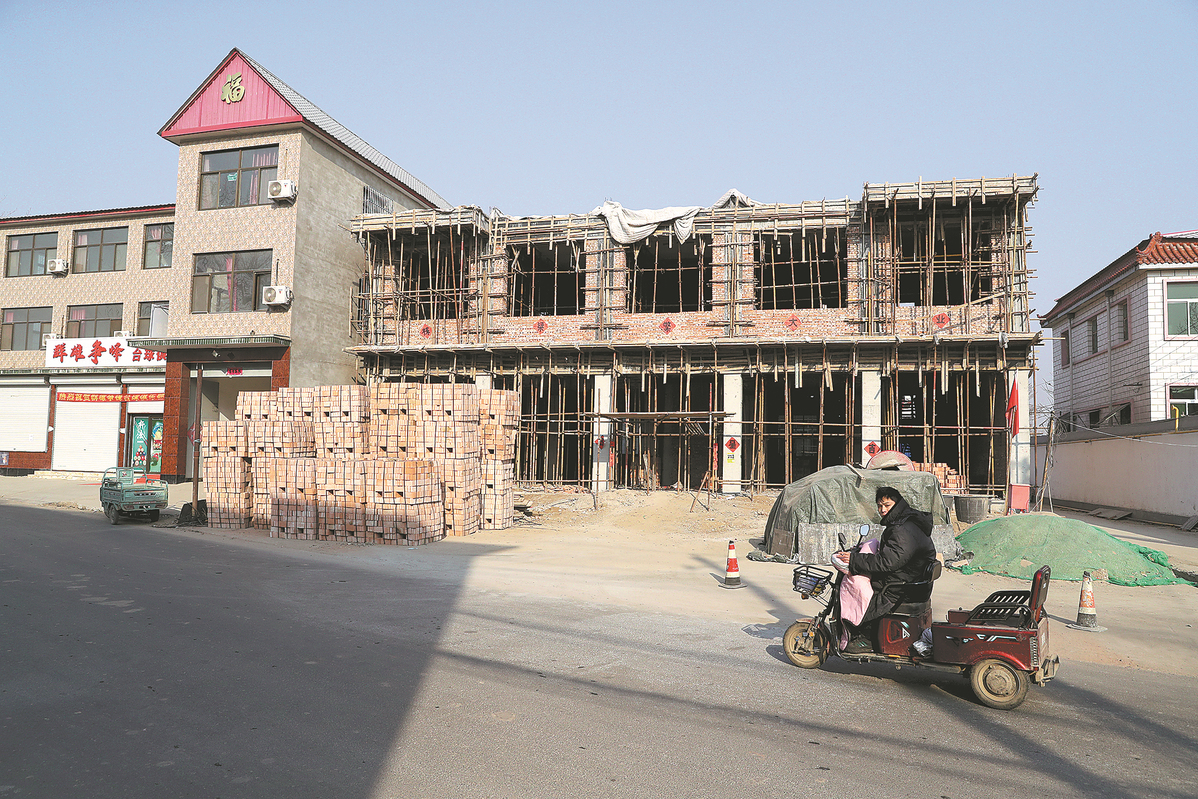
Cabins set up
To protect residents from further disasters, in early November, several 18-sq-m cabins were set up in Shuiyuzui village, Miaofengshan town, Mentougou district, Beijing. Despite their small size and plain appearance, the cabins are designed to safeguard lives when disasters occur suddenly, especially exceptionally heavy rainfall.
On July 29, Mentougou and Fangshan districts in Beijing experienced unprecedented heavy rainfall. The walls of houses in Shuiyuzui still show traces of the water level, which rose to 2.2 meters.
Liu Fuzhi, deputy director of the Mentougou science and information bureau, said, "The district is home to several ravines, making it difficult to relocate villagers at the same time. In isolated villages surrounded by mountains and valleys, there is an urgent need for such emergency shelters to provide continuous access to the internet, electricity and water during disasters."
In August, with support from government departments, including the Beijing Municipal Science and Technology Commission, and enterprises at Zhongguancun Intelligent Emergency Equipment Industrial Park, technology was used to help disaster-affected populations.
High-tech materials for power generation, heating, communication, and water purification were used in the emergency safety shelters. For example, the roofs of the shelters feature 20-sq-m photovoltaic panels, which Liu said can generate 5 kilowatt-hours of electricity.
"The amount of electricity generated by a photovoltaic panel varies between summer and winter. In summer, with about eight hours of effective sunlight, a panel produces around 40 kilowatt-hours, while in winter, with about four to five hours of sunlight, it can still generate more than 20 kilowatt-hours," he added.
In addition to providing power, the electricity generated by the panels contributes to the grid, producing economic returns.
The shelters also feature complementary energy resources, including diesel and energy storage facilities, to ensure the continuity and stability of power supplies. The complementary multi-energy power generation system guarantees that the equipment in a shelter can operate for 12 days under normal conditions.
Wang Baogui, manager at XYZ Storage Technology Corp, said: "After the flooding, we conducted on-site inspections in more than 20 villages to gain an in-depth understanding of the situation. We then spent three days formulating solutions."
Shelters are used for emergencies, and they also have their regular uses at other times, he said.
Beijing now has six emergency safety shelters, and more will be introduced based on requirements.

Project progresses
On a section of the Beijuma River, which flows through Zhuozhou, construction of flood control projects is progressing rapidly, with vehicles shuttling back and forth to the construction site.
The Beijuma River (Zhuozhou Section) Emergency Flood Control Project starts in Beitan village and ends at Xiaoying Dyke. The project includes building 8.2 km of new embankments, while 10.1 km of existing embankments will be raised and reinforced.
Wang Xiaoyang, 38, one of those in charge of the project's technological issues, said the work is expected to be completed in June, before the onset of the flood season. The work will not only help improve the flood control system throughout the Haihe River Basin, but will also address urban flood control issues in Zhuozhou.
"We have over 40 pieces of machinery operating on-site simultaneously, and more than 120 employees are working hard to meet the construction schedule, striving for an early completion," Wang said.
Meanwhile, the authorities in Tianjin have begun renovating the city's water facilities and have launched new construction projects since November.

Sources at the Tianjin Water Authority said significant investment has been made in projects, including the expansion of pumping stations along the Duliujian River, dredging and clearance work in the Yongding River's floodplain areas, and improvements to the drainage network in downtown areas.
Expansion of part of a pumping station on the Duliujian River is expected to increase the water flow from 44 cubic meters per second to 60 cu m. In addition, 9,751 meters of drainage pipelines in downtown Tianjin will be renovated.
Qiao Jianhua, director of the Haihe River Water Conservancy Commission, which reports to the Ministry of Water Resources, emphasized the valuable lessons learned from the flooding in the summer and underlined the crucial role played by water conservation facilities.
The importance of prompt forecasting, prevention work, and action plans to address the challenges posed by flooding was also stressed by Qiao.
Looking ahead, he said the authorities need to address problems related to flooding, improve water catchment facilities, accelerate the construction of reservoirs and work on renovating dams and waterways.
Qiao also acknowledged shortcomings in the forecasting capabilities for the Taihang and Yanshan mountains, and hopes that facilities in these areas will be upgraded.
"To ensure the safety of local residents, increased efforts are needed to implement prevention measures and improve infrastructure in risky mountainous areas, water catchment areas, and regions prone to frequent torrential downpours," he said.
Yang Zishuo contributed to this story.

Book warehouses and distributors in Zhuozhou, Hebei province, badly hit by heavy flooding in August have successfully resumed the majority of normal operations.
Zhuozhou, a county-level city about 70 kilometers southwest of Beijing, is a major hub in northern China for book sales and logistics, and boasts a large number of book warehouses.
In August, many of the warehouses were severely flooded with millions of books soaked by water.
After the disaster, logistics enterprises and the local government made major efforts to help the book industry recover and resume normal operations as soon as possible.
At Jiayu Cultural Book Industrial Park in Matou town, which is home to more than 120 companies involved in the book industry including publishers and traders, a bustling atmosphere has returned.
"We are now in full operation again, with the full range of books being sent to different parts of the country every day," Han Biao, the general manager of Beijing Southwest Logistics Center's Zhuozhou Branch, was quoted as saying by Baoding Daily.
According to Han, the company resumed normal operations on Aug 16 to try and ensure that various textbooks were delivered in time ahead of the fall school semester.
To reduce the pressure placed on book companies by the flooding disaster, the park has rolled out a series of measures to help them recover in a timely manner.
The rent for warehouses affected by floods, for example, will be waived for six months. In addition, rent will be reduced or waived over the next three years for some companies, said Zhou Miao, who is in charge of the park.
More than 10,000 square meters of spare warehouse space at the park will also be provided free of charge for a period to book companies that lost their warehouses in the floods. "At present, the return rate of the book enterprises in the park after the disaster has reached 96 percent, all of which have resumed normal operations," Zhou said.
As of Sept 20, 182 book-related businesses out of 213 that were affected by the floods have resumed normal operations in Zhuozhou, the city's press and publication bureau said on Sept 21.
The government has also organized a symposium on cooperation between local banks and book companies.
As of Sept 14, six companies had successfully borrowed 57 million yuan ($7.8 million) to spend on their recovery, the bureau said. About 10 million yuan in relief funds from central and provincial government agencies was also distributed to flood-hit companies.
"All of these different parties are trying their best. We have confidence we can quickly recover from the disaster and revitalize the industry," Zhou said.
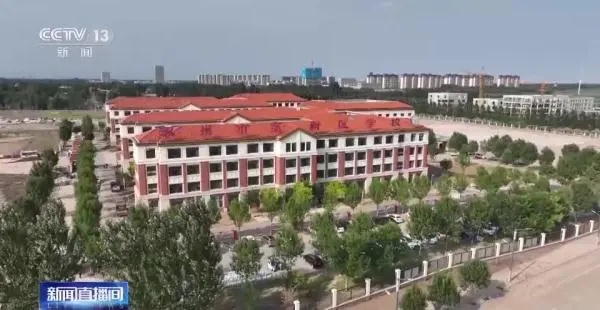
Flood-hit places in North China's Hebei province have been making all-out efforts to accelerate post-disaster reconstruction work, to try and ensure students return to school as scheduled and businesses resume production as soon as possible.
"I didn't expect we could go back to school on time because the flood had ruined so many facilities, including our school," said Li Xintao, a student at Baoding Wutan Center High School in Zhuozhou, which was one of the cities in Hebei hardest-hit by floods earlier this month.
Li, and more than 1,300 students and teachers, were recently notified that the new school semester will start on Friday. "I'm very excited and grateful to everyone who has contributed to the fast recovery," he said.
The school's buildings and playground were damaged to varying degrees, with two major power lines broken and the campus grounds covered in mud and debris after the floodwaters receded.
To make sure students can resume classes as scheduled, the school organized teachers, students and even parents to join in the restoration work, said Wang Jichen, a school official.
"We have completed the cleaning and disinfecting work, as well as repair of the power lines," Wang said.
The city is conducting safety assessments of 24 schools that were affected by the flooding, according to the local government. All 45 schools in the city can resume classes by Sept 1, it added.
In neighboring Laishui county in Baoding, which was also severely flooded, all of its 79 kindergartens and primary schools were affected.
Experts have been invited to assess the safety of the buildings of 12 flood-hit schools, while two badly damaged schools will need to be rebuilt, according to a report by Hebei Radio and Television Station.
About 130 students from the two severely damaged schools will be transferred to a nearby one for the new semester while their classrooms are being rebuilt.
"We have bought new tables and chairs, hoping they can feel a warm welcome," Wang Chunhua, principal of the Laishui Charity Primary School, was quoted as saying by the TV report.
In Xindu district, Xingtai, a total of 62 schools were affected by the floods. Of those, 36 have completed post-disaster reconstruction work, the report said.
"By Friday, we will have finished all the reconstruction work for our school," Xu Zhimin, the principal of Jiangjunmu High School in Xindu district, was quoted as saying.
Businesses are also gearing up to resume production as local governments devise ways to help the enterprises overcome their difficulties.
"Thanks to the bank's fast loan, I will quickly recover my farm," said Cui Xiqing, general manager of a sturgeon farm in Zhuozhou.
His farm lost assets of more than 40 million yuan ($5.5 million) after his nurseries and fishponds were submerged by 2-meter-high floodwaters.
The city's bureau of agriculture and rural affairs organized a Bank of China branch to provide loans through a simplified credit approval process to quickly meet people's needs.
The bureau has also dispatched a working team to help Cui remove dead sturgeons and clean up his farm. "Dead animals must be removed as soon as possible, as it is easy for germs to breed," said Liu Jinpo, deputy head of the bureau.
Cui said he is confident his farm will resume production soon, adding he is looking forward to a bright future for his business.

Damage in Beijing-Tianjin-Hebei region could have been a lot worse, officials say
Reservoirs in the Beijing-Tianjin-Hebei region played remarkable roles in alleviating disasters as the most devastating floods in six decades raged across the region in late July and early August, according to the Ministry of Water Resources.
The 84 medium and large-sized reservoirs in the region detained almost 2.9 billion cubic meters of floodwater during the heaviest flooding seen since 1963, Yao Wenguang, director of the ministry's department of flood and drought disaster prevention, said at a news conference on Monday.
This helped protect 24 towns and 500,000 hectares of farmland from being flooded, he said. If it were not for these reservoirs, over 4.6 million additional people would have needed to be evacuated.
"These reservoirs have played significant roles in flood control and disaster mitigation," he said.
Due to the impact from Typhoon Doksuri and cold air, the entire Haihe River Basin, which covers the Beijing-Tianjin-Hebei region, was engulfed by rainfall from July 28 to Aug 1. The average precipitation in the basin reached 155.3 millimeters, according to the ministry.
Beijing, for instance, received 331 mm of rainwater within just 83 hours, which is about 60 percent of its annual average precipitation, the ministry said.
The heavy downpours left 33 people dead and another 18 missing in the capital, and 82,000 people were evacuated, according to Beijing authorities.
The ministry said 22 rivers in the basin swelled above their warning marks, and eight of them experienced the heaviest flooding on record. In response to the devastating floods, the ministry issued an emergency response of Level I, which is the highest under China's four-tier emergency response system.
Liu Weiping, vice-minister of water resources, also highlighted the significant role detention basins played in flood mitigation.
To minimize the losses caused by the floods, the ministry put eight such basins into operation. The detention basins held over 2.5 billion cubic m of floodwater at the peak, he said.
Residents have begun returning to their homes in basin areas as water gradually subsides, according to the ministry.
On Saturday, the water resources and finance ministries disbursed another 500 million yuan ($69 million) to Hebei province and Tianjin to compensate residents in the basins for the losses they suffered.
On Aug 9, the two ministries urgently transferred 1 billion yuan for compensation to the two regions.
All flood damage to residents' crops, livestock, commercial forests, houses and agricultural machinery in the basin will be compensated and local authorities are striving to help them return to normal life, the ministry said.
Qian Feng, deputy head of the information center at the Ministry of Water Resources, said monitoring showed that the rainfall on average increased the levels of shallow groundwater in the Haihe River Basin by about 1 meter and supplemented roughly 8.5 billion cubic meters of groundwater in the basin.
The basin had added a total of roughly 20.6 billion cubic m of groundwater last year, he said.
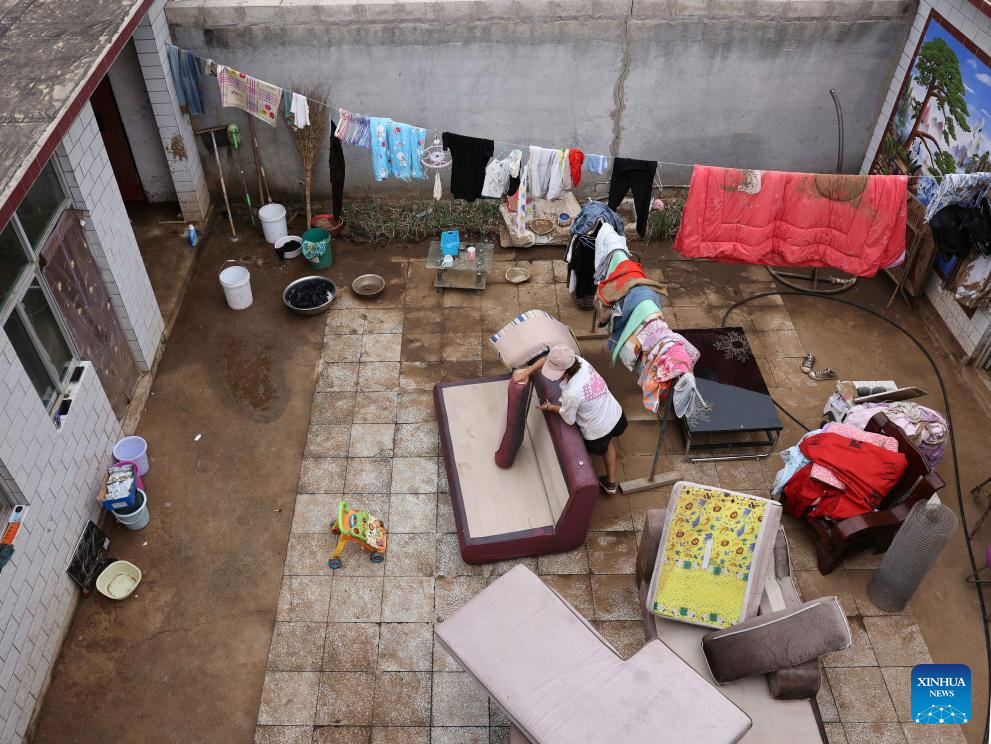
BEIJING -- Chinese authorities said Saturday they will ensure that residents affected by disasters can return home or resettle in new homes as soon as possible.
During a video conference, the office of the State Flood Control and Drought Relief Headquarters and the Ministry of Emergency Management said that the main flood season continues, and that the flood and drought situations in China's various regions remain "very complicated."
The two departments called for flood control and drainage work to continue in the Haihe River Basin by strengthening inspection procedures and security for flood channels and dikes in flood storage areas. Plans should also be made to ensure the security and production safety of industrial and mining enterprises during the flood season, they added.
The National Meteorological Center said in a forecast early Saturday that rainstorms are expected to hit parts of northeast China's Heilongjiang and Jilin provinces over the next three days, posing a moderate disaster risk. Rainstorms will also hit parts of Tibet and the provinces of Sichuan, Hunan and Shaanxi over the next three days.
Heavy floods and other rain-triggered disasters have hit many parts of China, especially the country's northern and northeastern regions, since early August, causing damage to property and forcing people to evacuate to safety.
In contrast to flooding in some regions, northwest China's Xinjiang and Gansu face a severe drought. The two government departments said that the emergency response will be optimized to ensure the drinking water supply for residents in the affected areas and to mitigate the drought's impact.

BEIJING -- The Ministry of Finance and the Ministry of Emergency Management on Saturday pre-allocated another 1 billion yuan (about 139 million U.S. dollars) as part of the central government's support for disaster relief work in regions affected by flooding.
The finance ministry said in a statement on its website that the new funding will mainly support relief work for residents severely affected by disasters, including those in the Beijing-Tianjin-Hebei region and in Heilongjiang and Jilin provinces.
The new funding will ensure that those affected by disasters are resettled properly, that production and life in impacted areas return to normal as soon as possible, and that affected residents are able to return home or move into new homes before the winter, the statement said.
Since the beginning of the flood season, the central government has allocated more than 9.68 billion yuan across various flood prevention and relief funds to disaster-stricken areas, the statement said.
In the statement, the Ministry of Finance ordered provincial-level financial departments to distribute the funds in a timely manner, strengthen the supervision of fund usage, and prioritize the protection of people's lives and property.

It was two days since Yun Peng, 31, helped rescue hundreds of people who were stranded on a train for two days due to flood, but his nerves were still frazzled.
Yun was working as a deputy track foreman on the Yanchi section railway in Mentougou district of Beijing.
After days of persistent rain brought by Typhoon Doksuri, many roads and houses in Beijing were damaged.

At 4:15 pm on July 30, Yun's colleague found a subsidence under a subgrade along the Fengsha section after three rounds of inspection. After 15 hours of nonstop work, Yun and his colleagues fixed it on the next morning.
Just several hours later, Yun found that the water volume was excessive under a bridge. The rapid water was shaking the piers violently. K396 train from Wuhai, Inner Mongolia, to Beijing Fengtai Station was about to cross the bridge.
Yun called colleagues in Luopoling Railway Station immediately, asking them to call the train back to the station.

After the train turned back to the station, a landslide occurred at a tunnel. Yun and his colleagues rushed to clean it up. But water rose to his chest in no time and rocks started falling behind them. Standing in despair, he called his wife, saying "I may not be able to come back. Please remember these names: Gao Jiaqi, Wang Dongwei, Zhang Yuan, Song Weiqiang, Lei Zhiping, Zang Le, Sun Hailiang, Yang Kang, Li Hongyan, and Wang Xiaolong. If we die here, you must tell others their names." Then he hung up.
Luckily, led by a senior colleague, they found a path not blocked by mud and rocks and escaped.
Shortly after they returned to their office, Yun received a call from Ma Ruixin, head of Luopoling Railway Station. The 980 passengers trapped in the train needed to be transferred to safe areas. Ma asked him how many people he can accommodate. Yun said at least 50. He got more than 300.

Yun and his colleagues placed the passengers in their dormitories while they slept in the hallway and cars at the night. They took out all the food, medicine and daily necessities and gave them to the passengers.
The railway tracks were blocked by fallen rocks. Yun went with 11 colleagues there, trying to repair the tracks. There were no big machines to use, so they used their hands and shovels to clean up the mud and stones.
"We only had one thing in mind. Even though the train can't go through, we need to dig a way for them to walk out," said Yun.
[Video provided by Beijing bureau of China State Railway Group]
On Aug 1, Beijing Municipal Public Security Bureau sent helicopters to carry food and daily necessities to the trapped people there. However, after the helicopters arrived at Luopoling Railway Station, Yun, who used to be a soldier, realized that the helicopters were facing difficulty on finding a landing spot. If they couldn't find a safe spot to land, the mission will be canceled. Yun rushed to his office to grab the red and yellow flags used in railways. He chose an open court with no barriers and waved to the helicopters with the flag signals he learned when he was a soldier, guiding them to land on a safe spot successfully.
Cheers from the crowd overwhelmed the roar of the helicopter and wind. The pilots gave Yun a thumb-up.
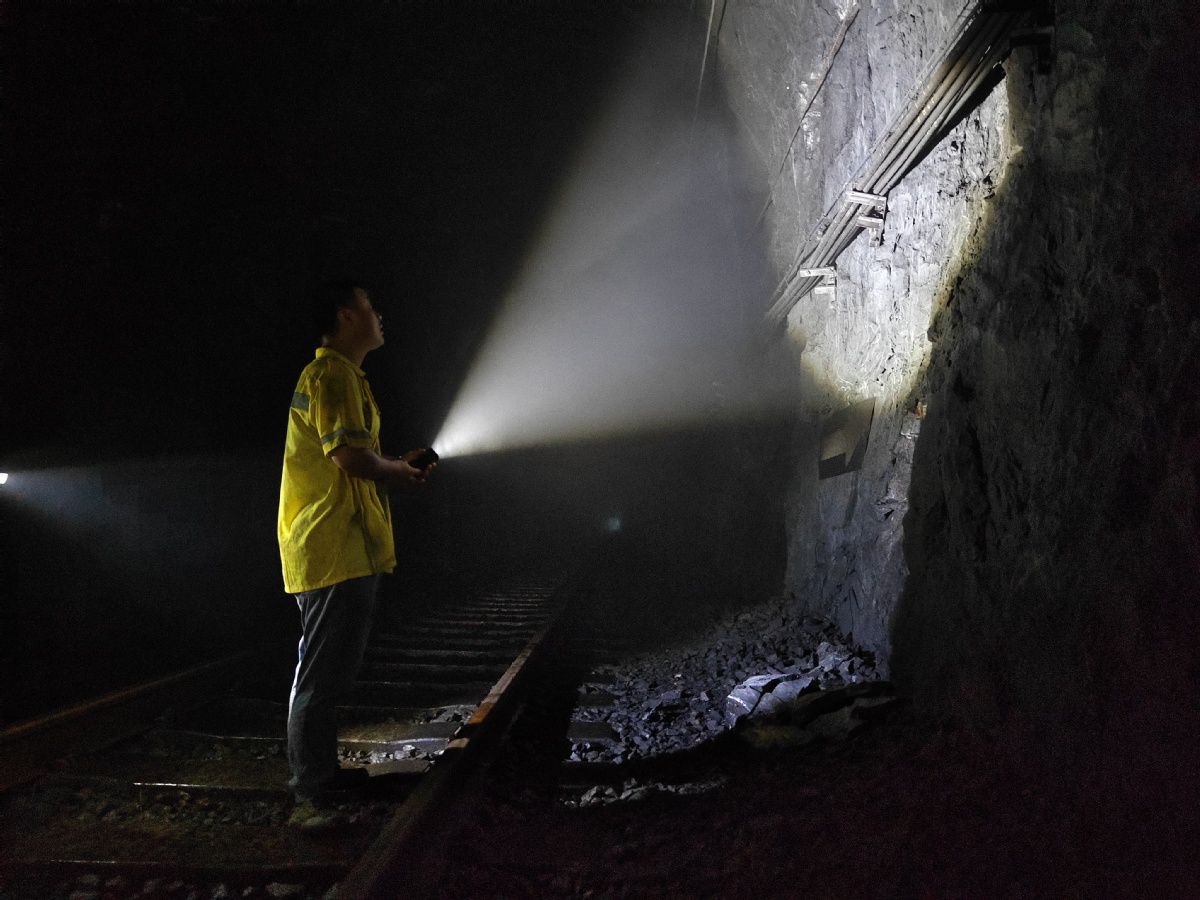
On Aug 2, good news came. Armed police officers will lead the passengers out on foot to a temporary station, where they will board a train heading to Beijing Fengtai Station. When the time came to evacuate, some passengers were anxious. Yun walked to the leader of the armed police officers, volunteering to lead the way. "I'm familiar with the landform here. Let me walk in the front."
Finally, all the passengers walked out safely. They hugged Yun and his colleagues to express their gratitude.
Someone asked Yun, "Was it worth it?" "Of course," said Yun without any hesitation. "If I had to do it all over again, I would also rush to the front, because I am a Party member and a railway worker."
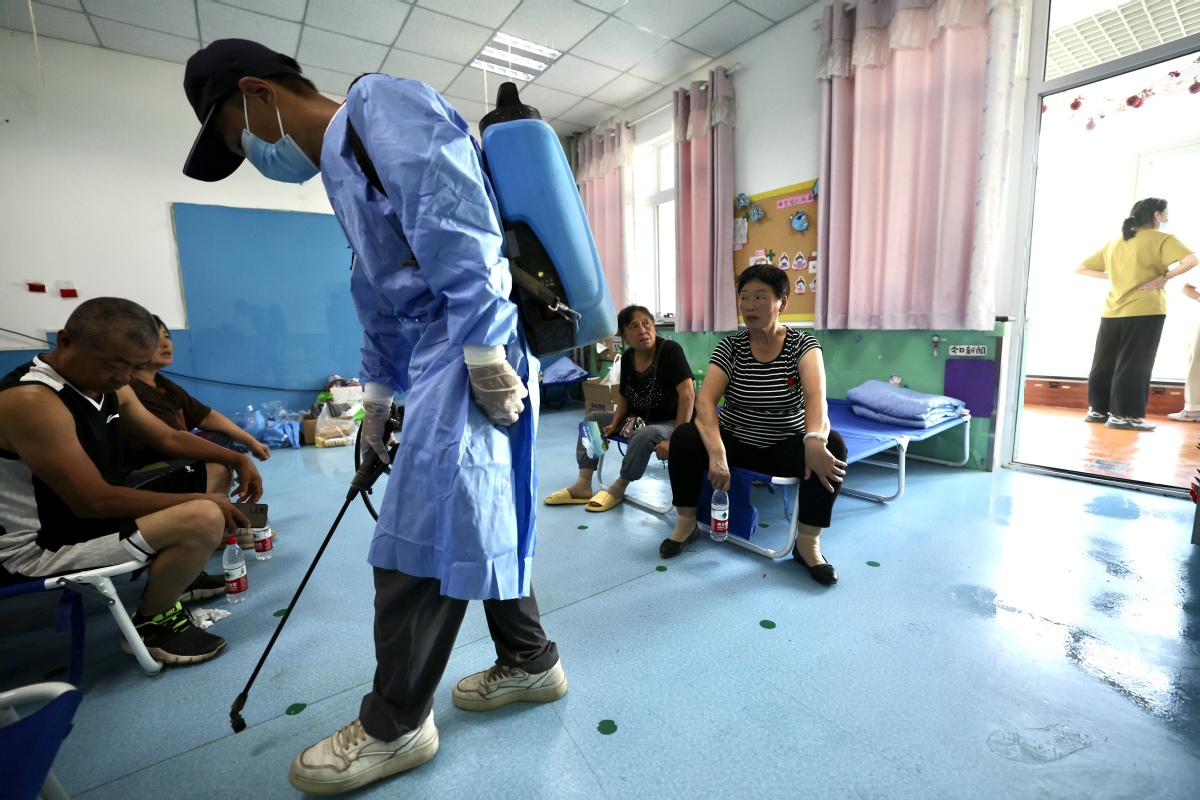
Some villagers in Beijing's Mentougou district were allowed to return to their homes on Tuesday, after being evacuated to escape the recent severe flooding brought by historic torrential rain.
After assessing the damage with their own eyes, many said it was clear that it will take time for them to rebuild their homes and for their villages to return to what they once were.
Yang Yulan from Nanxinfang village had to climb over the rubble of collapsed houses and crawl under fallen electrical wires to get to her home.
Despite this, she said she was lucky because unlike the houses near the riverbank, her home was still standing.
The 70-year-old has lived in the village in Tanzhesi township for about 50 years.
She said she had never before experienced the ferocity of the torrential rain and flash flooding that struck Beijing from July 29 to Aug 2.
"I was at home all by myself on July 31, and all of a sudden the flood came. Muddy water started to rise fast. I wanted to call for help but there was no cellphone signal. All I could do was to climb up and cling to the window frame. The water quickly reached my knees," said Yang, whose house has been left covered in a thick layer of mud.
Fortunately, she was soon rescued by village officials who came in search of villagers.
To help them evacuate, Zhang Zhen, Party chief of the village, strung up a rope connecting higher ground on both sides of the river that runs through the village.
The officials and rescuers were then able to carry villagers, many of whom are elderly, to safety.
The houses near both sides of the river have been completely destroyed by the flood, making Nanxinfang one of the worst-hit villages in the township.
Despite this, all the villagers were evacuated. Some were taken to disaster relief shelters while others chose to stay with relatives.
The unprecedented rain caused the most devastating, widespread and economically costly natural disaster ever recorded in Mentougou, according to Yu Huafeng, Party chief of the district.
"Rebuilding will be necessary in 40 villages in the district. In Tanzhesi, 47 percent of the villages were hit by the disaster."
Despite returning to her home and looking around, Yang took nothing away with her.
"All the things are ruined and not worth salvaging at all. It's really sad to see my home like this but I am just happy to be alive," she said as officials from the emergency management department registered the damage to the houses in the village.
Jia Honglin, Party chief of Jiagou village, said the village square has been filled with heavy boulders washed down the mountain by the floodwaters.
"Boulders weighing tons have been pushed around so easily by the floodwaters just like someone playing basketball. That's how powerful the flood was," Jia said.
According to the Tanzhesi government, a special team has been set up to lead the disaster relief and reconstruction work of the six worst-hit villages, including Nanxinfang and Jiagou.
By Aug 9, all roads and electricity supply had been restored in the worst-hit villages.
Meanwhile, authorities are still busy fixing drinking water pipelines destroyed in the flood, it said.
"It's obvious that it will take quite some time to clear up the rubble and start reconstruction projects in the village," Yang said. "We need all the help available."
The death toll from the torrential rain and floods in Beijing has reached 33, including five rescuers. A total of 18 people are still missing, the city government said on Aug 9.
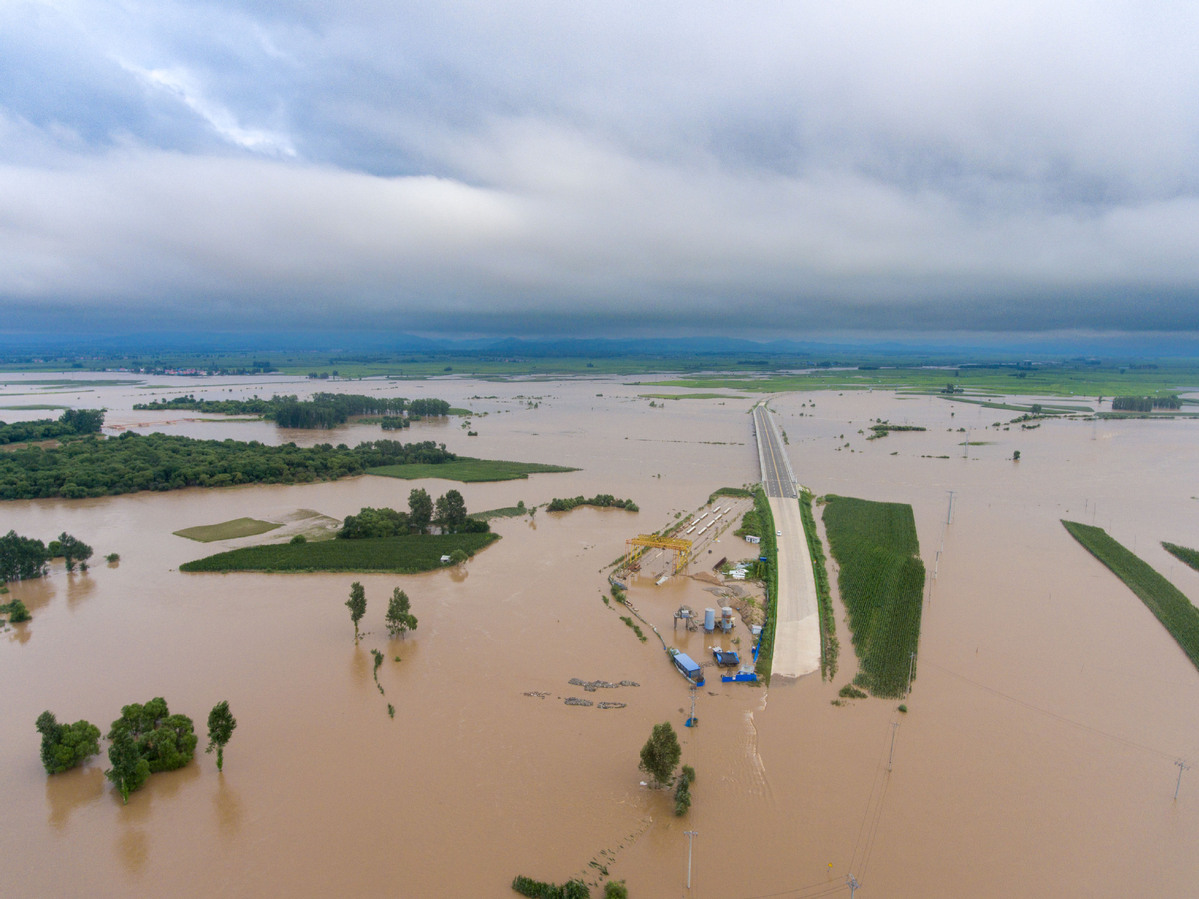
Authorities are suggesting that farmers tap the potential of "courtyard economy" to bolster their financial standing as torrential rains have hit many northern provinces in recent months, inundating grain fields and bringing new burdens to many vulnerable families.
The National Rural Revitalization Administration on Thursday published on its website a readout of a recent meeting convened by the agency's director Zhao Huanxin, who is also a vice-minister of agriculture and rural affairs.
The readout said that those attending the meeting agreed that grassroots officials must make utmost efforts to stabilize the income of disaster-affected farmers. They also put forward a slew of measures including offering support to help them generate income from their courtyards as a self-saving strategy.
"The income of disaster-stricken populations must be shored up by all means," the readout said.
Most rural families live in home with a courtyard, which often has small parcels of land allowing families to grow their own food and rear livestock.
In addition to farming, the dwellers can engage in running homestays and making handicrafts for their own use and for trade within the community.
According to the readout, the meeting's participants also asked local authorities to help businesses with a sizable amount of financially strapped employees to overcome flood-induced disruptions and recover production, and recruit poor farmers in disaster-relief projects so that they can get paid.
Data provided by the National Bureau of Statistics showed that the size of courtyard economy has reached 1.4 trillion yuan ($191 billion), and income generated from relevant activities accounts for about one-fifth of per capital income in rural regions.
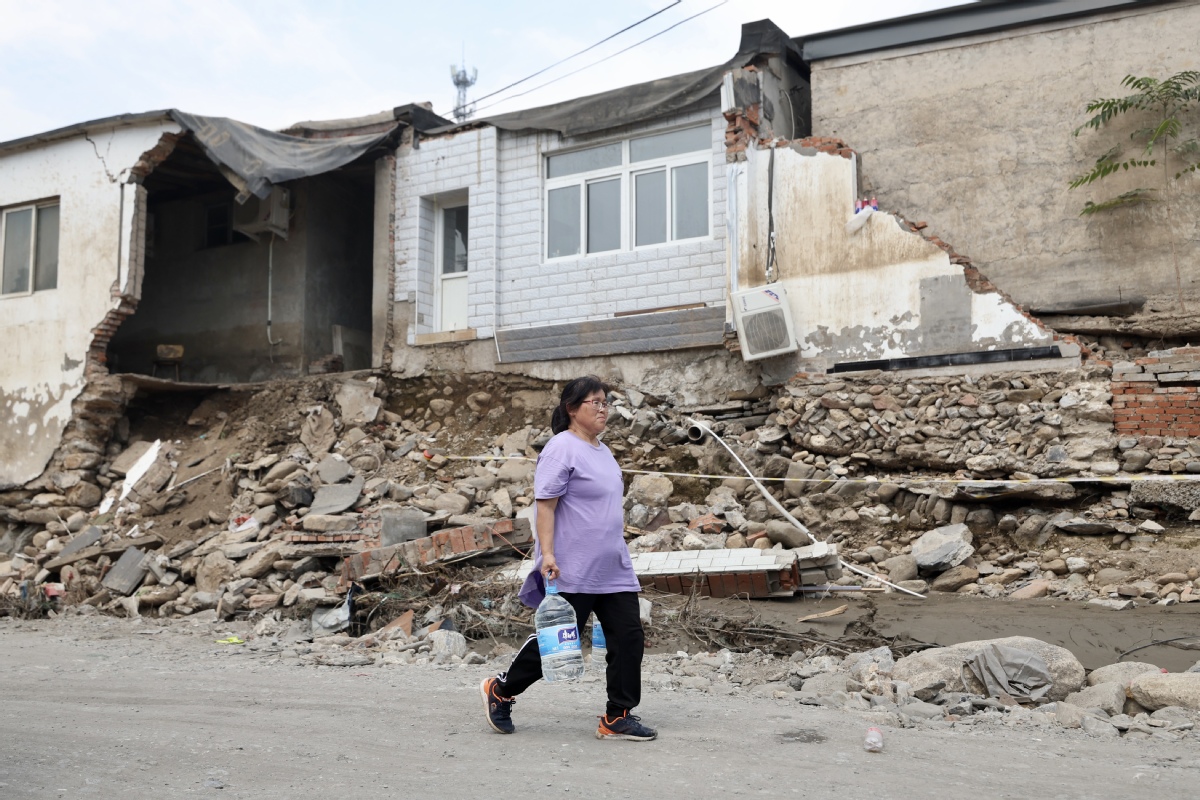
Road cleanup and village disinfection work is underway in Tanzhesi town, Mentougou district of Beijing, in the aftermath of the severe floods caused by torrential rains brought by Typhoon Doksuri.
A total of 47 percent of the town's villages were severely affected. As of Aug 9, all village roads in the surrounding area have been repaired and reopened. Power supplies and network access have also been restored. Efforts to repair water supply pipelines in some villages are ongoing.
This event marks the most severe natural disaster ever experienced in the Mentougou district in terms of intensity, affected areas and economic loss, according to Yu Huafeng, the district's Party chief.
An estimated 310,000 people, 77 percent of the district's population, have been affected. Over 8,418 houses were destroyed, and an additional 26,493 suffered severe damage. Essential infrastructure, including urban and rural roads, electricity, water supply, and communication facilities have also incurred extensive damages. Reconstruction efforts are expected to take place in 40 villages across the district.
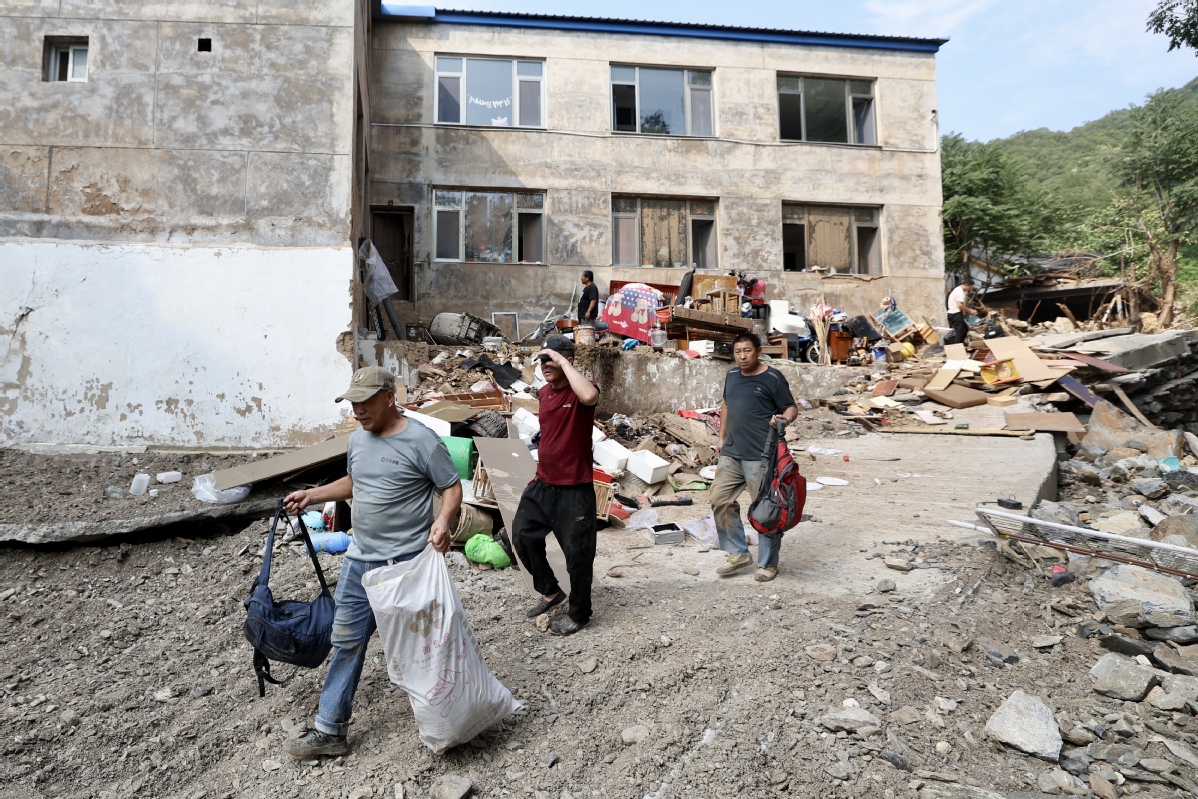
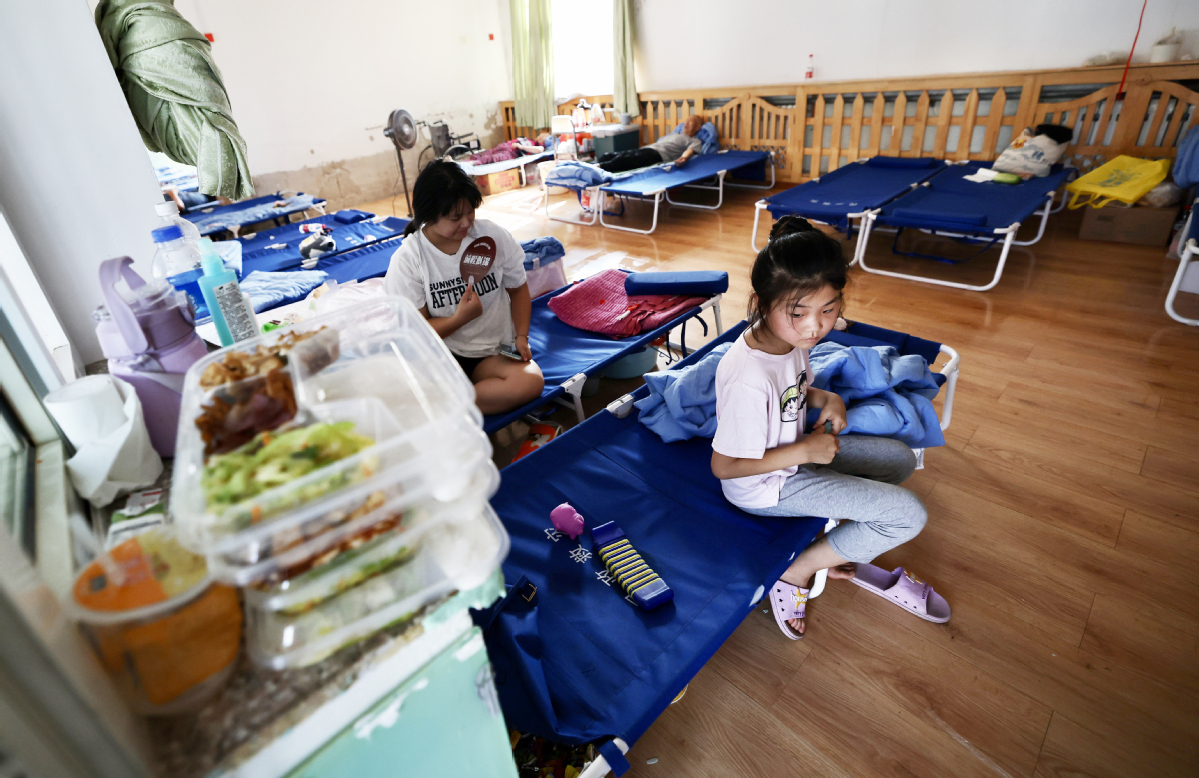
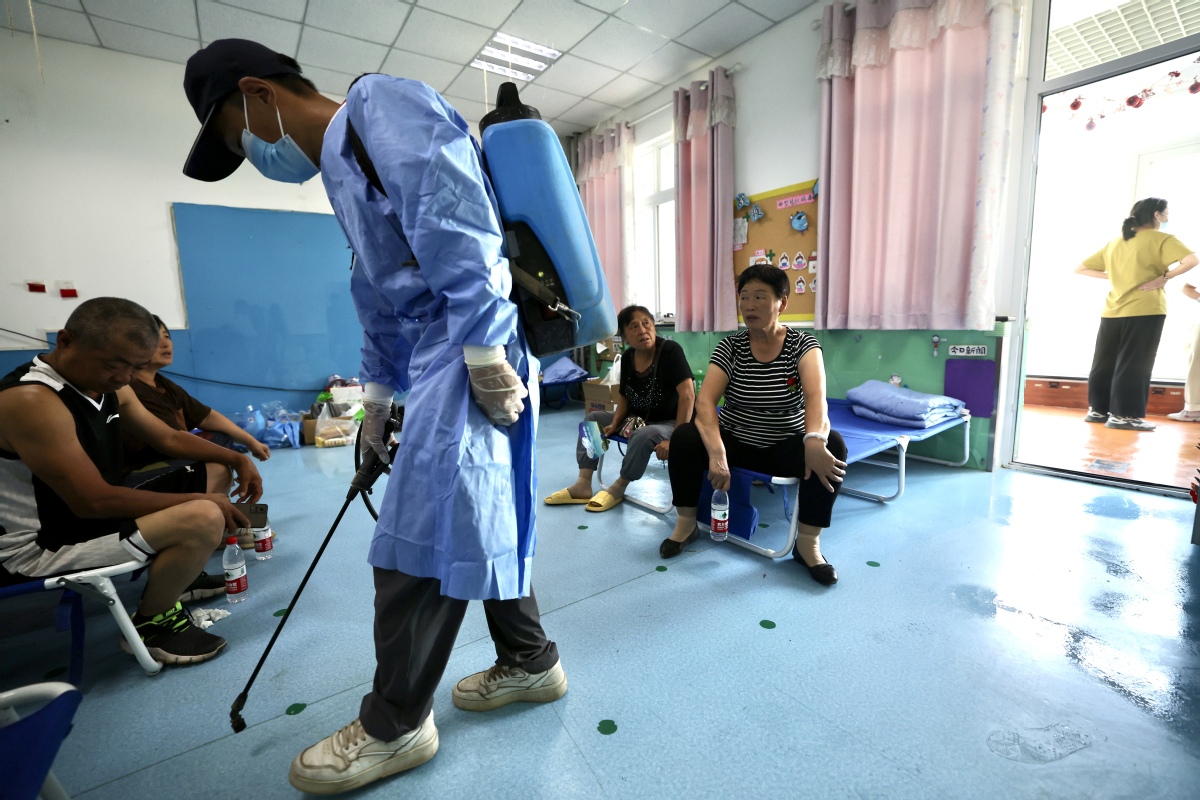
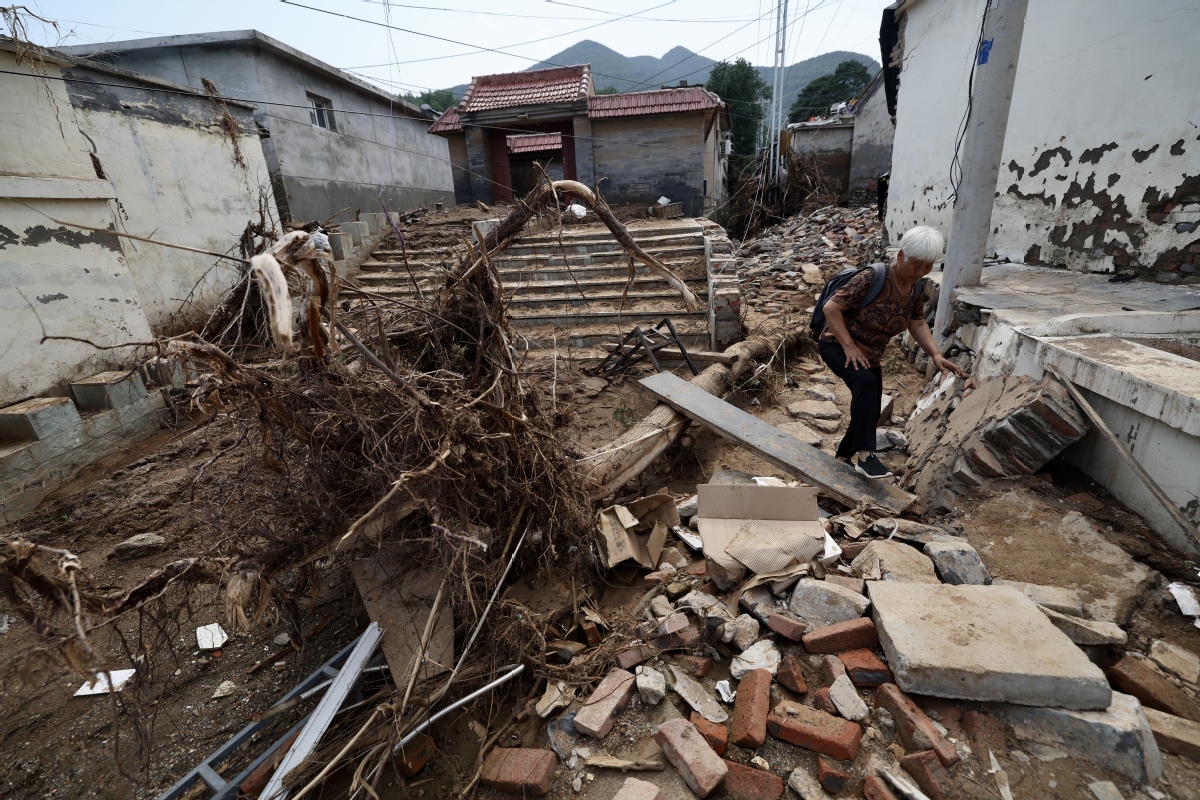
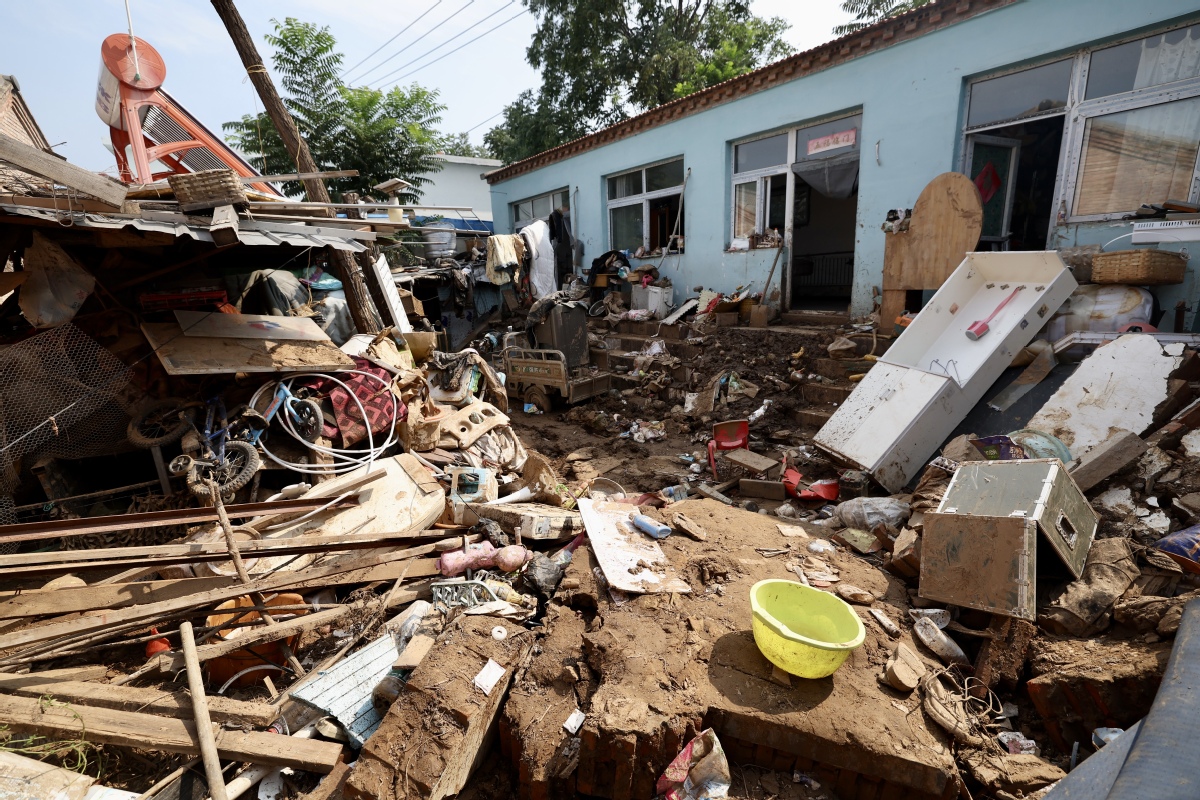
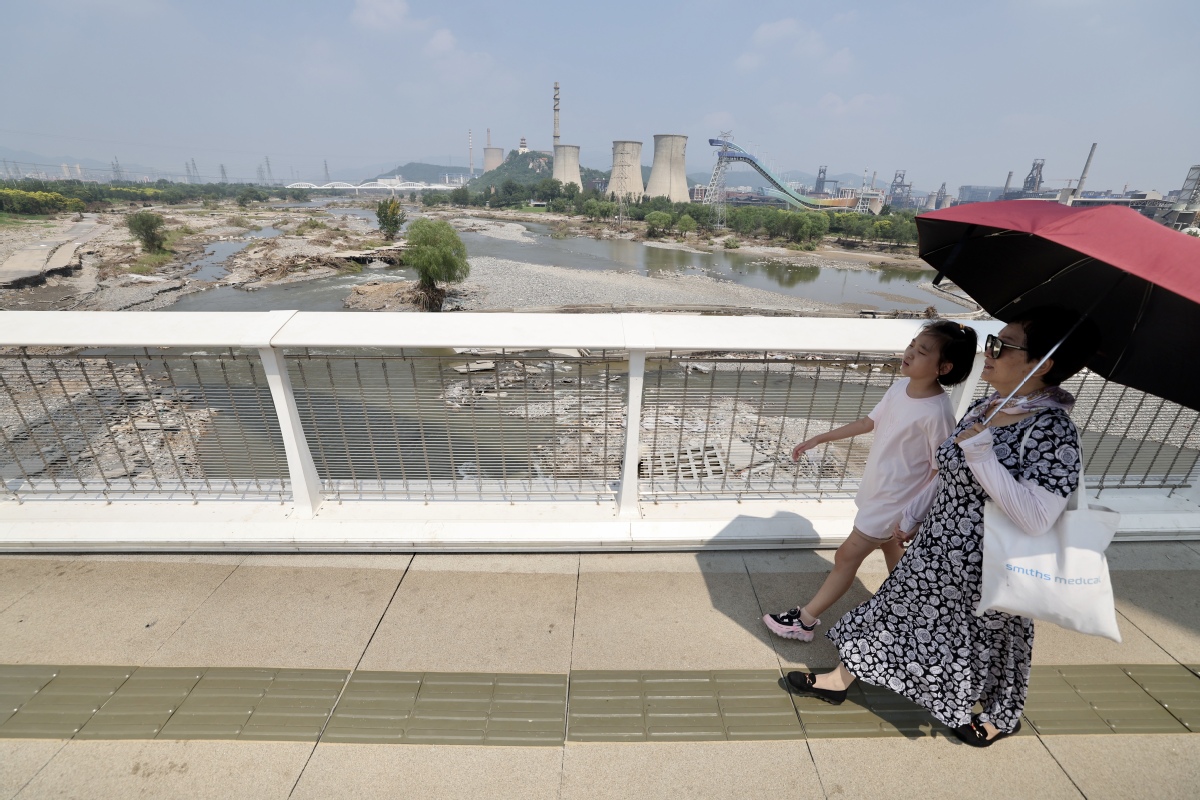
Farmers receive early payments, field drainage underway, experts sent in
Post-disaster recovery and reconstruction work is proceeding well in Wuchang, Heilongjiang province, minimizing the impact of the recent flooding, especially on local farmers' livelihoods, according to senior officials.
Vice-Premier Liu Guozhong outlined the work that needed to be done when he made a research trip to Wuchang on Sunday and Monday.
"It is necessary to organize water drainage in affected fields as soon as possible, send experts to guide farmers to carry out scientific production and self-recovery, and strive to reduce disaster losses," Liu said.
"It is also necessary to promptly repair damaged farmland, water conservancy and other infrastructure to ensure faster recovery of agricultural production."
Liu urged local governments to disperse agricultural disaster relief funds as soon as possible, settle insurance claims in a timely way, optimize credit services, and provide targeted help and support for affected business entities and farmers.
Lying in the lower reaches of the Songhua River in the south of Heilongjiang, Wuchang, a county-level city in Harbin, was hard-hit by the floods.
According to statistics provided by the city's agricultural and rural department, Wuchang has over 168,660 hectares of arable land used for growing rice, of which around 66,660 hectares have been affected by the flooding to different degrees. That is equivalent to almost 40 percent of the city's arable land.
Wuchang rice is famous for its unique flavor and texture, and is grown in fertile black soil. The province's large temperature variances between day and night help produce rice that is high in starch and low in moisture, resulting in a firm, chewy texture.
Wuchang's rice yield was 700,000 metric tons last year.
"The flooded area is mainly located in low-lying land on the riversides," Wang Shouxin, director of Wuchang Agriculture and Rural Affairs Bureau told state broadcaster China Central Television on Sunday. "Most of the high-yield paddy land is not seriously affected," he said, adding that there were no specific statistics yet on production reduction and failure.
In recent days, local governments have organized the draining of water from flooded fields. As of Monday, drainage work on 28,000 hectares of land had been completed.
In seriously affected areas, farmers are spraying foliar fertilizer to accelerate crop growth and increase grain weight. A technical assistance group has been dispatched to affected areas to give guidance on the resumption of production.
About 70 percent of the arable land in Wuchang has agricultural insurance, and insurance companies are currently assessing the impact of the disaster and registering claims.
"We will immediately make an emergency prepayment plan, which means that for large losses of land, we will make a partial payment in advance to the farmers," said Yang Guanghui, manager of the Wuchang branch of China Pacific Property Insurance. "We will make sure that the compensation is paid quickly."
Last year, Heilongjiang saw a grain harvest of 77.63 million tons, accounting for 11.3 percent of the national yield, according to National Bureau of Statistics data.
Although the province has been affected by heavy rainfall recently, very few low-lying plots of Beidahuang Agricultural Reclamation Group have been affected, Heilongjiang's Agriculture and Rural Affairs Department said on Monday.
After the flood, experts inspected the group's seedlings and found the three main crops — rice, corn and soybean — are growing normally, with good harvest conditions.
The company has nearly 3.1 million hectares of arable land, including 1.53 million hectares for growing rice.
"Before the arrival of the heavy rainfall, we had dredged canals, bridges and culverts in the farmland in advance, reduced the storage capacity of the reservoirs and prepared sufficient materials to ensure an effective response after the disaster," said Liang Daoman, general manager of the agricultural development department of the group.
"The group organized disaster prevention and reduction expert teams to carry out technical guidance in the farmlands.
"Professional workers have been sent to drain water, carry out aviation operations to prevent diseases and pests, and add nutritional elements to promote the normal growth of crops," he said. "We are striving to minimize losses and achieve a bumper harvest."

With floodwaters gradually receding in Zhuozhou, Hebei province, owners of publishing warehouses have begun tallying their losses and salvaging books not left waterlogged.
The flooding, caused by recent torrential rains, has caused estimated losses of more than 10 billion yuan ($1.37 billion) for the book industry alone in the city, with warehouses filled with soggy books.
BooksChina, one of China's biggest online booksellers, is one of many in Zhuozhou counting the costs.
The city, located to the southwest of Beijing, is home to over 100 publishing houses and has warehouses covering some 27 hectares.
BooksChina said nearly 80 percent of its warehouse stock, totaling 4 million books, has been soaked, with an estimated economic loss of nearly 300 million yuan.
Supporters of the bookseller have come to the company's aid by purchasing special "aid packages" consisting of four books, a metal bookmark and a commemorative badge. A total of more than 171,000 such packages had been sold as of Tuesday.
For less well-known publishing houses, making up for their losses is much more difficult.
Yang Yibo, a manager at Beijing Jiwen Tianxia Cultural Development Co, said employees have been working hard to clear the mud at the warehouses.
He told media outlet Jiemian the company had launched its own "aid packages" on various online platforms, which have been sold around 1,000 times.
They have also been packaging books that have not been soaked into sets, and around 300 to 500 sets have been sold, he said.
However, the money is still not enough for the company to rebuild itself.
As the company mainly sells books to schools and libraries, it is not well-known online, so it has not received much attention from netizens, Yang said.
Yang Zi, an editor at publisher Huyang Culture, said she and her co-workers have been busy trying to salvage undamaged books since Aug 7.
Most of the public attention has gone to BooksChina, and smaller brands that have sustained major losses have not got much attention, she said.
The company has lost 4 million yuan in books, equivalent to half a year of sales revenue, according to Yang Zi.
She said the company does not plan to launch "aid packages" like some others. Instead, it wants readers to focus more on the content of the books, so it will pay more attention to promoting the books it is about to launch, which is the key for its future survival.

Some residents in North China's Hebei province who suffered large losses in the recent flooding have received their first round of government compensation as targeted efforts are made to return their lives to normal.
A total of 1.19 billion yuan ($164 million) has been transferred to accounts of residents in more than 700 villages in Xingtai, Baoding, Langfang and Hengshui cities, according to Li Na, deputy head of the Hebei Department of Water Resources, Hebei Daily reported on Monday.
The first round of payments was mainly to compensate residents for their lost crops, the report said.
The villages are located in seven flood detention basins that the province uses for diverting and storing floodwaters.
A detention basin is an area that is designed or designated for the temporary or permanent retention of floodwaters. "These low-lying areas include lakes, wetlands, farms and even residential areas," Cheng Xiaotao, deputy chief engineer of the China Institute of Water Resources and Hydropower Research, told state broadcaster China Central Television earlier this month.
In the next compensation step, payments will be made in accordance with regulations for losses in other areas, including forests, breeding, properties, agricultural machinery and household durable goods, Li said.
According to the Interim Measures for Compensation Applied to Flood Detention Basins, which was rolled out in 2000 after being approved by the State Council, crops in detention areas damaged by flooding will be compensated by 50 percent to 70 percent of the farmland's average annual output value based on the previous three years' output.
Other areas are regulated and receive a range of compensation. For example, damaged properties will be compensated by 70 percent, according to the interim measures.
The Ministry of Finance and the provincial financial department have also allocated 1.15 billion yuan in emergency relief funds to be used for the relocation of disaster-affected people and the restoration of damaged houses, Hebei Daily reported.
"I didn't expect the compensation could be given to us so quickly," said Wu Erhei, a resident in Wuzhuang village in Xingtai.
Wu received a text message on Sunday notifying him that the money had been transferred to his bank account. He lost corn crops grown on more than 1.6 hectares of farmland.
Zhou Yongwei, the Party chief of Fenghuazhuang village in Xingtai, said around 56 hectares of farmland in the village had been affected by the floodwaters, ruining crops in the fields.
A total of 106 farmers in the village have received compensation for their crop losses, Zhou said.
"With the compensation, we have gained more confidence to rebuild our homes," Zhou told Hebei Daily.
He added that after the floodwaters receded, villagers had started cleaning up mud and are gradually recovering from the disaster.
Wu, from Wuzhuang village, said: "I have been plowing the fields in recent days after the floodwaters receded. I have bought cabbage seeds and will plant them as soon as possible to make up for the loss."
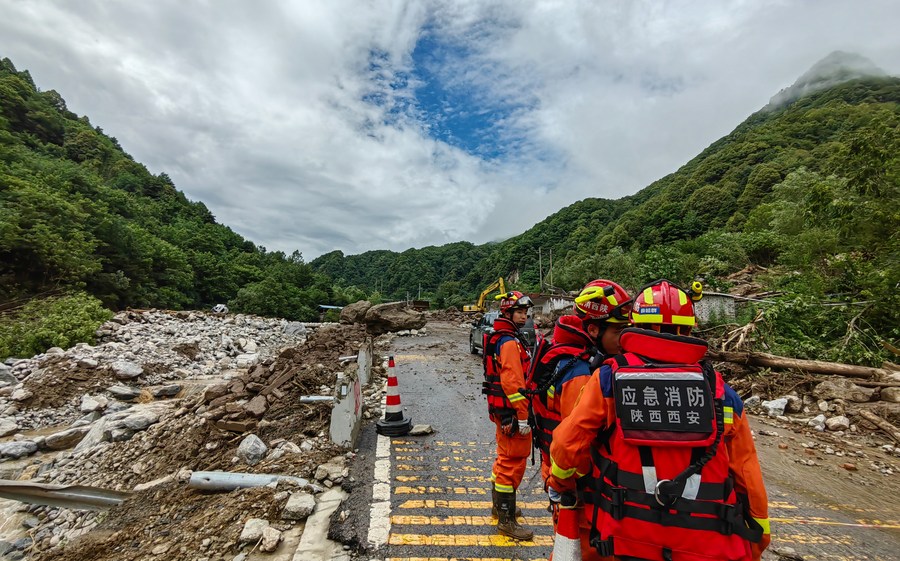
BEIJING -- Chinese authorities on Monday held a video conference to discuss the country's rain, flooding, drought and geological disaster situations.
The meeting was co-organized by the office of the State Flood Control and Drought Relief Headquarters and the Ministry of Emergency Management, and was joined by the China Meteorological Administration, the Ministry of Water Resources and the Ministry of Natural Resources.
Severe mountain torrents and mudslides have occurred recently in multiple parts of China, according to the meeting.
Parts of the main stream of the Songhua River and the Haihe River Basin continue to run at relatively high water levels in their descending stages, and dikes in Hebei and Tianjin are in a critical period of flood control, it said.
Heavy rainstorms are lashing the south of the country, while drought is evolving in northern regions including Gansu and Xinjiang, the meeting said.
It noted that flood control and drought relief situations remain grim for China.
The meeting urged authorities to make good use of various flood control methods and rescue and relief forces to strengthen inspection and defense procedures for river embankments. It also urged authorities to ensure good work in the resettlement of people affected by the extreme weather.
Gansu, Xinjiang and other drought-stricken areas should take close care to undertake their responsibility to combat drought at all levels, and make scientific use of various water resources.
On Monday, Chinese authorities dispatched 20 large drainage pumps and other emergency relief supplies to Tianjin to support the municipality's flood control and drainage work.
The State Flood Control and Drought Relief Headquarters has maintained a third-level flood control emergency response in Beijing, Tianjin and Hebei, and working teams and expert groups are continuing their on-site support for flood control and rescue work in Tianjin and Hebei.

Some residents of Hebei province who suffered great losses in the recent flooding disaster have received their first round of government compensation as every effort is made to help them return to normal production and order of life.
A total of 1.19 billion yuan ($164 million) has been transferred to accounts of residents in more than 700 villages in cities of Xingtai, Baoding, Langfang and Hengshui, according to Li Na, deputy head of the Hebei Department of Water Resources, according to a report by Hebei Daily on Monday.
The villages are covered by seven flood detention basins that the province has used for diverting and storing floodwaters.
The payments were mainly to compensate the residents for the loss of ruined crops in the basins, the report said.
In the next step, compensation will be paid for losses in other areas, including forests, breeding, properties, agricultural machinery and household durable goods, Li said.

BEIJING -- China will enhance credit support for infrastructure reconstruction and upgrading in disaster-stricken areas to help people and businesses tide over difficulties, the National Administration of Financial Regulation said on Monday.
Transportation, telecommunication, gas and power supply, water conservation, and waterlogging prevention projects will be provided more lending support, the NAFR added.
Banks are encouraged to develop special credit products to help small and micro companies, individual businesses, farming and breeding enterprises, and rural households in the affected areas, according to the NAFR.
Insurance companies are encouraged to provide long-term capital for key projects in infrastructure and public services, the NAFR said.
It has called on financial institutions across the country to address the needs of those in the disaster-hit areas to mitigate the impact of flooding on social and economic development and people's lives.

More than 33,300 residents of Tianjin's Wuqing and Beichen districts who had been transferred to safe areas in the wake of flooding caused by Typhoon Doksuri in late July, have now returned to their hometowns.
They were the first group of residents to be relocated and have been trickling back home since Friday. Tianjin relocated and resettled 86,484 residents.
The red alert was lifted on Monday morning for the Yongding River, one of the three estuaries affected by the large flood in the Haihe River since late July.
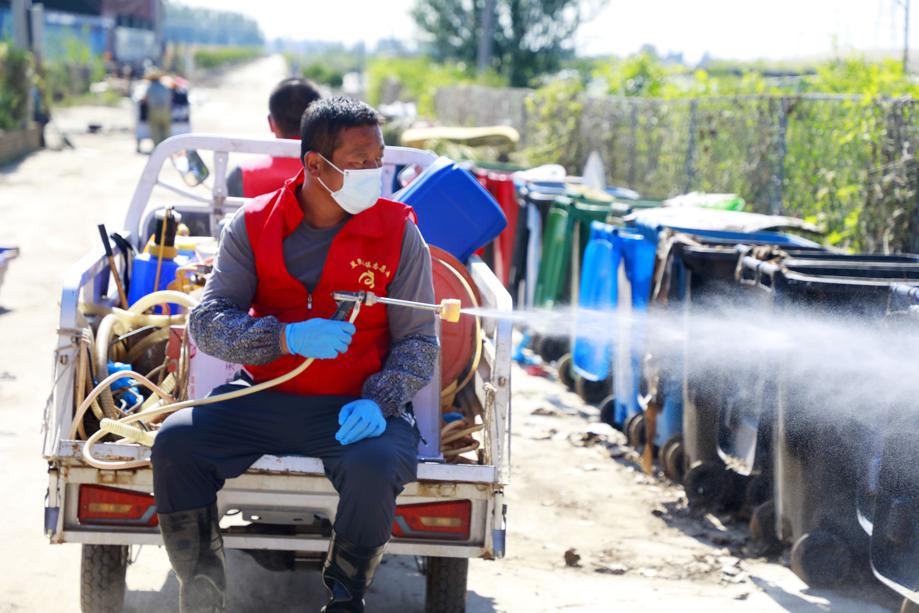

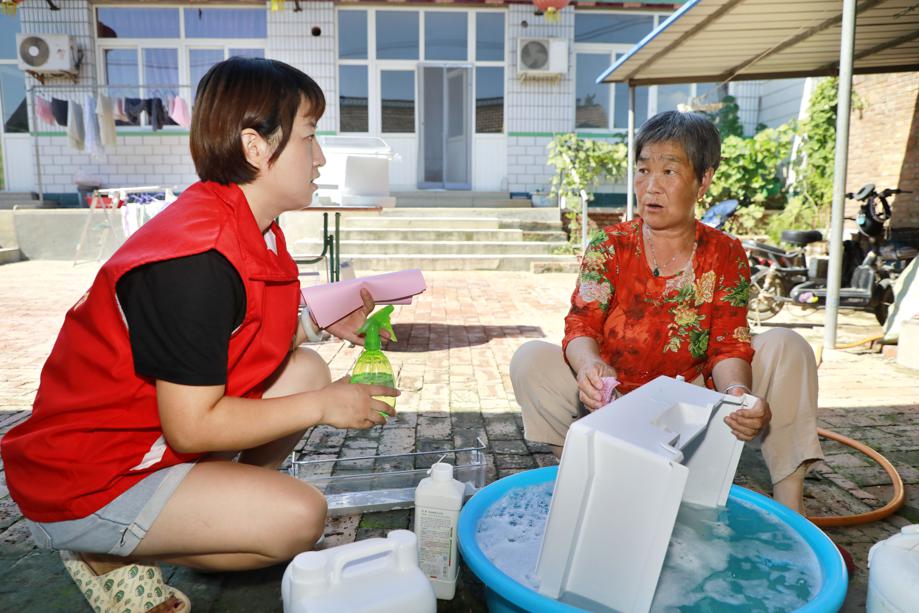
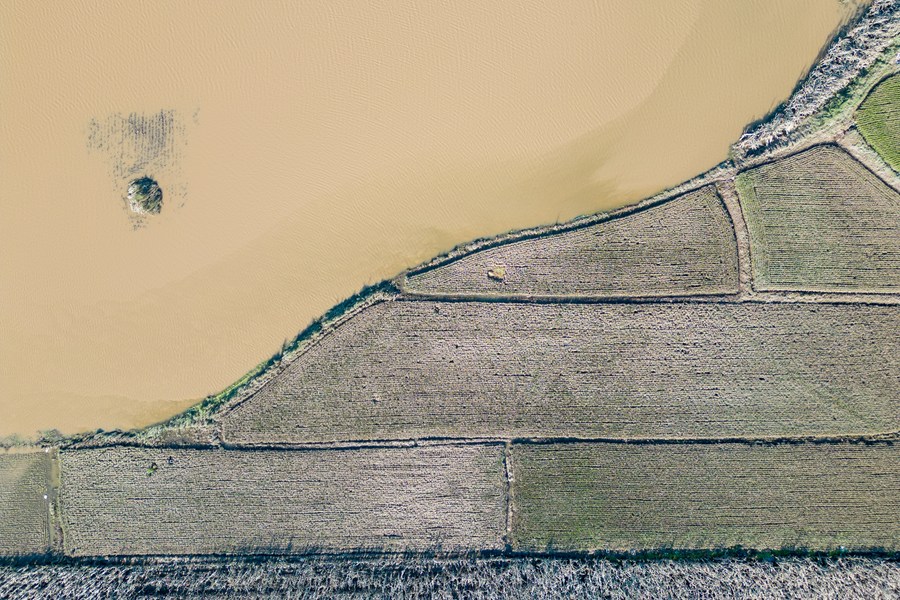
Southern provinces less affected by the latest round of flooding are being called upon to step up vegetable production this winter using idled farmlands and increase the shipping of greens to the north to fill in the gap of supply that could possibly be induced by heavy deluges affecting large areas in the north, according to Ministry of Agriculture and Rural Affairs.
In a media release on its website, the ministry on Monday urged immediate efforts to drain flooded fields as part of broader attempts to stabilize vegetable supply this winter, saying that the heavy downpours induced by typhoon Duksuri have caused serious flooding in areas including North China, Northeast China and the grain growing areas to south of the lower reaches of Yellow River.
"The flooding has submerged vegetable-growing facilities and fields, exerting adverse impact on vegetable production in certain regions," the ministry said, adding that greens are essential to people's livelihoods and stabilizing prices and therefore the utmost efforts are entailed in areas of production, sales, transportation and quality control to ease such impacts.
Local authorities should speed up draining flooded fields in preparation for the upcoming planting season for legumes, it said. For heavily hit lands that are unfit for planting in the foreseeable future, authorities are asked to organize farmers to grow seedlings in nursery gardens first and transplant them to fields when fields are fully prepared. Efforts are also called for reinforcing greenhouses and spraying disease-prevention drugs.
Farmers must make full use of the sunny days to prepare the fields and prepare fertilizers and other farming materials, so that they can seize the window for the upcoming planting season, the ministry said.
To bolster revenue, authorities are also asked to analyze the market and prevent farmers from growing identical green varieties that could hit the market at the same time, it added.
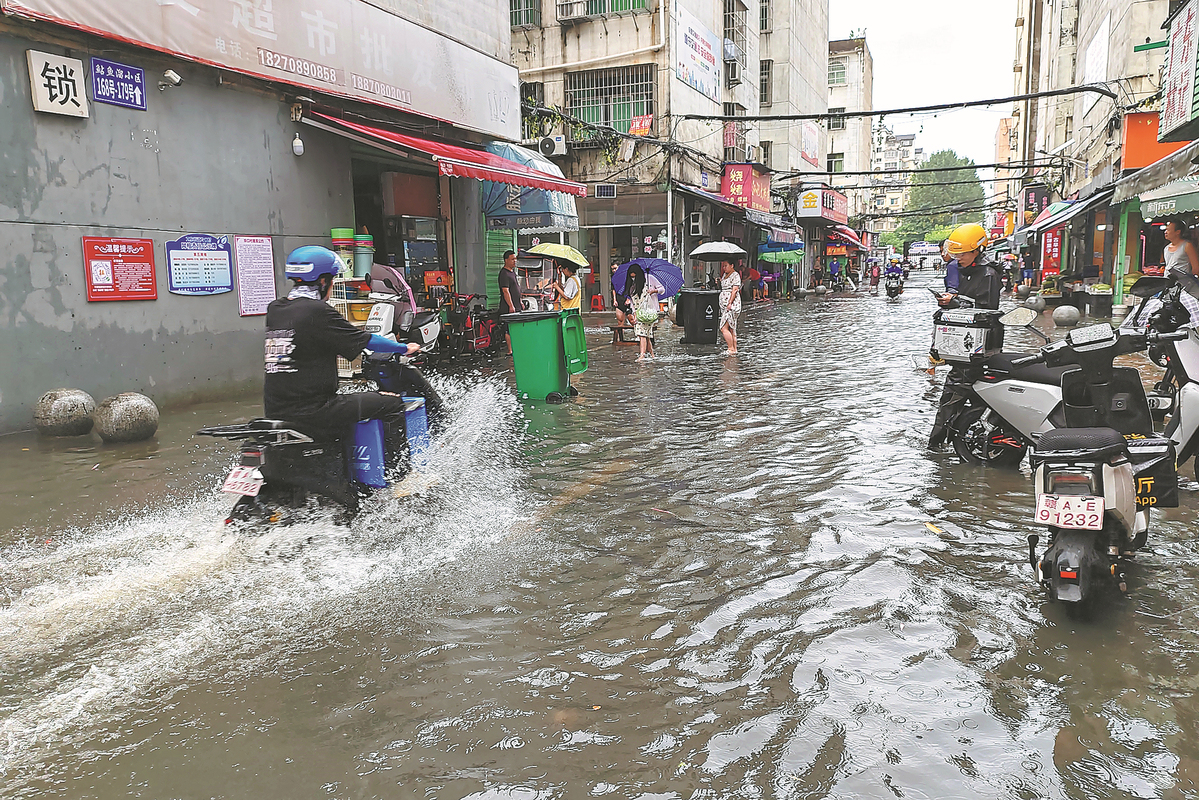
Northeast stays on alert as strong winds, heavy rains expected in coming days
Measures have been taken to limit flooding in Tianjin and the northeastern provinces of Liaoning, Jilin and Heilongjiang after Typhoon Khanun made landfall in Liaoning on Friday, the Ministry of Emergency Management said on Sunday.0
On Friday and Saturday, the ministry and the National Food and Strategic Reserves Administration dispatched rescue and relief supplies such as drainage pumps to Tianjin and Hebei province.
The ministry highlighted the need for being prepared for potential risks and hidden dangers in the Beijing-Tianjin-Hebei region and Northeast China.
As the coming days may see further risks such as strong winds and heavy rain in certain areas, authorities are closely monitoring the situation.
Although Khanun has been downgraded, its remnants are still expected to bring heavy rainfall to Northeast China, worsening the river flood situation, the ministry said.
In the next three days starting from Sunday, there is a risk of heavy rain and potential disasters such as flash floods, geological hazards and agricultural waterlogging in Heilongjiang, Jilin, Liaoning and Qinghai provinces, as well as in the Xinjiang Uygur autonomous region, the National Meteorological Center forecast.
The downstream river channels in the Haihe River Basin and the main stream of the Songhua River continue to maintain high water levels, increasing the risk of dangerous situations due to prolonged water exposure, the ministry said.
The Dalian Flood Control and Drought Relief Headquarters in Liaoning issued a flood warning on Friday. Swimming, fishing and boating in reservoirs and rivers have been banned. In particular, caution has been advised when encountering flooded underpasses, tunnels or culverts while driving.
Southwest and northwest regions are also facing risks such as torrential rains, mountainous geological hazards and flooding, as well as potential dangers associated with reservoirs and dam failures, the ministry said.
It is a critical period for crop production in Northeast China. In the coming days, the areas affected by the wind and rain will overlap with previous flooded areas, which will aggravate the waterlogging. Strong winds can cause crops such as corn to fall down.
As of Wednesday, more than 370,000 people have been affected by rain caused by typhoons Doksuri and Khanun in Heilongjiang, and 258,000 hectares of crops have been flooded, the provincial emergency management and agriculture and rural affairs department said.
Chinese authorities on Sunday held a video conference to discuss the rain, water and geological disaster situations in the country, as well as the potential influence and impact of the typhoons.
Co-organized by the Office of State Flood Control and Drought Relief Headquarters and the Ministry of Emergency Management, the meeting urged relevant provinces to beef up patrol, defense and emergency rescue forces, scientifically investigate and eliminate risks, and speed up the restoration of embankments.
China has maintained a level-II emergency response to flooding in Tianjin, a level-III emergency response to flooding in Beijing, Hebei, Heilongjiang and Jilin, and a level-IV emergency response to flooding in Liaoning.
The working teams dispatched in the early stages will continue to assist with local flood and typhoon prevention measures in the aforementioned areas.
Xinhua contributed to this story.

At least 21 people have been killed and six are missing after a flash flood and landslides triggered by heavy rain struck Weiziping village in the outskirts of Xi'an, capital of Shaanxi province in Northwest China, according to the city's bureau of emergency management on Sunday.
The disasters struck Weiziping in the Chang'an district shortly after 6 pm on Friday. The village is located on the northern slope of the Qinling Mountains.
Two residential houses in the village were destroyed, and roads, bridges, power supply equipment and other infrastructure were damaged.
A local restaurant owner said it was dinnertime when the torrential rain hit, and some tourists were swept away by the sudden flood.
A woman surnamed Wu, who runs a homestay business in the village, told reporters that she has not received any information from her family about their safety, and she is still waiting for updates from rescue personnel.
Emergency records show that the Xi'an meteorological center issued an orange alert, the second highest in China's four-tier color-coded warning system for rainstorms, at 12:35 pm on Friday, and upgraded the alert to the highest level three hours later.
A team of more than 100 rescue personnel that arrived at the site on Friday night had relocated 81 people and searched 65 kilometers of river bank by Sunday morning, according to news reports.
By Sunday afternoon, the authorities had dispatched nearly 1,000 rescuers to the village and relocated 186 people. Most of the damaged infrastructure, including electricity and telecommunications, has been repaired and reopened for service, according to the city's emergency authorities.
The province's Party Secretary Zhao Yide and Governor Zhao Gang arrived at Weiziping on Saturday to lead rescue and disaster relief efforts.
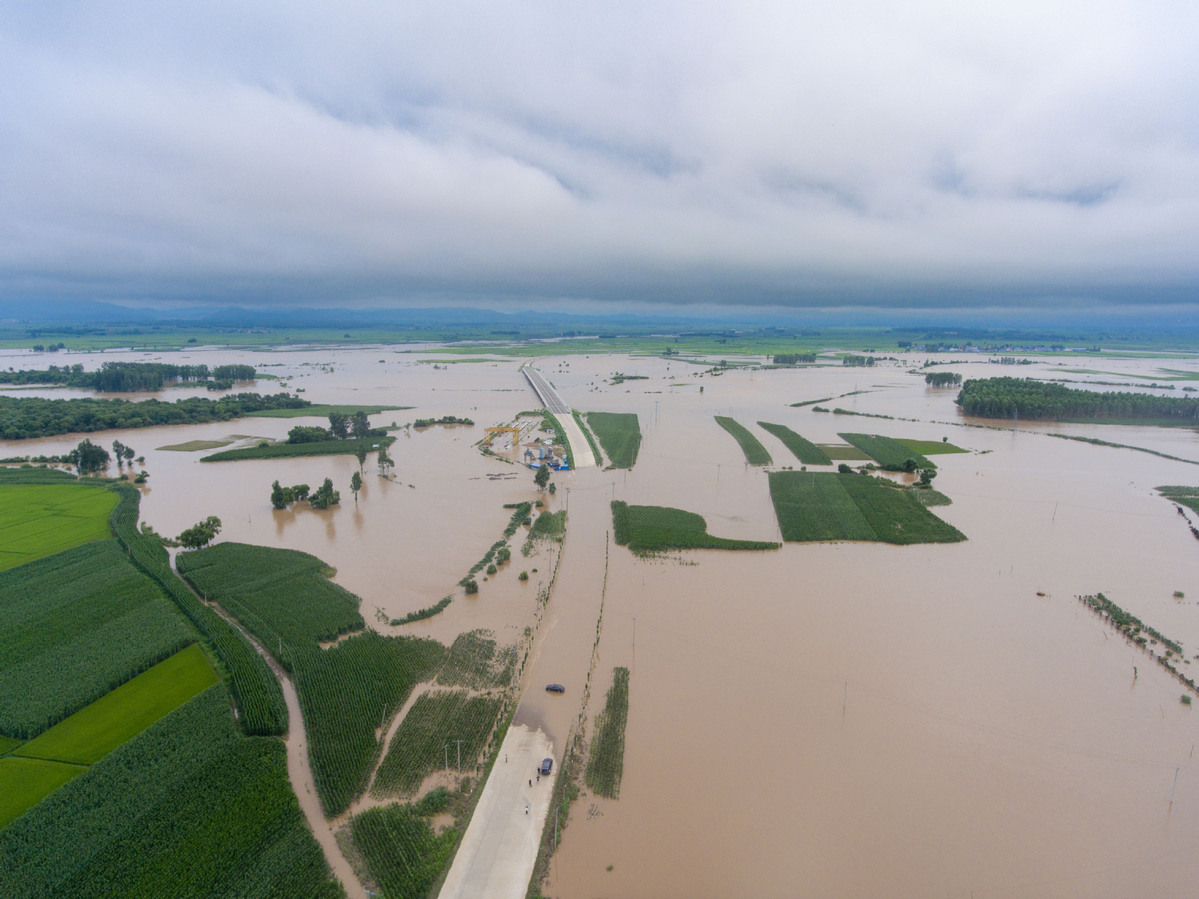
BEIJING -- Chinese authorities on Saturday held a video conference to discuss the rain, water and geological disaster situations, as well as the residual influences of Typhoon Khanun.
The meeting was co-organized by the office of the State Flood Control and Drought Relief Headquarters and the Ministry of Emergency Management, and was joined by the China Meteorological Administration, the Ministry of Water Resources and the Ministry of Natural Resources.
The meeting made arrangements to guard against floods and typhoons, especially in key places such as Tianjin, Liaoning, Jilin and Heilongjiang.
The meeting noted that the flood control situation is still very grim for China.
Flood storage and retention areas, as well as the downstream of the Haihe River Basin and the main stream of Songhua River continue to run at high water levels, and the risk of hazardous conditions is gradually increasing, driven by the long-term immersion of dikes, it said.
The residual circulation of Typhoon Khanun could still bring strong rainfall to northeast China, according to the meeting.
The latest rainfall in north China may aggravate the floods, complicating local emergency rescue and disaster relief work, it said.
Frequent strong rainfall in southwest and northwest China adds risks of geological disasters, and poses danger to reservoirs and dams, it added.
The meeting stressed that relevant provinces should maintain a high degree of vigilance, be ready for battle, and work tirelessly to do a good work in flood control and disaster relief.

BEIJING -- China on Saturday evening issued an orange alert for mountain torrents.
From 8 p.m. Saturday to 8 p.m. Sunday, mountain torrents are highly likely to occur in certain areas of Liaoning and Jilin, northeast provinces of China, according to the orange alert issued by the Ministry of Water Resources and the China Meteorological Administration.
The two departments also issued a yellow alert for mountain torrents in eastern parts of Liaoning and southern areas of Jilin.
Local authorities are advised to strengthen real-time monitoring and flood warning procedures amid measures to prepare for evacuation.
China has a four-tier weather-warning system, with red representing the most severe warning, followed by orange, yellow and blue.

Mudslides and flooding in Xi'an, capital of Northwest China's Shaanxi province have killed two people and have left a further 16 others missing, Xinhua News Agency reported on Saturday, citing local emergency authorities.
The disaster hit Weiziping village, Chang'an district of the city, shortly after 6 pm on Friday. Four trapped people have been rescued.
Two houses in the village have been washed away and infrastructures such as roads, bridges and power supply facilities has been damaged.
Search and rescue teams, and river bank reinforcement personnel have been sent to the area.
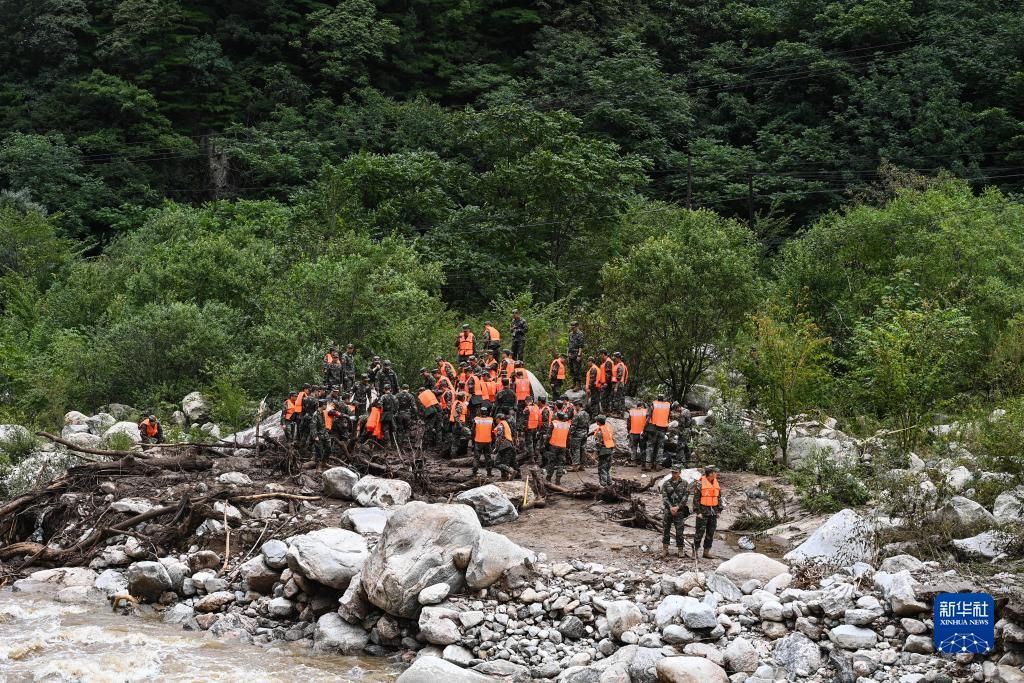


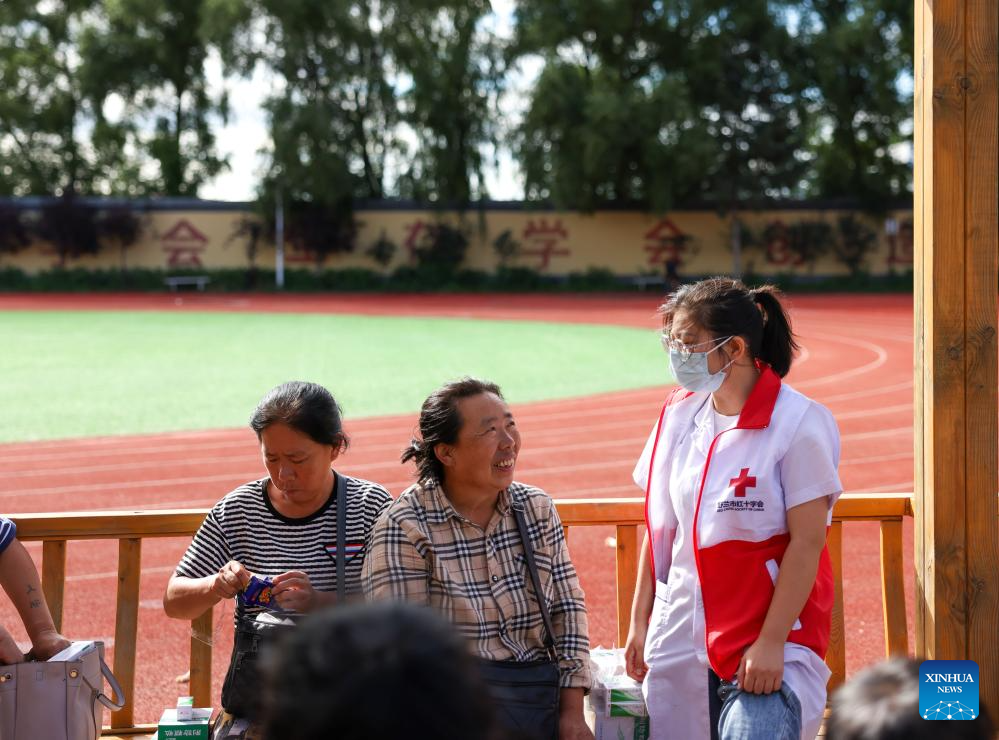
CHANGCHUN/SHENYANG -- Typhoon Khanun, the sixth typhoon of this year, threatens to pack torrential rains and disrupt passenger train services in China's northeastern provinces Saturday and Sunday, local authorities said.
The meteorological bureau of Jilin Province has forecast heavy rain in seven cities, including the provincial capital Changchun. The central and southern parts of the province expect more precipitation, with a maximum volume of 40 millimeters per hour, it warned.?
The typhoon weakened into a tropical low pressure when it made landfall in the coastal region of Liaoning Province on Friday night, but strong gales and heavy rain will continue to lash the province over the weekend, the local weather bureau said.
The coastal city of Dalian has forecast strong gales up to 88 km per hour on Saturday and Sunday. The city's flood control headquarters have also warned of flash floods and geological disasters.
More than 20 passenger trains will be suspended on Saturday and Sunday, including two from Beijing and one from Qingdao in the eastern Shandong Province, according to railway authorities in Liaoning's capital Shenyang.
Heilongjiang Province is also on rain and flood alert, as six rivers and three reservoirs have seen water levels surpassing flood alarms as of 8 a.m. Saturday.
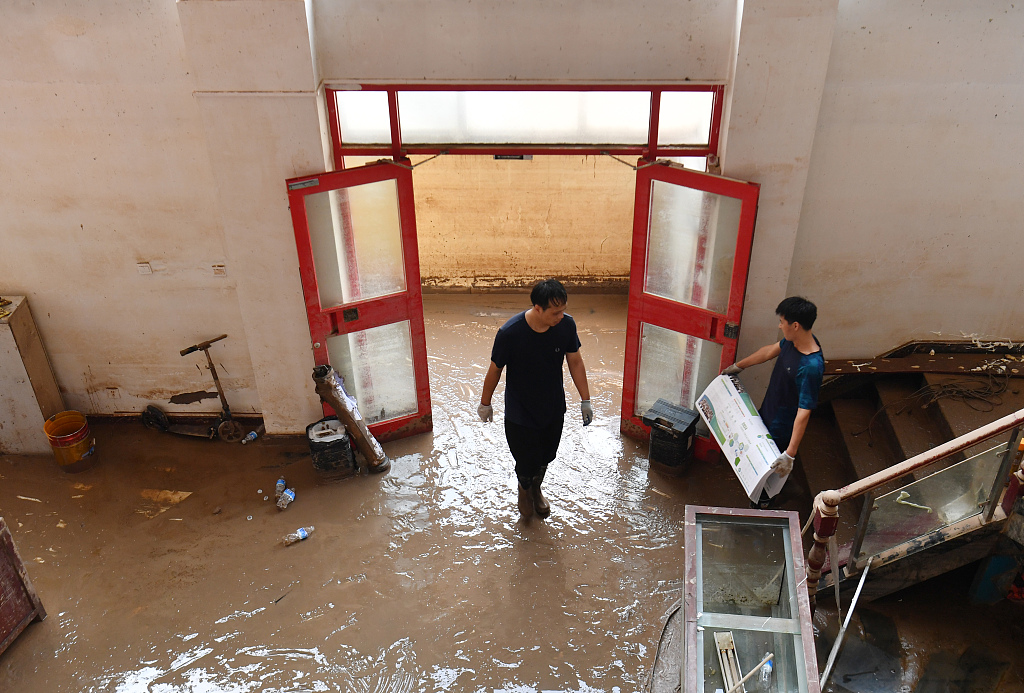
North China's Hebei province is set to undergo a two-year reconstruction effort following the recent downpours and devastating flooding that led to 29 deaths and 16 still missing, according to senior local officials on Friday.
"We will make concerted efforts to rebuild our homes together step by step," Zhang Chengzhong, head of the province's flood control and drought relief headquarters, said at a news conference on Friday, adding that rescue workers are still searching for the missing people.
Zhang, also vice-governor of Hebei, said that all students affected by the flooding will return to school as scheduled for the upcoming semester, while people relocated from flood-prone areas will either return home or relocate to new homes before winter arrives.
Before the next flood season, which usually runs from July to August, the province will complete reconstruction of damaged or ruined flood-control public works, and all reconstruction will be finished in time, he said.
The province will also carry out analysis of causes behind the severe damage in order to enhance the drainage and waterproofing systems, said Jia Letang, deputy head of the Hebei Development and Reform Commission, during the news conference.
During reconstruction work, flood control projects will be planned reasonably in order to improve the infrastructure's anti-flood effectiveness and avoid repeat disasters, Jia said.
Triggered by Typhoon Doksuri, Hebei suffered heavy downpours from July 27 to Aug 2, and during the period, the amount of rainfall in Hebei was equivalent to 27.5 billion cubic meters of water.
As of Thursday, more than 3.8 million people in 110 county-level regions in the province were affected, and more than 1.7 million were evacuated with most relocated to temporary shelters.
The flooding also destroyed a number of power, water, transportation and communication facilities. "Most of these have been repaired and the rest are in the process of rapidly returning to working order," Zhang said.
The province's direct economic losses from the flooding reached 95.8 billion yuan ($13.2 billion).
Among flood recovery measures, the province began using seven flood detention basins, including Langouwa and Dongdian, successively since earlier this month.
"The number of detention basins put into use is the most since 1963," Zhang said, adding that the measures have effectively reduced pressure on downstream waterways.
As of Thursday, the basins have helped divert and store 4.12 billion cubic meters of floodwaters, submerging a maximum area of 1,399 square kilometers, said Cui Zhiqing, head of the province's water resources department.
Flood detention basins are part of the province's flood control system together with reservoirs, river channels and dikes, Cui said, adding that Hebei has 13 such basins.
Currently, the water levels in these basins are receding and the process is speeding up.
Cui added that people will then be compensated according to regulations for their losses for such assets such as crops, animals and property damaged or lost in the disaster.
"All the things I have protected over the years are gone, and now I need to start from scratch after the flooding," said local Sun Zhan on Thursday, staring at his destroyed home in Wanghaizhuang village, Zhuozhou city — one of the hardest-hit places in Hebei.
Sun harvested over 6,000 kilograms of wheat and had spread them out to dry in his yard before the floodwaters arrived.
He sold them on Thursday, for less than 0.8 yuan per kg, as feedstuff for cattle. "I could sell them for about 2.8 yuan per kilogram if they were not soaked," the 46-year-old farmer lamented.
During the flooding, he also lost his home, which collapsed, and he has reported his losses to the local government, which is collecting the information for future compensation.
"But we still have hope as long as we are alive," Sun said.
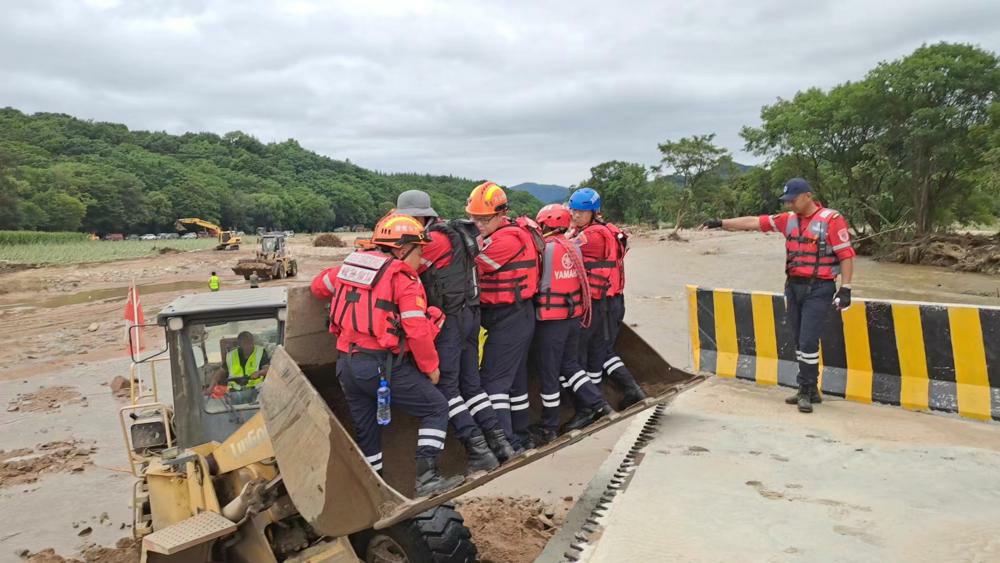
CHANGCHUN -- A total of 23,000 residents in Shulan, a city in northeast China's Jilin Province, have been evacuated to escape flooding caused by heavy rainfall due to Typhoon Khanun.
The residents are from 20 different townships, and more than 4,000 of them have already been transferred to 62 makeshift venues since Wednesday, according to the city's flood control headquarters.
The headquarters issued an emergency circular on Thursday, requiring the flooding areas near the related rivers, low-lying zones of townships and the areas prone to mountain torrents and geological disasters to evacuate residents in advance.
Shulan has experienced continuous rainy weather since Aug. 1, leaving at least 14 people dead.
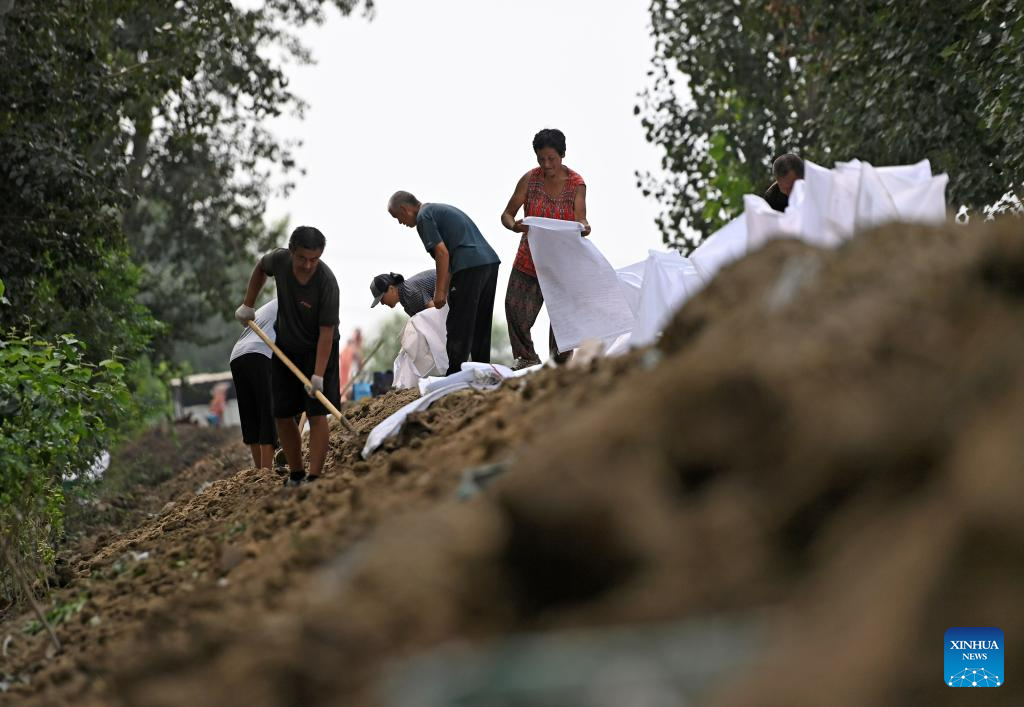
BEIJING -- Chinese authorities have intensified flood relief and reconstruction efforts, working tirelessly to swiftly restore normalcy to the lives and production of flood-affected regions.
China on Friday earmarked 1.46 billion yuan (about 204 million U.S. dollars) to provide relief to people severely affected by recent floods and ensure their basic needs are met, according to the Ministry of Finance and the Ministry of Emergency Management.
The funds will be allocated to five provincial-level regions: Beijing, Tianjin, Hebei, Heilongjiang and Jilin.
Together with the funds already allocated, the central government has earmarked a total of 7.74 billion yuan for flood control and relief since the beginning of this year's flood season.
Local governments can channel these funds toward disaster relief, immediate emergency response, revitalizing agricultural production, and restoring damaged water conservancy facilities and other essential infrastructure.
In response to the ongoing flood season, the Ministry of Ecology and Environment has called for heightened vigilance in monitoring and safeguarding drinking water sources to guarantee the continued safety of drinking water for all.
Torrential rainstorms and floods have wreaked havoc in north and northeast China in recent days, killing 29 people in Hebei Province as of Thursday.
In the face of the unfolding emergency, China's state-owned enterprises have sprung into action to support rescue operations, dispatching rescue workers, equipment and vehicles. Their efforts have helped reinforce river embankments, repair roads, relocate residents, and restore power and communications facilities.
The China Development Bank said Friday that it had issued emergency loans of 865 million yuan to support post-disaster reconstruction in flood-hit areas.
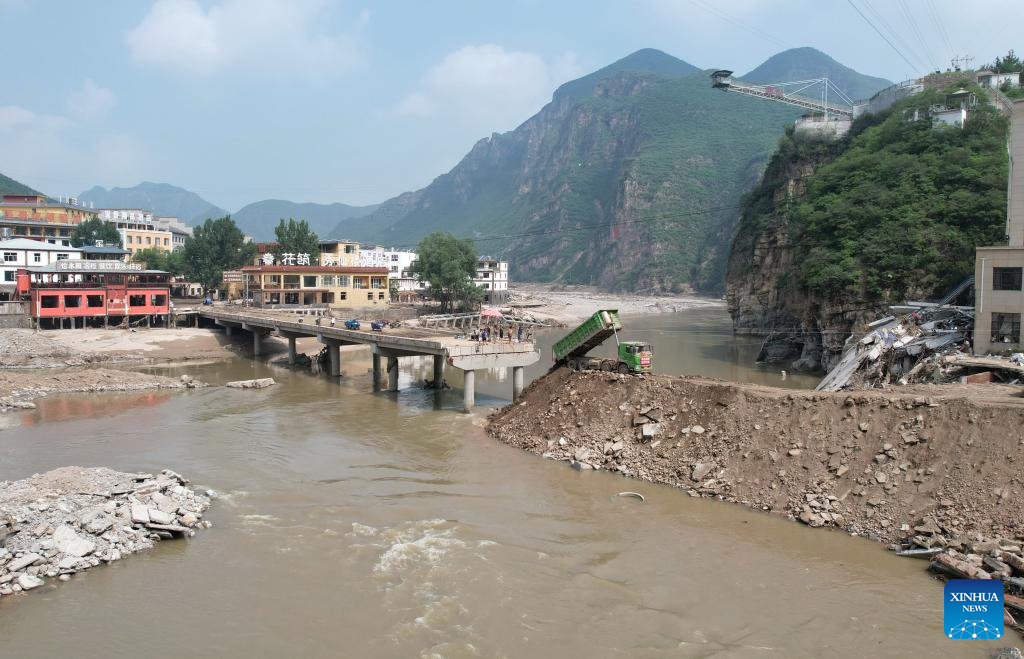
SHIJIAZHUANG -- North China's Hebei Province activated a Level III emergency response for major meteorological disasters at 11:00 a.m. on Friday as a new round of torrential rain is expected to lash the province from Friday to Saturday, local authorities said.
The provincial meteorological observatory continued to issue a yellow alert for heavy rain at 5:26 p.m. on Friday. Some parts of Hebei Province are expected to see heavy rainfall, with precipitation amounting to 200 millimeters from Friday afternoon to Saturday daytime.
China has a four-tier weather warning system, with red representing the most severe warning, followed by orange, yellow and blue.
Hebei is currently in a critical period for flood control, disaster relief, and post-disaster reconstruction. The area of upcoming heavy rainfall partly overlaps with the previous area of heavy precipitation and is accompanied by severe convective weather such as short-term strong winds and heavy rainfall, posing a high risk of disasters, according to local authorities.
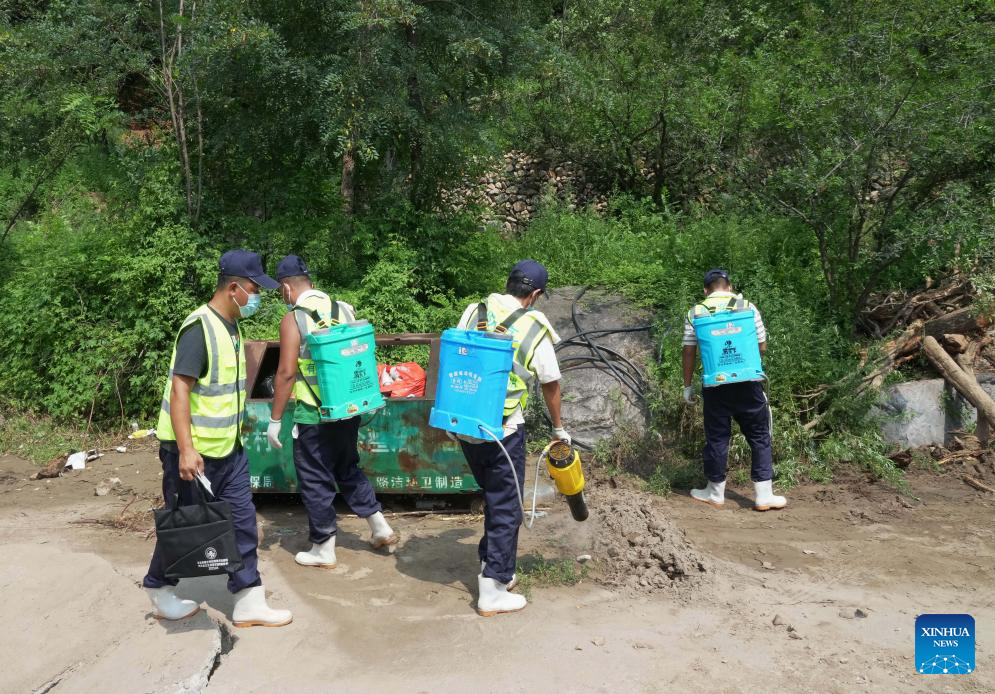
Hebei province is set to undergo a two-year reconstruction effort following significant damage caused by the recent heavy downpours and flooding.
In anticipitation of the next flood season, which usually spans from July to August, the province aims to complete the restoration of flood control facilities destroyed by floodwater, according to Zhang Chengzhong, head of the province's flood control and drought relief headquarters. His statements were made during a news conference Friday morning.
Before the flood season in 2025, all reconstruction work will be finished, he added.
Zhang, also vice governor of Hebei, said all students that have been affected by the flooding disaster will go back to school as scheduled for the upcoming semester, and residents that were relocated from flood-prone areas will either return home or relocate to new houses before winter arrives.
"We will ensure that order in work and life for the disaster-hit people will be basically restored before winter this year," added Jia Letang, deputy head of Hebei Development and Reform Commission.
According to Jia, the province will conduct an analysis of causes of the damage, in order to enhance the drainage and anti-waterlogging systems.
During the reconstruction work, the flood control projects will be planned rationally in order to improve the infrastructure's anti-flood capability, and thus effectively avoid repeated disasters, Jia said.
Several flood detention areas in Hebei province helped divert and store 4.12 billion cubic meters of floodwater since they were put into use earlier this month, local authorities said on Friday.
The province was hit hard by flooding last week as a result of heavy downpours triggered by Typhoon Doksuri.
To effectively divert and slow the rise of rivers, Hebei employed seven flood detention areas, including Langouwa and Dongdian.
"The number of detention areas put into use is the most since 1963," Zhang Chengzhong, head of the province's flood control and drought relief headquarters, said at a news conference on Friday morning. The measure effectively reduced pressure on downstream river channels.
Flood detention areas are part of the province's flood control systems, together with reservoirs, river channels and dikes, according to Cui Zhiqing, head of the province's water resources department. He added that Hebei has 13 such areas.
Floodwaters had submerged around 1,399 square kilometers, Cui said. However, the water is receding.
People will be compensated their losses of crops, animals, forests, properties, machinery and other major assets that were ruined in the disaster, Cui added.
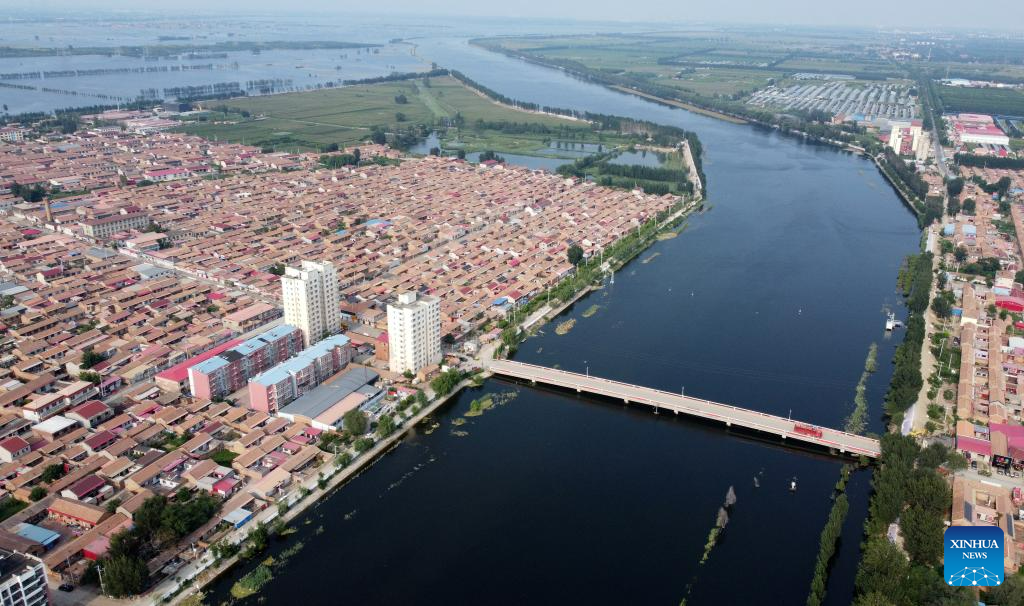
BEIJING -- China on Friday earmarked 1.46 billion yuan (about $203.95 million) to provide relief to people severely affected by recent floods and ensure their basic livelihoods, according to the Ministry of Finance and the Ministry of Emergency Management.
The funds will be allocated to five provincial-level regions: Beijing, Tianjin, Hebei, Heilongjiang and Jilin.
Together with the funds already allocated, the central government has earmarked a total of 7.74 billion yuan for flood control and relief since the beginning of this year's flood season.
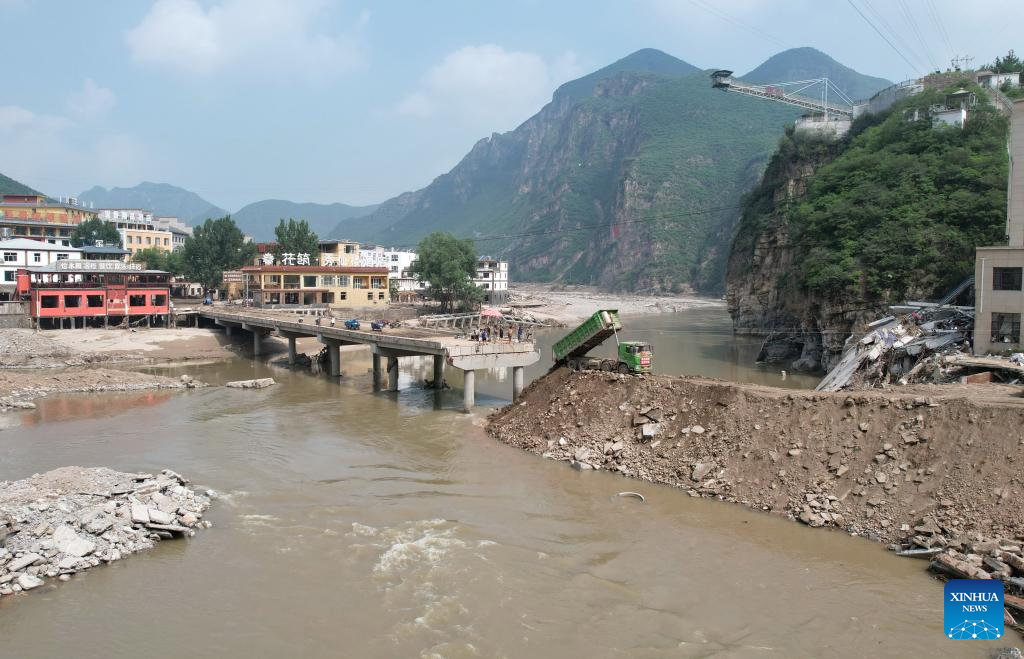
As of Thursday, the recent heavy rainstorms have affected 3.88 million people in 110 counties and districts in Hebei province and resulted in 95.81 billion yuan ($13.25 billion) in direct economic losses, according to authorities in a news conference on Friday.
Based on preliminary statistics, the flood damaged 319,700 hectares of farmland. Besides, 40,900 houses collapsed and 155,500 more were severely damaged. It also damaged 1,150 kindergartens, primary and middle schools, and 1,871 medical institutions.
Transportation, electricity, communication, and water conservancy infrastructure in the disaster-stricken areas were in ruins, authorities said during the news conference.
The overall loss is still being verified and calculated.

As of Thursday, 29 people were killed and another 16 people were still missing in disasters triggered by torrential rains in Hebei, according to data released in the news conference on Friday morning.
Among the 29 deaths, six were previously reported as missing persons.
Rescue efforts are underway for the 16 missing people, according to authorities at the conference, which was a briefing on the flood and follow-up works held in Shijiazhuang city.
During the recent round of torrential rains, the total precipitation in Hebei province reached 27.5 billion cubic meters and, in certain areas like in Baoding, Shijiazhuang and Xingtai cities, the precipitation in 24 hours exceeded 400 millimeters, authorities said.
Tengfei Street in Zhuozhou, Hebei province, was cleared of floodwaters on Thursday after being inundated with deep water last week. Vehicles are now able to pass through the street normally, the local government said.
Three million cubic meters of water had been drained.
Meanwhile, local government personnel have carried out sludge cleaning and sweeping to return cleanliness. All major roads and streets in the city have resumed normal traffoc operations.
With the roads going back to normal, some residents who had been evacuated are gradually going back home.
The city moved more than 140,000 residents during the disaster. More than 470,000 people were affected by the flood, out of a total population of 700,000.
In Wanghaizhuang village in Diaowo town, main roads have been cleaned up and residents carried disinfectant to their homes on Wednesday, according to a report by chinanews.com.
To make the recovery more convenient for residents, the village has organized more than 100 volunteers to do the work of cleaning and disinfecting since Tuesday, the report said.
Of the city's 402 villages, 211 were flooded to some degree. All of the floodwater has now receded, according to the authorities.
More than 37 million square meters have been disinfected so far, accounting for 90.5 percent of the total area that needs disinfecting, it added.
Most of the cities' residential communities and villages now have access to electricity, and about 55 percent of them have culinary water now. Base stations for communications will all resume normal operations by Tuesday, the authorities said.
[Video by Yang Shaobo/For chinadaily.com.cn]
An inflatable boat was pierced by sharp objects under the water about a week ago as it was being used by a rescue team to evacuate residents from a flooded building in Zhuozhou, Hebei province, a city hit hard by recent heavy rainfall and flooding.
Lu Mei, 52, director of the Tianlong Rescue team from neighboring Shanxi province, said, "It was fortunate that the vessel didn't deflate before two of our rescue team brought several residents to safety."
The team, comprising more than 190 members, rushed to Zhuozhou on Aug 1 after hearing that people were trapped at home after their properties were partly submerged in floodwater, Lu said.
The team used 34 inflatable boats and a dozen drones, among numerous other items of equipment, to carry out rescue missions in the city.
As of Sunday, it had helped the local authorities evacuate more than 2,800 residents. The team had also taken part in 50 missions to transfer relief supplies.
"We are glad to provide help during the disaster, because saving people is our only desire and mission," said Lu, who founded the civilian rescue team in 2010. The team is registered with the Department of Civil Affairs in Shanxi.
However, the fact that vessels can be pierced worried Lu, as it is hard for the helmsmen to notice, let alone avoid, sharp objects in murky floodwater.
"I feared more boats would be damaged, and that this would affect our rescue mission," she said.
The pierced vessel was repaired for free by members of the Blue Leopard Rescue team from Nanjing, Jiangsu province.
But Lu decided against using such vessels again, instead completing the rescue work with boats whose hulls had hard rubber protection.
"Frequent piercing and related repair work will cost a lot of time, which for us means lives," she said, adding that she always thought hard about strengthening the team's rescue equipment to avoid such incidents.
Lu said that as a civilian rescue team, which is non-profit, equipment is a major issue, as it needs upgrading and maintenance from time to time, which is expensive.
Her team now has equipment for search and rescue missions in disasters such as flooding, earthquakes and tornadoes.
"Some items of equipment were donated by kind-hearted people, some by governments, while others were bought with money pooled together by our team members," she said.
In cooperation with One Foundation, a public welfare foundation based in Shenzhen, Guangdong province, the Shanxi team obtains financing for rescue missions such as that in Zhuozhou.
The team has also cooperated with companies, including the ride-hailing platform Didi Chuxing. These companies sometimes offer to sponsor rescue operations.
"We have received a lot of help from these companies and foundations, as well as governments, in supporting our rescue work, but there's no sustainable development model yet for a civilian team such as ours," Lu said.
She added that her team has more than 3,000 members in Shanxi, most of whom have their own jobs, but gather together when required for rescue missions.

Volunteer responders should be trained for missions in treacherous waters
Rescue work in flood-stricken Zhuozhou, Hebei province, is almost complete, with civilian teams successively evacuated from the city. The local government is now busy tackling mud-dredging and disinfection work, and resettling those affected by the disaster.
The Ramunion rescue team is one of those pulled out of the city. A statement issued by the team on Aug 3 said the flooding had stabilized and the on-site rescue force was at maximum capacity.
Zhuozhou, a city with six rivers flowing through it, was hit by floods from late last month to early this month due to heavy rainfall in the Beijing-Tianjin-Hebei region.
In addition to government-organized rescue efforts, more than 150 civilian squads, including the Blue Sky rescue team and the Ramunion rescue team, had arrived in Zhuozhou by Aug 2.
These civilian forces played an important role in disaster relief, but experts emphasized the need for an efficient coordination mechanism for such rescue teams in complex flood situations.
The statement issued by the Ramunion team said it began rescue work early on Aug 1. Using helicopters, the team saved 39 people trapped by floods and brought another 230 stranded residents to safety by using boats.
Zhang Anqi, head of the Beijing Ramunion rescue team, said in an interview with China Business Network in Shanghai that flood levels in Zhuozhou had started to fall and the main difficulties in rescue work had been overcome. The government has now taken charge of follow-up work.
He added that the elderly, women, children and others who needed to be rescued were evacuated. However, due to the depth of water and the city's narrow roads, some people may still be waiting to be saved, as evidenced by requests for help posted on social media.
Zhang said infrastructure damaged by flooding also resulted in poor local communication signals, making it difficult to contact people.
"Many rescue teams have flocked to Zhuozhou, but I do not recommend that everyone rush to the city, as the waters are extremely treacherous. The depth can range from 1.5 to 6 meters, and there are also various hazards under the water. It requires experienced and skilled personnel to navigate these conditions," he was quoted as saying.
Zhou Yahui, a member of the Peaceland Foundation team with more than a decade of experience in water rescue work, said the team arrived in Zhuozhou on Aug 1 after completing its work in Fangshan district, Beijing.
He stressed that those involved in flood emergencies should be trained specifically for rescue work in torrential waters. However, members of some teams had only been trained to work in calm waters — exposing weaknesses in their rescue skills, equipment and experience.
For example, Zhou said the hulls of rescue boats should be thickened to prevent them being pierced by sharp objects, and vessels' propellers should be protected to prevent damage from underwater obstacles. Many teams lost power from their boat engines in Zhuozhou, resulting in accidents and casualties.
Zhou added that in one village, the Peaceland Foundation team was the only one on the scene on the first day, due to damaged local communications. To send a message requesting help, team members had to drive to a location where there was a signal. Although nearly 10 rescue teams arrived next day, many of their boats were not suitable for the conditions and quickly became damaged, forcing the teams to withdraw.
"There were more than 10 cases of rescue boats breaking down, capsizing or becoming stuck. This primarily highlights the importance of technique and experience," he said.
In general, the professionalism of civilian rescue teams is not that high, and their tasks often come with great risks. However, due to a lack of sufficient training and practice, some rescue workers are not fully aware of the dangers involved, Zhou said.
Having taken part in a number of international rescue missions, Zhou believes that China's civilian teams are better than those in many other countries, even though there is room for improvement.
He added that many countries do not have the number of civilian teams that China does to handle such large-scale natural disasters. Moreover, the response of numerous countries pales in comparison to the Chinese government's strong organizational and coordination abilities.
Zhou identified some issues with resource allocation during the Zhuozhou flood rescue operation, noting that the response in the city was much slower than in the capital's Fangshan district.
In Fangshan, a command and coordination system was established from town to village level on the day the flooding occurred. A village rescue and emergency response system was also set up.
Village danger zones were first assessed, and external rescue forces deployed according to the situation. Village victims were also resettled in a designated town location.
However, in Zhuozhou, it took several days to set up a grassroots coordination system after the flooding occurred.
Zhou suggested that two advantages of civilian rescue forces are their flexibility and ability to use resources efficiently, adding that making good use of these teams could improve overall rescue efficiency.
In the early days of the disaster, several teams said they were required to provide local invitation letters in order to conduct rescue operations across provinces, which sparked heated debate online. Many netizens questioned the policy and called for the procedure to be simplified to save more residents. Others argued that unqualified rescue teams could worsen chaos at the scene.
However, the authorities in Zhuozhou said they did not impose such restrictions on rescue teams, as long as they were professional and qualified.
Wang Haibo, coordinator of the on-site coordination center for social emergency forces in Zhuozhou, told Shanghai newspaper Jiefang Daily that the significance of such invitations lies to some extent in the authorities' recognizing civilian rescue teams' qualifications and capabilities. It also helps to keep unregistered, inexperienced or inadequate rescue teams away from a flooded area, Wang added.
System introduced
The Ministry of Emergency Management has introduced the Rescue Coordination System for Social Emergency Forces.
Civilian teams can apply to take part in rescue efforts based on "disaster notices" published in the system. The coordination center then screens and selects suitable social emergency forces for rescue work based on factors such as distance, specialization and equipment. Teams approved are provided with a pass for toll-free travel within a certain distance, and access to the disaster area.
Some 2,000 teams are registered in the system, with many of them assisting work in Zhuozhou under the system, Wang said.
Despite the large number of civilian rescue teams rushing to Zhuozhou, there are concerns about which department can effectively coordinate these forces to ensure they work efficiently.
Lin Hongchao, director of China University of Political Science and Law's Emergency Law Research Center, told The Paper, a digital newspaper in Shanghai, that while the law does not explicitly state which department should handle coordination, rescue teams should follow government orders at the scene.
He referred to the Emergency Response Law implemented in November 2007, which states that severe rain and flooding in the Beijing-Tianjin-Hebei region are sudden events that should be coordinated at provincial level.
"There have been cases where rescue teams rushing to a place with a relatively small area of operation have caused road congestion and potentially affected the movement of supplies. In addition, the expertise of each team varies," he said.
Lin added that local emergency management departments have a good grasp of their respective areas and the extensive civilian rescue teams. However, communication between provinces needs improving. Furthermore, restrictions on cross-regional organization of rescue teams add to the coordination challenges.
Yan Lihua, an emergency management expert from Hubei province, said in an interview with China National Radio that the government is the primary leader in responding to the disaster in Zhuozhou, and it should prioritize the principle of "life first, people first" and make every effort to ensure the safety of those affected.
"For people trapped in the floods, the most important thing for disaster relief is rescue facilities and professional personnel, so it is very important to mobilize nearby rescue forces quickly," Yan was quoted as saying.
Mechanism urged
A collaborative mechanism should be established to enhance regional coordination, use nearby rescue forces and resources to improve efficiency, and establish real-time communication systems for accurate and prompt reporting and disseminating external information to prevent risks arising that are related to public opinion, she said.
Ideally, to ensure the rapid deployment of forces, a green channel should be set up by local rescue management systems for qualified and professional rescue teams, Yan said.
However, there are still barriers between different regions and departments in terms of management authority. In addition, it is difficult for management to judge the professional level of unapproved rescue teams, which often leads to a team being denied access for safety reasons, she added.

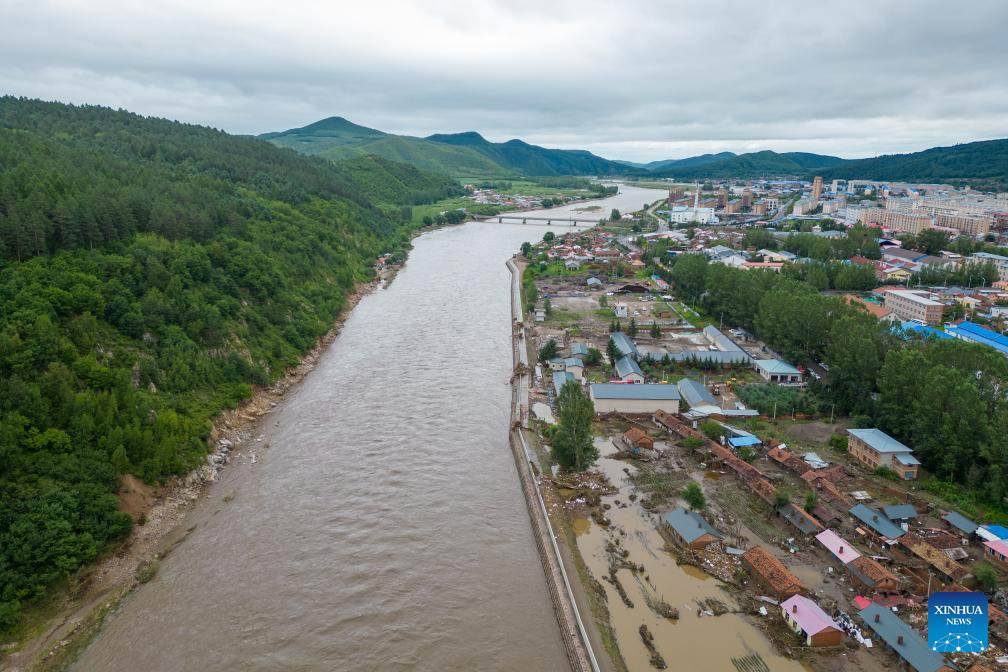
BEIJING -- China's national observatory on Wednesday continued to issue a blue alert for Typhoon Khanun, the sixth typhoon of this year, which is expected to bring a new spell of rainfall to the country's northeastern provinces.
Due to the typhoon, heavy rains are expected to lash Jilin and Heilongjiang provinces beginning Thursday, with some areas likely to be hit by rainstorms, according to the National Meteorological Center (NMC).
Typhoon Khanun is moving northwestward at a speed of 15 km per hour and is expected to make landfall on the southern coast of the Korean Peninsula on Thursday morning, according to the NMC.
Rainstorms are also expected to hit some regions south of the Yangtze River as well as parts of South China and Yunnan province in the coming three days, the NMC said.
The center urged local authorities to prepare for typhoon emergency response and remain on high alert against possible floods and geological disasters.
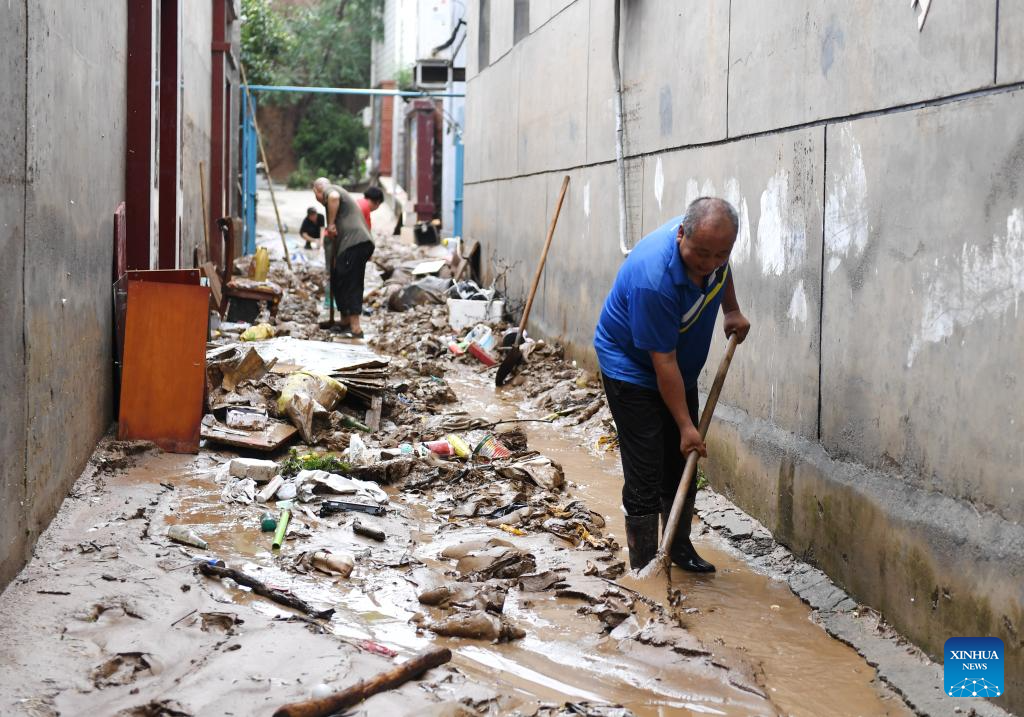
Beijing outlined the city's plans for post-disaster recovery and long-term development in response to the devastating typhoon-induced flooding, at a news conference on Wednesday in Beijing.
Xia Linmao, a member of the Beijing municipal standing committee and executive vice-mayor, said at the conference around the city's flood control and disaster relief, that the capital will achieve basic recovery in one year, comprehensive improvement within three years and long-term sustainable development in its post-disaster reconstruction.
Xia said water conservancy facilities and the houses that have been damaged and destroyed by the flooding would be basically repaired and reinforced while the self-built housing in rural areas will be reconstructed on the original sites in about a year.
Efforts will be focused on scientifically selecting centralized resettlement sites and strengthening the construction of infrastructures in transportation, energy, communication, education and healthcare, to restore the capacity to pre-disaster levels and guarantee the basic livelihood of the residents.
The comprehensive improvement within three years involves a comprehensive completion of post-disaster recovery and reconstruction work aimed at elevating disaster prevention and reduction capabilities in the affected areas.
By improving these capacities, Beijing will create a more comfortable living environment for the local population in around three years, said Xia.
The vision of long-term sustainable development underscores Beijing's commitment to long-term planning, optimizing the functional layout of affected regions, and comprehensively enhancing infrastructure and basic public service levels to continuously improve the quality and efficiency of economic development in the northern metropolis, said Xia.
Due to the residual impact of typhoon Doksuri, Beijing was pounded by extremely heavy rainfall between July 29 and Aug 2, resulting in casualties and widespread economic losses.
The city has carried out a systematic and comprehensive assessment of restoration and reconstruction needs for water conservancy, transportation, power, communication, and related infrastructural projects to coordinately promote and speed up the post-disaster reconstruction work, Xia said.
Detailed plans and funding arrangements for recovery and reconstruction projects have been formulated, Xia added.
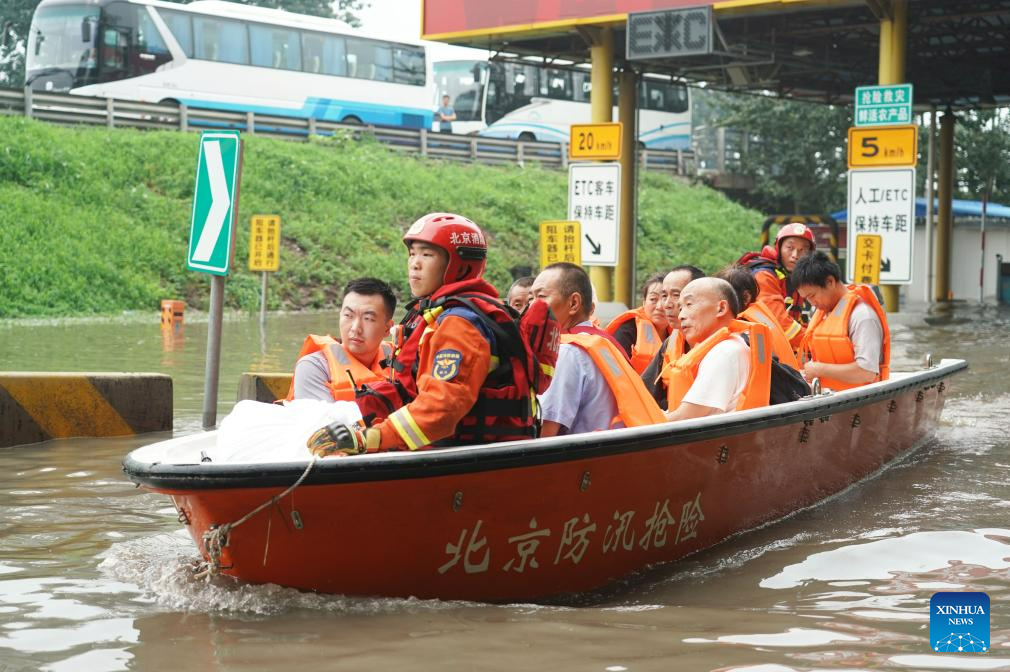
The historic torrential rainfall from July 29 to Aug 2 in Beijing brought severe flooding, with the city's western mountainous areas hit hardest and sustaining significant damage, officials said at a news conference held on Monday.
A preliminary assessment found 369 reported geological disasters in the city — 10.5 times the average annual number, Vice-Mayor Xia Linmao said.
The heavy rains resulted in extensive damage to infrastructure in the mountainous regions. More than 110 rivers or streams experienced floods exceeding safety levels, and more than 280 kilometers of river embankments were damaged. Four medium-sized reservoirs, 13 small reservoirs and 16 water gates were damaged.
Water supply plants, sewage treatment facilities, water pipelines and drainage pipelines were also affected, impacting the availability of water in 507 villages.
Additionally, power facilities, including electrical lines and distribution equipment, were damaged, leading to power outages in 273 villages and 16 residential areas. Communication facilities, such as base stations and transmission towers, were destroyed, interrupting service in 342 villages; The road network was damaged, resulting in traffic disruptions in 256 villages, according to official data.
One of the hardest-hit areas was Fangshan district, where heavy rains caused significant losses, said Zou Jinsong, Party chief of Fangshan, at the news conference.
More than 10 county-level roads, 230 rural roads and 119 bridges were partially damaged or destroyed; 77 villages were cut off because of road damage and around 21,500 households were affected. More than 60,000 houses collapsed or were severely damaged. More than 6,300 vehicles were submerged, and 13,333 hectares of farmland were flooded, bringing significant crop losses.
The unprecedented rain caused the most devastating, widespread and economically costly natural disaster ever recorded in Mentougou district, said Yu Huafeng, Party chief of Mentougou. It brought great losses in both life and property.
Roughly 310,000 people, accounting for 77 percent of the district's population, were affected, with 8,418 collapsed rooms and 26,493 severely damaged rooms.
Significant destruction was observed in infrastructure, including roads, power and water supplies and communication networks. Rebuilding will be necessary in 40 villages in the district.
In response to the damaged vehicles, Mentougou district has opened a green channel for insurance claims.
As of Monday, a total of 4,328 vehicles were reported damaged, with 1,188 vehicles already assessed and compensated, involving more than 32.6 million yuan ($4.5 million).
To better meet the needs of car owners for vehicle repair or replacement, the district will organize automobile dealerships in September to provide discounts and special consumption coupons for damaged vehicles.
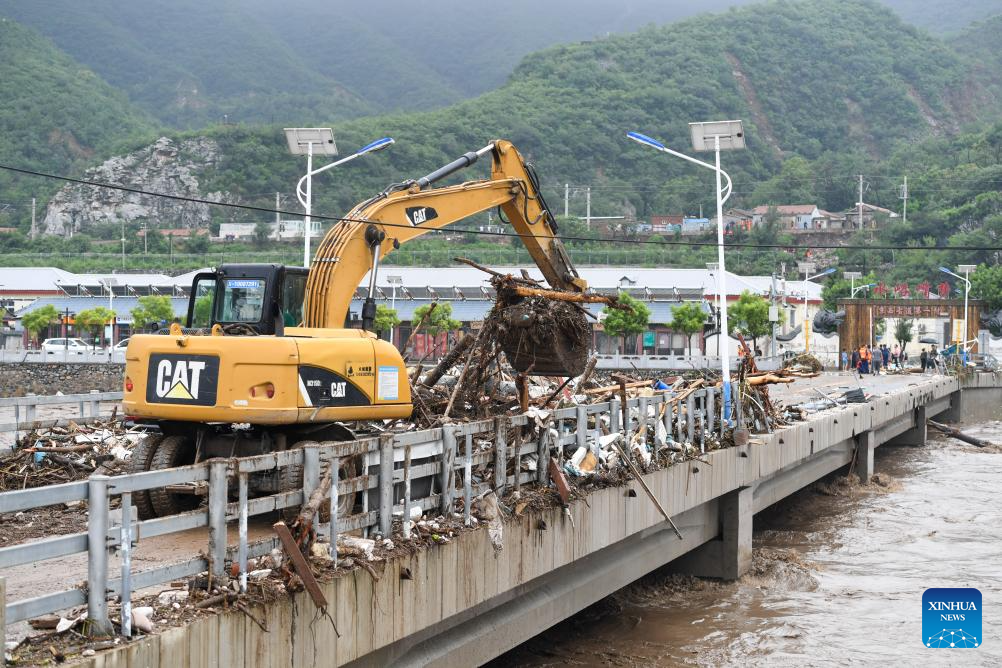
Beijing's flood control facility played an important role in response to the recent flood, Pan Anjun, director of Beijing Water Authority, said in a news conference on Wednesday.
"Based on flood forecasting, Beijing prepared 18 million cubic meters of space in reservoirs, rivers and lakes for flood storage 36 hours in advance. Additionally, we fully utilized flood control facilities in different streams and banks, and directed the flood in an orderly way," said Pan.
The city also used the upstream reservoirs in various river basins to block floods. A total of 25 reservoirs in Beijing exceeded the flood limit water level, storing more than 400 million cubic meters of water and effectively cutting the flood's peak, Pan added.
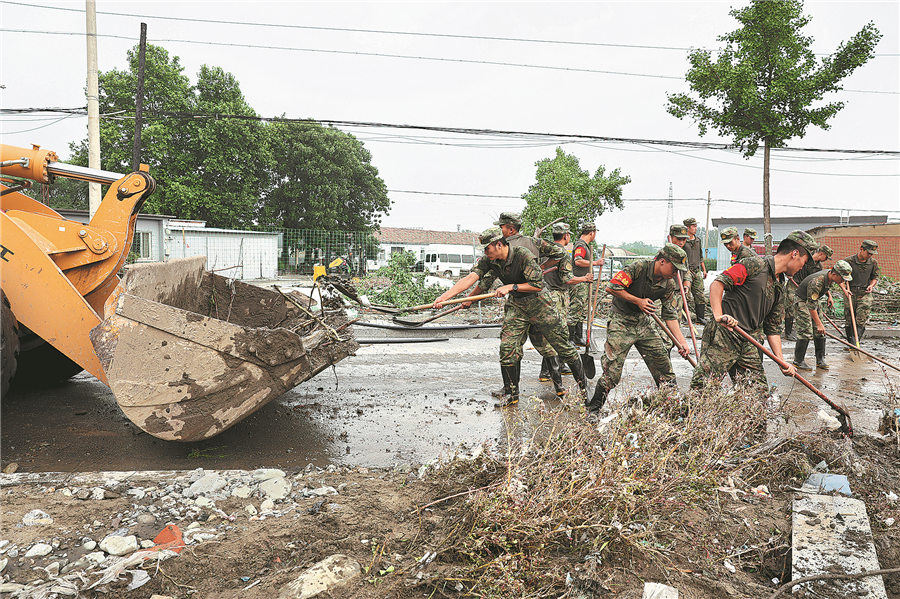
Beijing's vice-mayor conveyed heartfelt gratitude towards individuals and parties who helped with flood prevention and disaster relief, including army officers, enterprises, and sister provinces and cities, for their support on Wednesday.
"Key central organizations swiftly dispatched assistance and extended substantial aid. Beijing's State-owned enterprises immediately engaged in urgent repairs and restoration of essential infrastructure in the affected regions. Members of the People's Liberation Army, the People's Armed Police Force, and dedicated firefighters exhibited extraordinary valor by rushing to the most perilous and demanding locations without hesitation," said Xia Linmao, vice-mayor of Beijing, at a press conference briefing the flooding emergency response and follow-up work on Wednesday.
In the face of the unprecedented rainfall havoc, the central authorities, along with various crucial entities, have demonstrated unwavering support during the process of disaster response, Xia said, adding that the strenuous contributions made by everyone have culminated in a formidable force against the challenges posed by flooding and disaster.
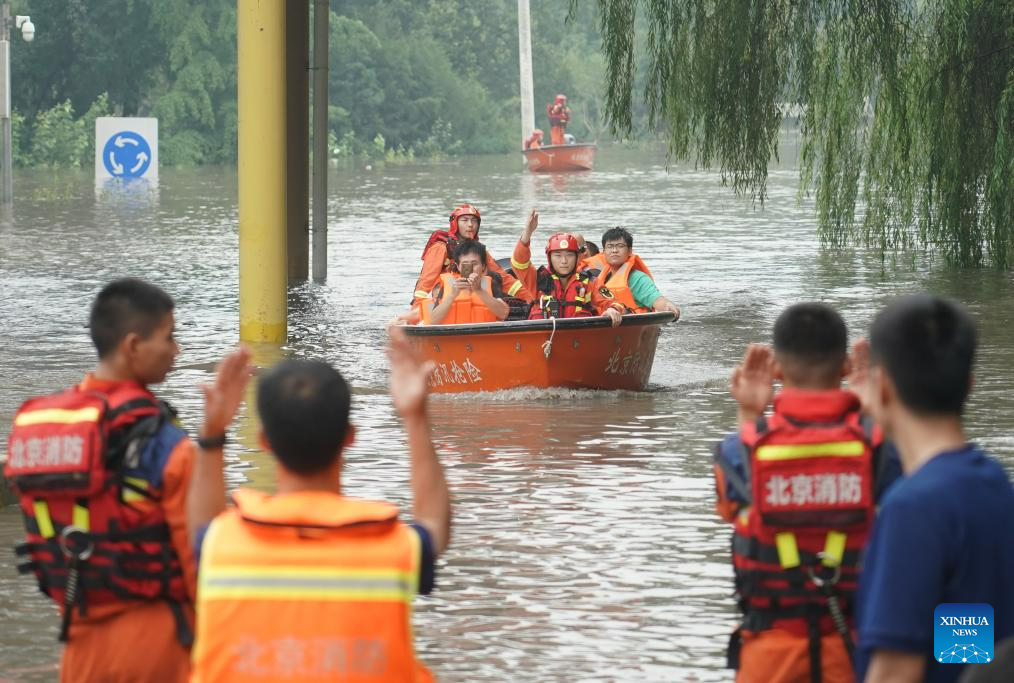
As of Tuesday, 33 people had been killed and 18 others missing caused by the heavy downpour that hit Beijing between July 29 and Aug 2, a senior Beijing official said on Wednesday.
Xia Linmao, a member of the Beijing municipal standing committee and executive vice-mayor, said at a news conference in Beijing on Wednesday that the deaths included five rescuers who sacrificed their lives in emergency rescue work during the disaster.
"And one other rescuer is among the missing," he added.
Xia expressed deep condolences to the comrades who sacrificed their lives in the line of duty and to the unfortunate victims.
"We extend our sincerest condolences to their families," he said.
The entire audience at the news conference stood up and observed a moment of silence to honor the deceased.
The flood disaster has affected nearly 1.29 million people and caused 59,000 houses to collapse and another 147,000 houses to be severely damaged, according to the conference.
Meanwhile, more than 15,000 hectares of farmland were affected by the flood, according to Xia.
"At present, these economic losses are still stage figures, and the property losses caused by the flood are still being calculated," he added.
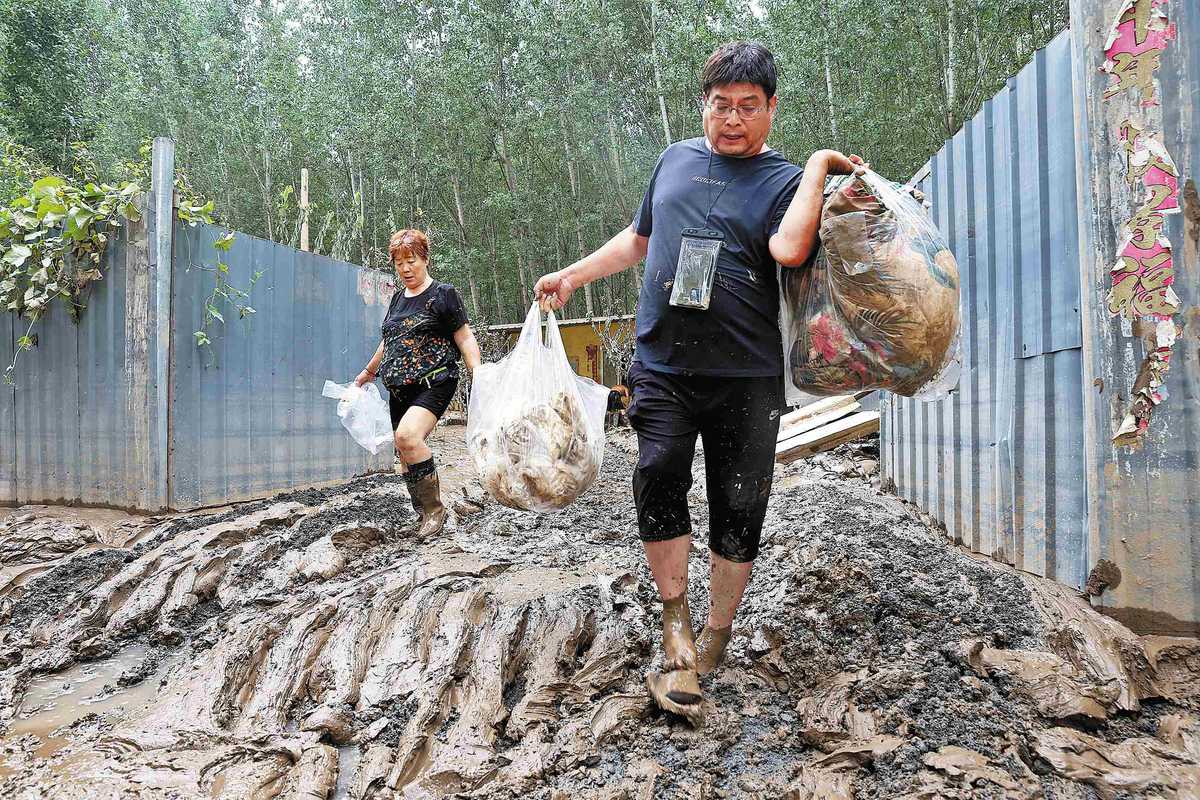
Residents in the North China city of Zhuozhou, hit by heavy flooding last week, have started receiving compensation for their losses.
Villager Zhao Jianmin received a payout from his insurance company on Tuesday morning for his vegetable greenhouses that were destroyed by floodwaters last week.
"I got 94,800 yuan ($13,100), which is a great relief for me and my family," said the 52-year-old farmer from Ningcun village, adding that he didn't expect the compensation would come so fast.
Zhao said he had been worried and anxious because his family's entire income depended on the greenhouses. "I didn't know what to do. It's all gone."
His tomatoes, planted in five greenhouses over some 5,000 square meters, were all ruined, he said.
Like Zhao, a large number of residents in Zhuozhou have suffered heavy losses from the flooding disaster since the beginning of this month.
For some, floodwaters have ruined their houses while for others the disaster has devastated their livestock and farmlands.
According to data from the local government, more than 130,000 people had been affected by the flood as of Aug 1. The number has increased in recent days.
To their relief, the government in Zhuozhou has started investigating the specific losses of each family as the floodwaters recede and post-disaster reconstruction begins.
Compensation measures will be rolled out after the losses are recorded, according to the city's statistics bureau, cited in a report from news outlet Jiemian on Tuesday.
Several other cities in Hebei submerged by floods have guaranteed timely compensation.
An open letter from the government of Dingxing county in Baoding city released on Monday said that residents in the flooded areas had been cooperative when asked to relocate before the floodwaters came. "We will record your losses and pay compensation," the letter said.
"Due to time constraints, changeable rain and other factors, our work in the transfer, resettlement and services was not that considered and thorough. We are glad to receive criticism for our conduct and beg for your understanding," said another public letter from the government of Yongqing county in Langfang city dated Aug 3.
The county is located in a flood plain of the Yongding River where heavy rainfall has forced residents in more than 60 villages to be relocated temporarily.
The county's government guaranteed that adequate compensation will be provided to villagers for their losses in crops, breeding, housing, agricultural machinery and other aspects.
In Langfang's Anci district, which is also located in the flood plain, nearly 50,000 residents from 84 villages were relocated. "They have made a great contribution in the process," a public letter from the district government said on Thursday.
"I feel relieved seeing the government has not forgotten us, and I believe we can recover together," farmer Zhao said.
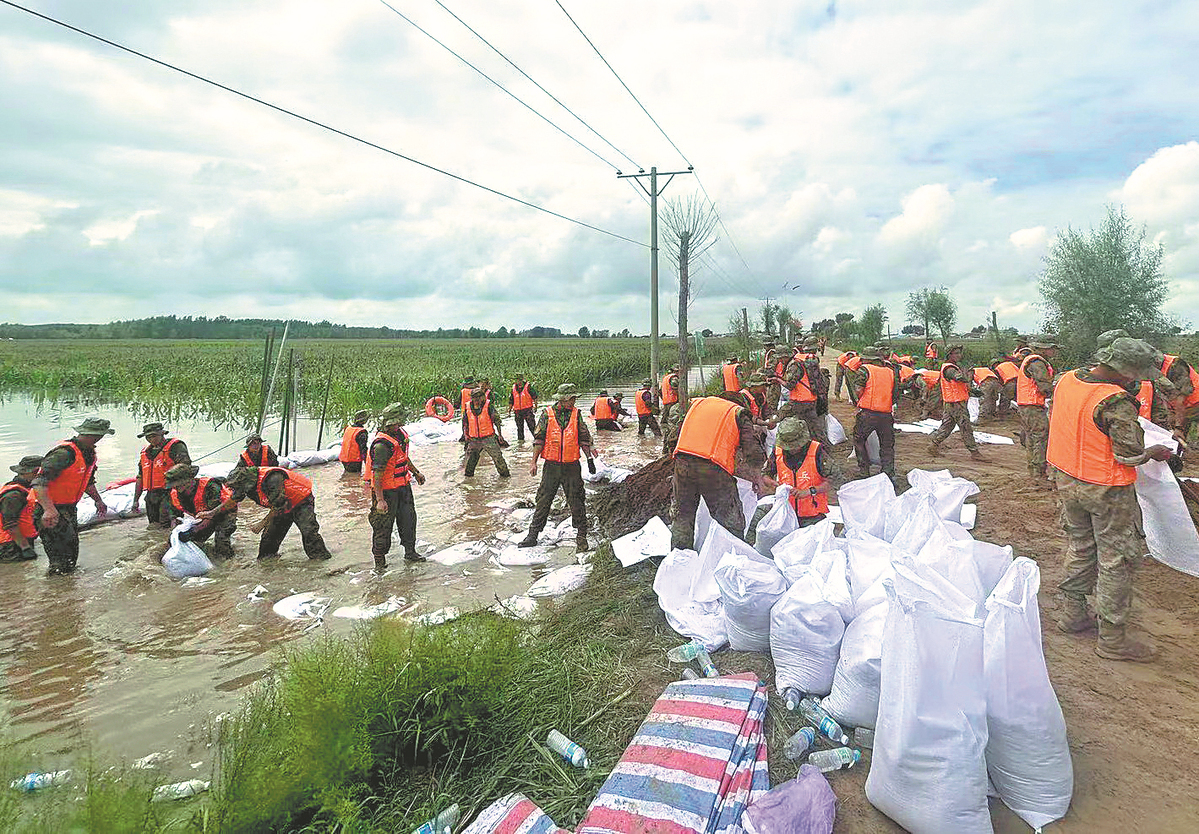
Thunderstorms forecast as rescue operations, mopping up continue
A large area of Northeast China is facing a double blow after one typhoon wreaked havoc as it headed north, and another is headed the same way.
Severe flooding as a result of the heavy rainfall brought by remnants of Typhoon Doksuri has inflicted huge losses on Jilin and Heilongjiang provinces in the past few days.
In Jilin, the downpour began on Aug 1, affecting most areas of the province. By Friday afternoon, Yongsheng Forest Farm in Shulan city experienced rainfall of nearly 500 millimeters, far exceeding the previous record of 103.6 mm, according to the local government.
By Friday night, the heavy rainfall had left 14 dead in the city, with one person still missing. More than 134,000 people have been affected by the floods, the Shulan flood control and emergency response headquarters said.
Jilin meteorological service forecast that from Aug 10 through 13, the province will likely experience thunderstorms brought by Typhoon Khanun.
Heilongjiang's southern areas have experienced record rainfall since Aug 2, leading to severe floods in Harbin and Mudanjiang cities. The provincial meteorological service issued red warnings for heavy rainfall, the highest of the four-tier warning system, from Aug 2 through 5.
By Sunday, more than 270,000 Harbin residents had been affected by the floods and over half of them relocated. About 90,000 hectares of crops have been inundated by water.
Thanks to early prevention measures, Huanshan village in Harbin, which is surrounded by mountains and has a population of 720, managed to avoid any casualties during the heavy rains and subsequent floods, Southern Weekly reported.
Zhang Zhenbao, a villager, said they had paid attention to the weather forecasts and planned ahead.
"As soon as the rainfall reached a certain level, we organized people to evacuate. As we are close to the mountains, we sought refuge in higher-up houses, gathering in these households. We squeezed ourselves in the houses by either sitting or standing, and managed to overcome this challenge," Zhang was quoted as saying.
He said on Aug 2, within eight hours of the water rising, a number of military boats arrived and began rescue operations.
To tackle the disaster, the provincial government has drawn rescue workers from various departments including transportation, housing and urban-rural development, emergency management, telecommunications, and power supplies to participate in rescue and relief efforts, Xinhua News Agency reported.
"With the floodwaters receding, villagers are intensifying their efforts to resume life," Zheng Xiaokang, a police officer from Jiangxi village in Mudanjiang told Xinhua.
In recent days, Zheng has been actively aiding villagers in removing mud from their homes and cleaning up premises.
"I still feel scared when I recall the recent flooding. In the face of the persistent downpour and rising river water, the consequences would have been devastating had we not managed the timely evacuation of villagers," Zheng was quoted as saying.
On Aug 3, in response to the critical situation, Heilongjiang raised its flood response level from four to three. A day later, the level was raised yet higher to two. So far, 25 working groups have been sent to rescue people and aid flood control work, the local government said.
The northeastern region of China remains on alert as Typhoon Khanun, the sixth typhoon of this year, is expected to bring strong winds and torrential rain to the region in the following days, Xinhua reported.
Contact the writers at lihongyang@chinadaily.com.cn

The People's Armed Police Hebei Corps has started clearing the roads in Zhuozhou, Hebei province, after the recent flood. The soldiers are using loaders, dump trucks, washers, sprayers, and water cannons to help local residents clear the mud and debris that has accumulated on the roads.
The clearing work is still ongoing, but some roads have already been reopened. The soldiers have also been working to search for and evacuate people who are still stranded in the floodwaters.
So far, the soldiers have successfully searched and evacuated over 2,000 people and cleared over 2,000 cubic meters of mud. Their efforts have helped to alleviate the traffic congestion and make it easier for people to get around.



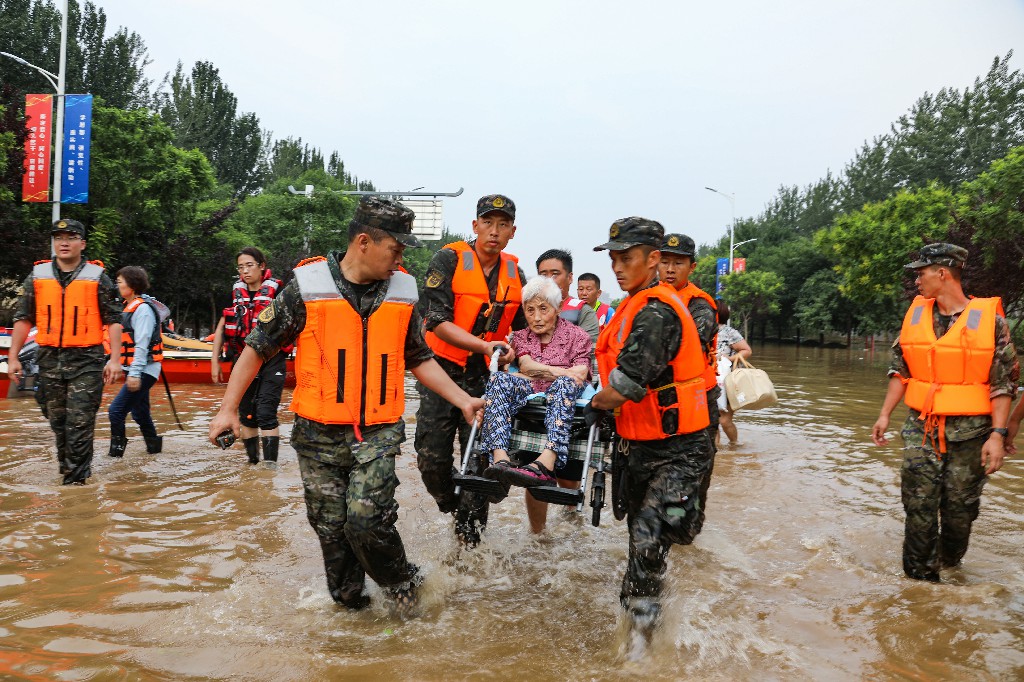
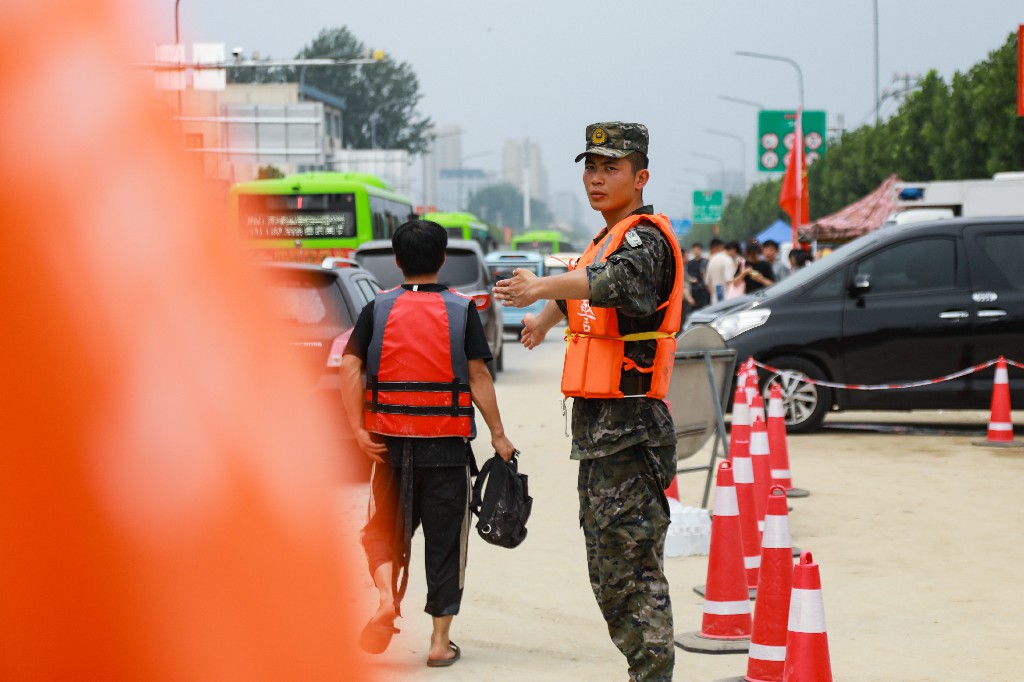

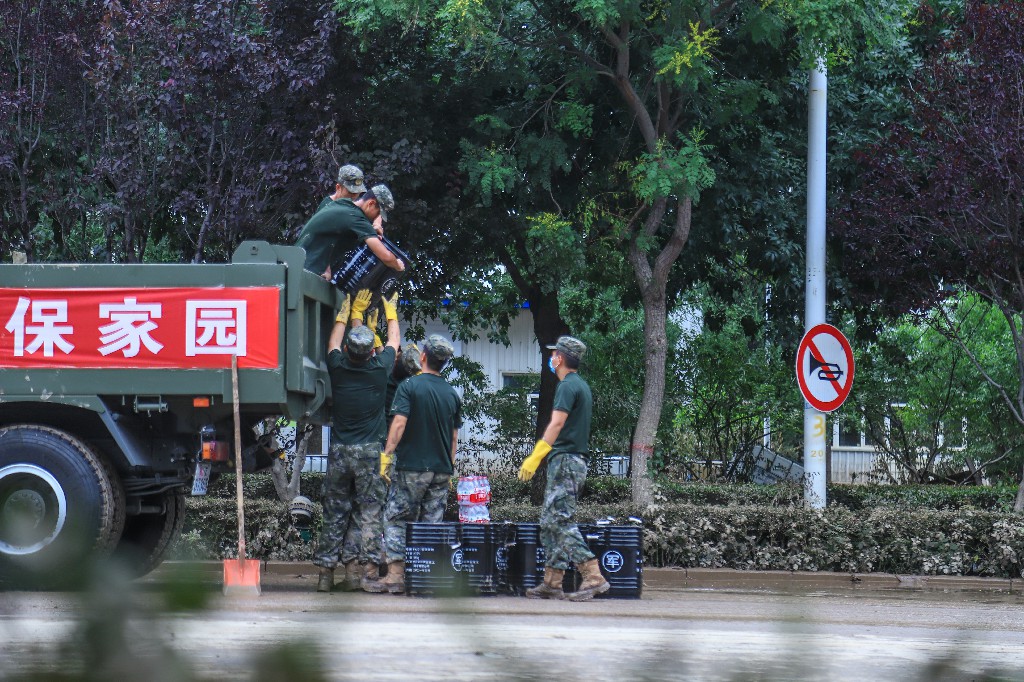

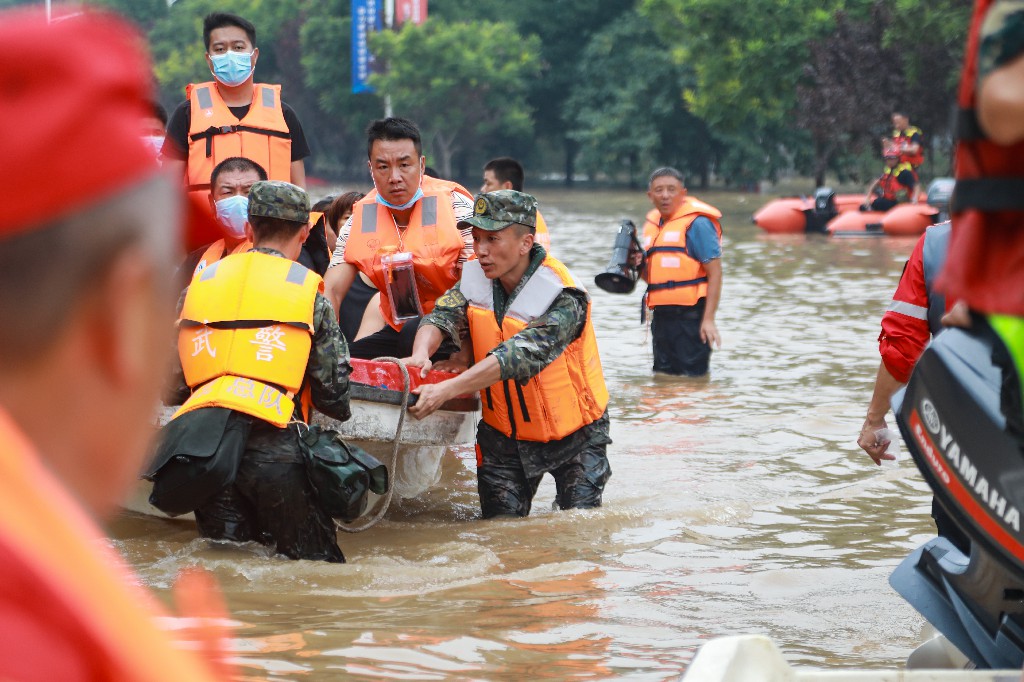
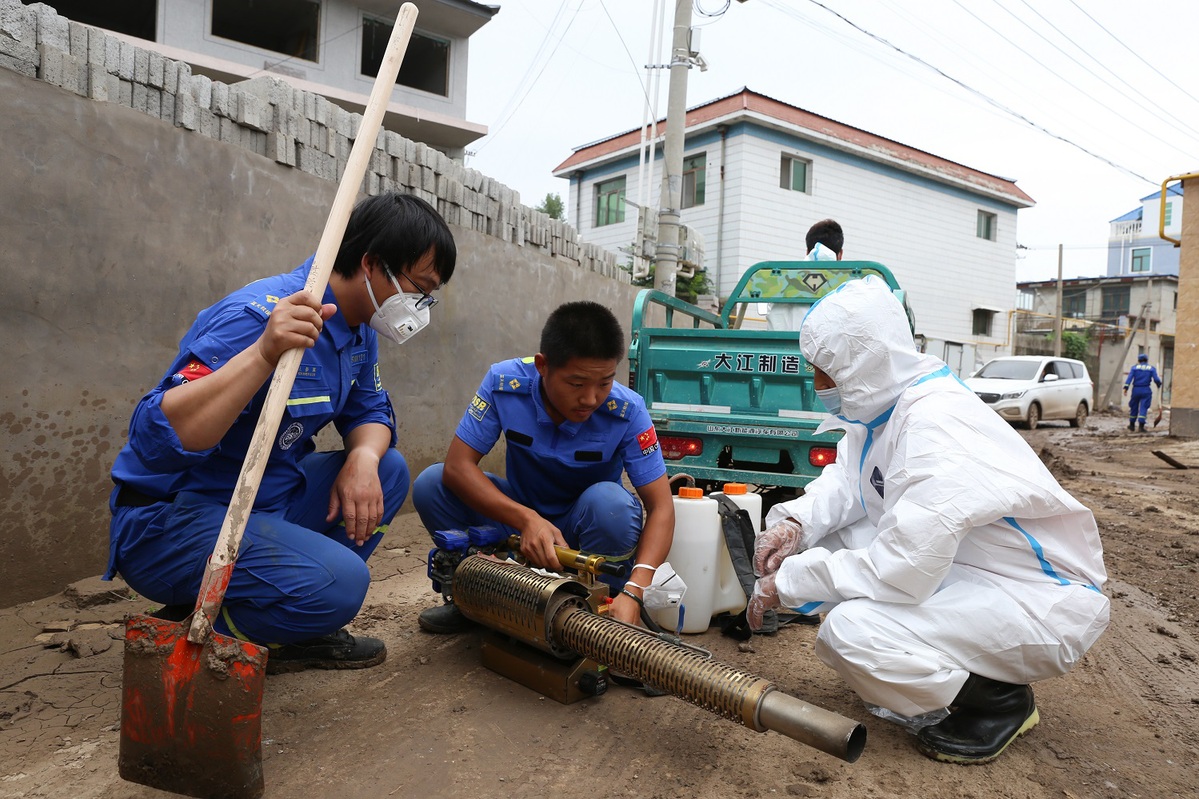

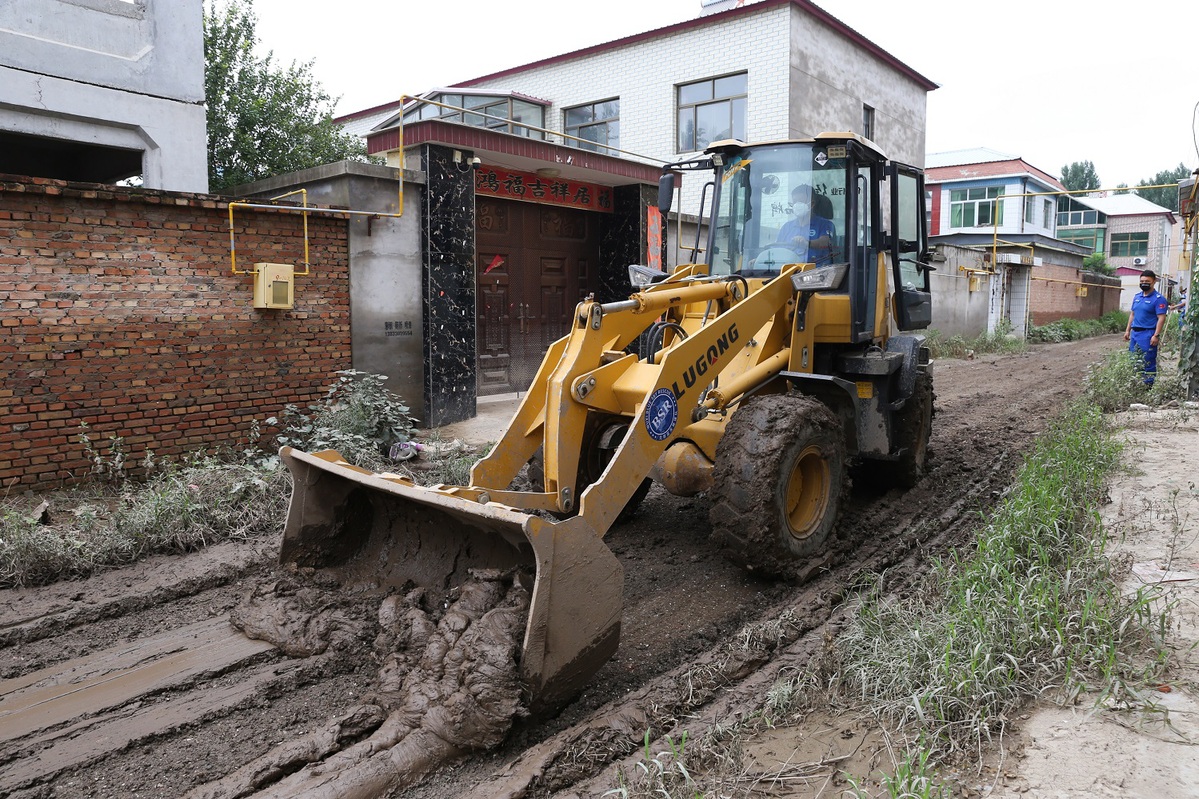
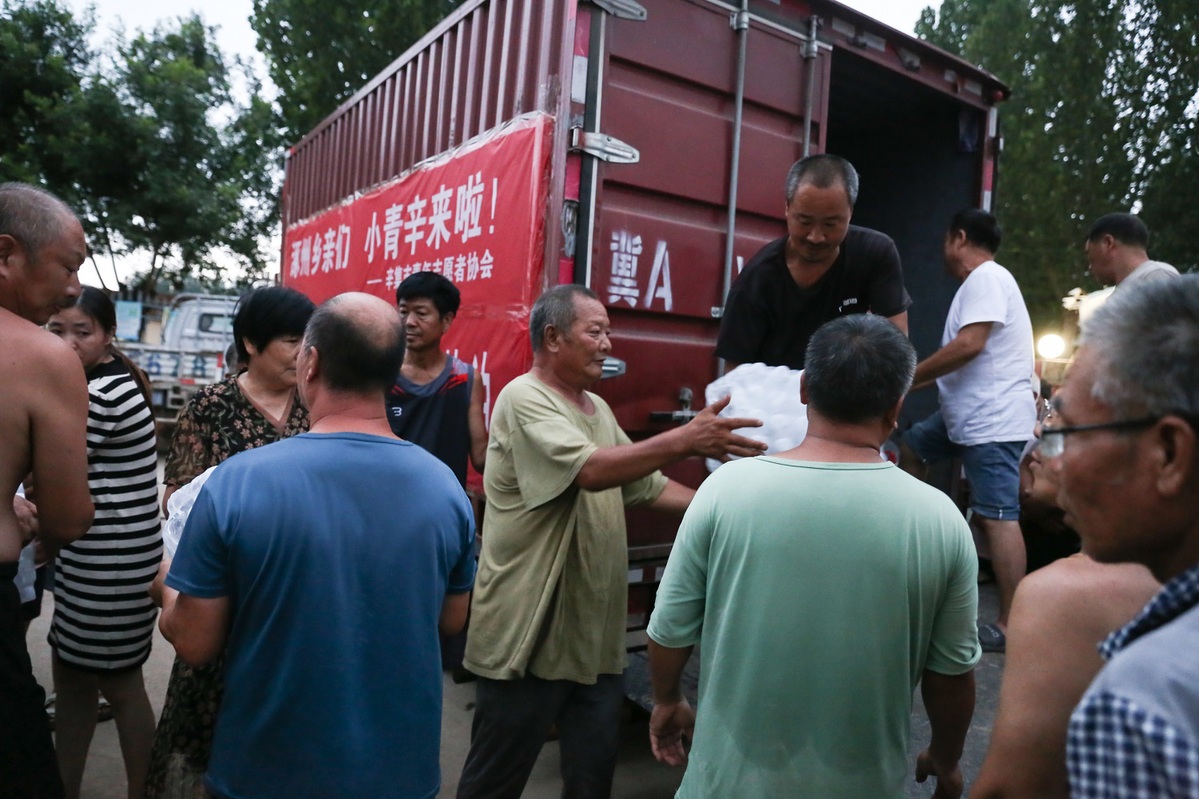
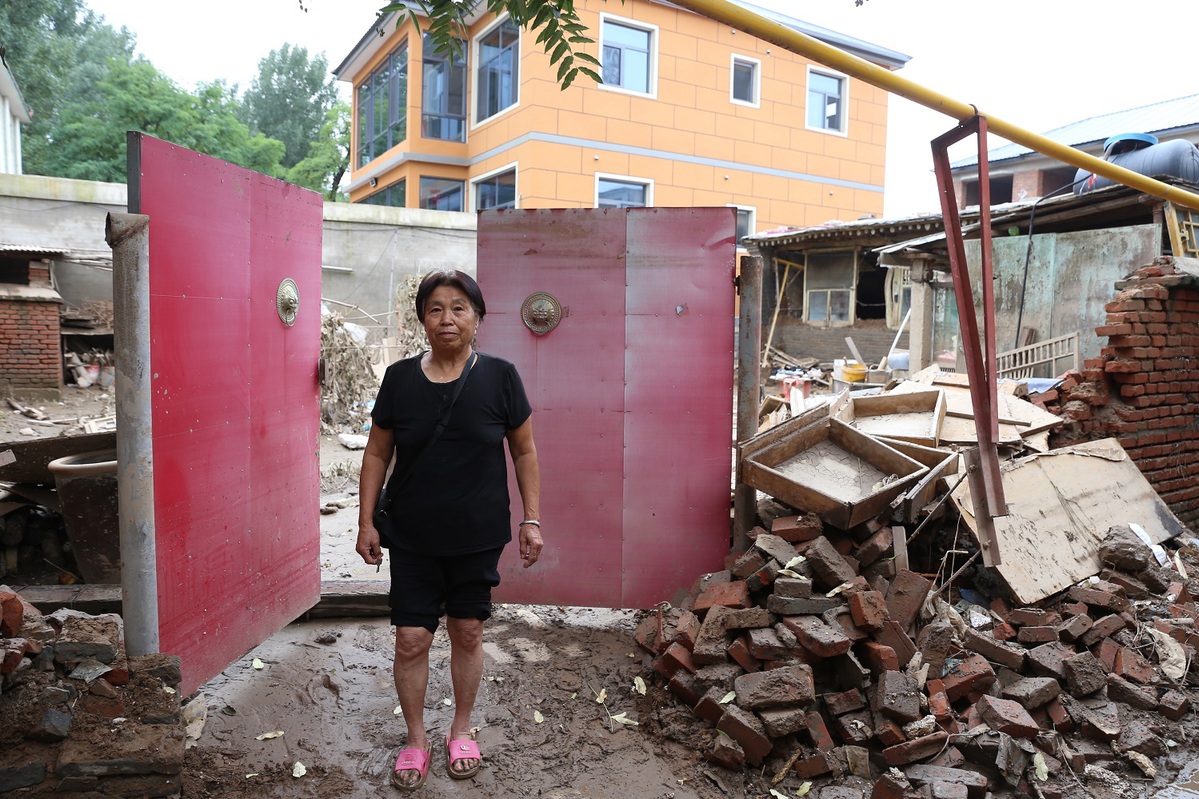



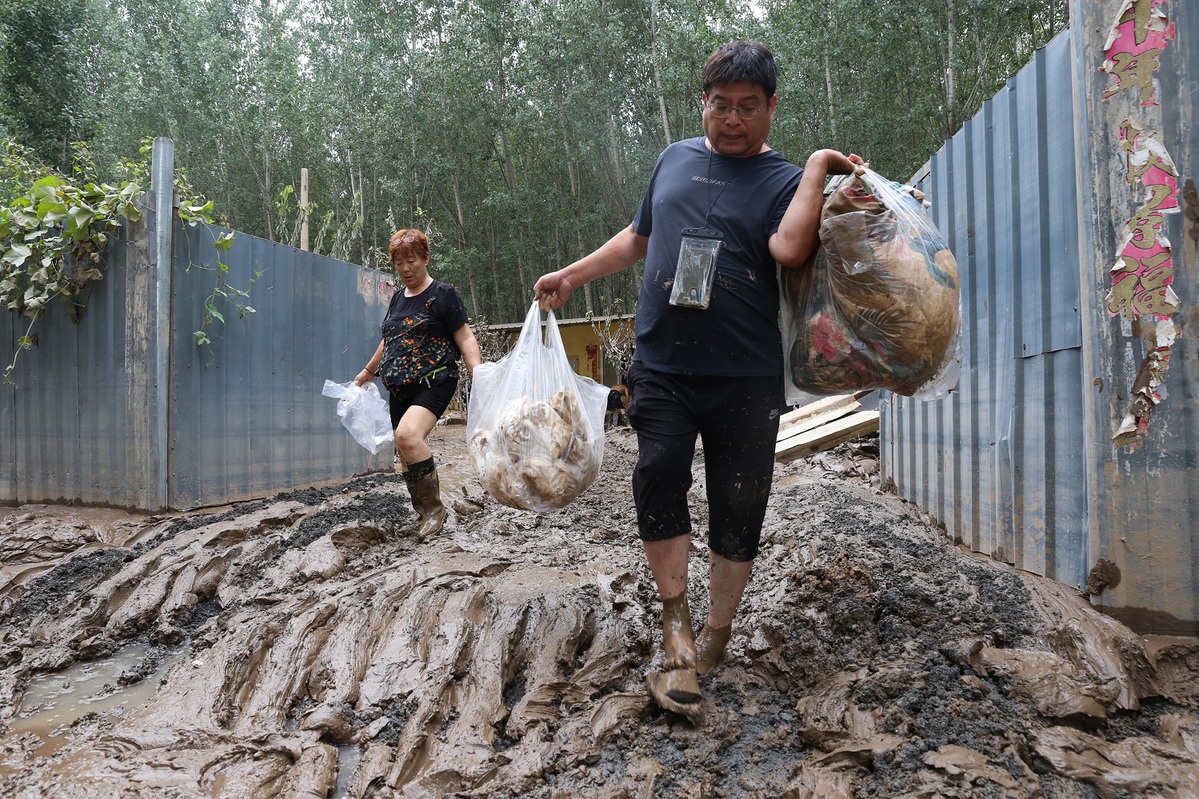

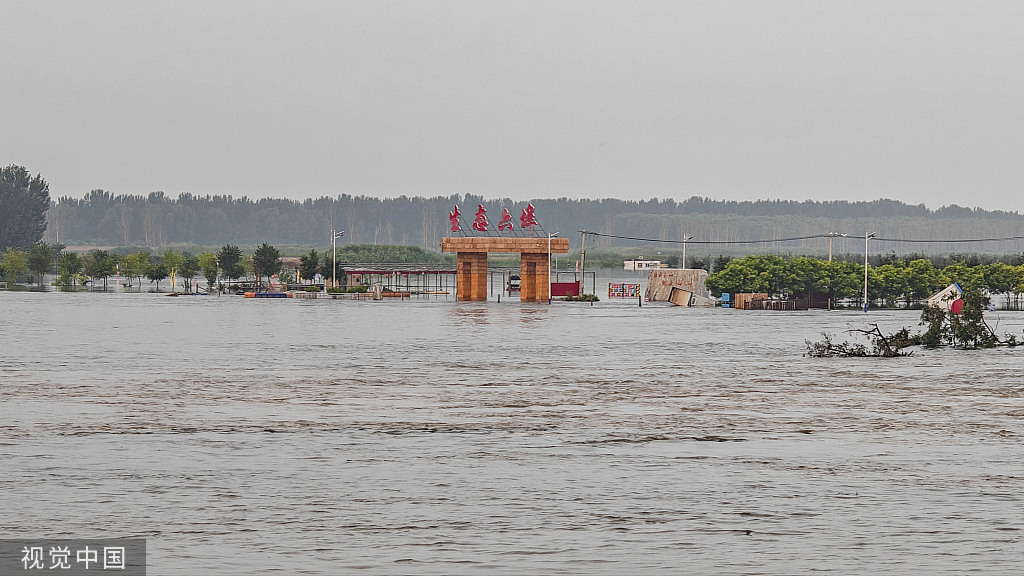
Measures in place to battle possible torrents, at-risk residents relocated
Tianjin has relocated more than 80,000 residents from flood-prone areas, as a large volume of upstream water flows toward the city, posing a major challenge to authorities to prevent damage.
Located by the Bohai Sea, Tianjin covers the estuaries of three major rivers in North China's Haihe River Basin, including the Daqing, Yongding and Ziyaxin.
Unprecedented heavy rainfall since the end of last month has sent floodwaters moving toward Tianjin after the torrents passed through upstream regions last week, including some cities in neighboring Hebei province. Flooding red alerts have already been issued.
Tianjin has taken multiple measures to prepare for the floodwaters, including reinforcing riverside dikes, dredging waterways and relocating large swathes of residents.
The majority of relocations are from Xiqing and Jinghai districts, which are covered by the Dongdian water detention area. The low-lying area, which helps divert and retard floodwaters, was put into use on Aug 1.
The area covers 379 square kilometers, with 100 sq km in the two districts of Tianjin. The remainder of the detention area is in Hebei.
According to a notice from Jinghai district's flood prevention authority, all the residents in Taitou, Duliu and Wangkou townships were relocated before Thursday.
More than 30,000 people from 23 villages have been relocated, according to ThePaper.cn.
Residents of two other districts, Wuqing and Beichen, were earlier relocated, as they were also in flood-prone areas.
After residents were moved to safe areas, rescue teams started patrolling villages and riverbanks to prevent people from returning to their homes.
The dikes of rivers in the city were also strengthened and raised to reduce the threat of rising floodwaters, the report said.
The head of the floodwaters entered Tianjin on Friday and it would take two or three days for the water level to peak, Yang Bang, an official with the hydrographic office of the Haihe River Water Conservancy Commission, told ThePaper.cn.
The commission is based in Tianjin and is under the administration of the Ministry of Water Resources.
It will take a further 12 to 15 hours for the floodwaters to run into the estuaries and then flow into Bohai Sea, Yang said.
As of Monday, cornfields in some villages had been submerged by floodwater. "If there is no more rain, it will take more than two months for the floodwaters to recede from the flood detention area," Yang said.
However, the downtown area of Tianjin would not be flooded as Yongdingxin River to the north and Duliujian River to the south, had been expanded in the past to deal with flooding, said Yang Zhigang, head of the commission's flood and drought disaster prevention department.
"The rivers play important roles in preventing floodwater running into the city," he said.
Although the floodwater in the Haihe River Basin is receding, there are still risks, Yang Zhigang added.
"People that have been relocated should not go back to the flood-prone areas arbitrarily, given that the receding of floodwaters in the flood detention areas will need a long time," he said.
To allow floodwaters to subside smoothly, local flood prevention authorities should remove obstacles in river channels such as some structures and low bridges, he added.
According to Yang Zhigang, dikes in the country's northern areas have not been tested by major floods for a long time. So there may be some hidden dangers when suddenly faced with a large flood, such as collapsing structures, especially in areas soaked by water for a long time.
"Enough personnel are needed to strengthen patrols of such areas," he said.
Xie Yan, the chief economist of the State Grid Corp's Tianjin Jinghai branch said, "We have strengthened the patrols of ultrahigh voltage transmission lines near the villages, and are well prepared to do rush repairs".
The company has set up 24-hour services, including patrolling vehicles and increased numbers of engineers, to deal with any possible power cuts caused by the incoming floods.
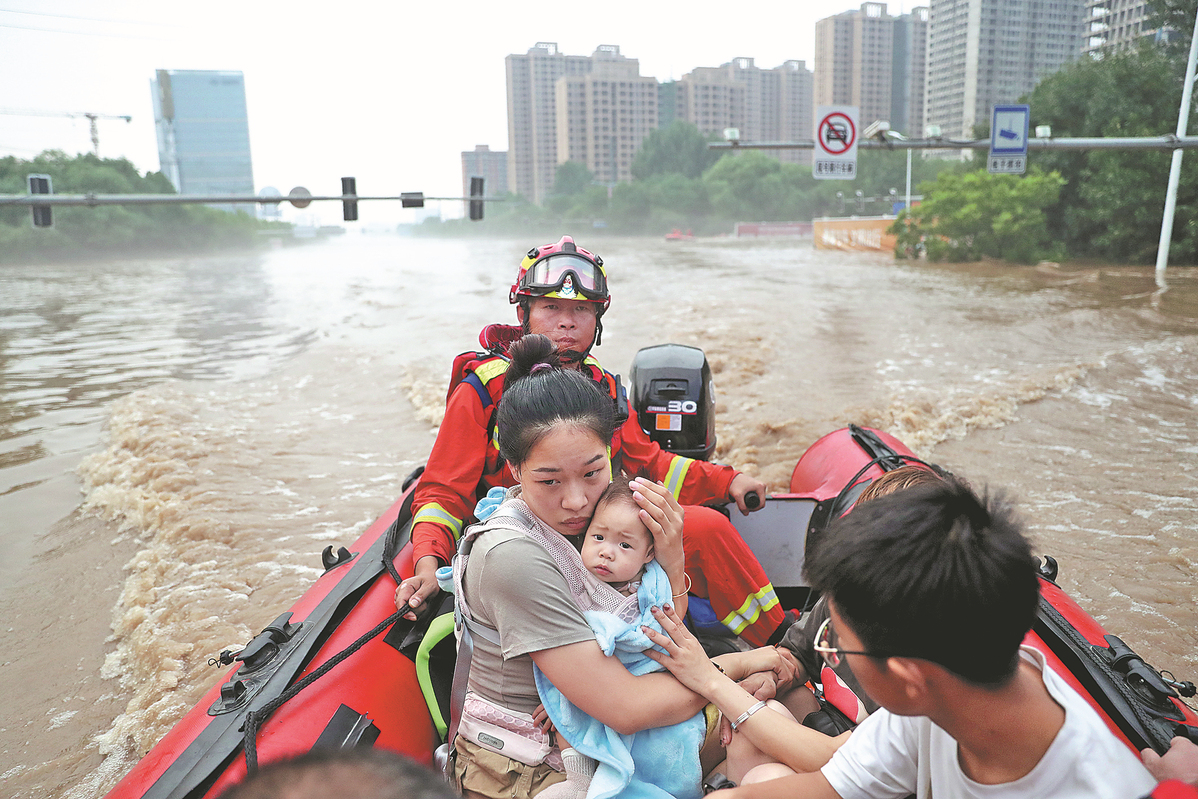
Residents brought to safety in stricken areas of Hebei province
Editor's note: Amid torrential rainfall in the Beijing-Tianjin-Hebei region, our reporter rushed to Zhuozhou, Hebei province, where thousands of people were trapped in floodwaters and waiting for rescue. He recounts his conversations with rescuers and evacuated residents.
A heavy traffic jam formed as vehicles lined up for more than 500 meters waiting to leave the highway at the southern entrance to Zhuozhou, Hebei province.
Many of the vehicles were transporting rescue team members, while some pickup trucks towed inflatable dinghies and motorboats.
The rescue vehicles, arriving from different parts of the country, bore license plates from Shanghai, and Sichuan, Shandong and Shaanxi provinces, among others. The drivers of private cars yielded to these vehicles.
I was driving toward flood-hit Zhuozhou on Wednesday morning, and set the Zhuozhou city government headquarters as the destination on my phone's navigation system. Colleagues kept me updated with real-time information about the floods, and they also told me that the southern entrance to the city was the only one still open to vehicles.
After leaving the highway, I drove through village roads still submerged in floodwaters due to the heavy rain.
The water was not too deep, but traffic lights along the way were not functioning.
Zhuozhou is a county-level city administered by Baoding, with the Taihang Mountains running from northwest to southeast. The North Juma River flows through the north of the city, with six rivers, including the Yongding, the Xiaoqing and the Baigou converging in the area.
Xinhua News Agency reported that as of 10 am on Aug 1, 133,913 people had been affected by the flooding in Zhuozhou, with the affected area covering 225.38 square kilometers.
When I arrived at Runhe Street, Diaowo town, the road was severely flooded, and some drivers were turning back. I parked my car by the roadside, noticing that while SUVs could pass through the water, cars could not.
Sending a vehicle location to myself on my phone, I decided to proceed on foot.
As I continued walking, the water became deeper. Several backhoes, or excavating machines, were being used to ferry stranded people. Those on these vehicles held onto the excavator buckets tightly, afraid that sudden jolts might send them falling into the muddy water.
Nearby, a group of people stood in front of a store selling daily necessities, with some of the shelves already empty. I asked a middle-aged man in the store who was tidying up the shelves, "Boss, do you have any plastic slippers?"
He replied: "We've sold out. The last pair of women's slippers were just bought by an old man."
After stopping a truck to cross a waterlogged section of road, I proceeded along Fanyang East Road, a major thoroughfare in Zhuozhou.
Many people walking toward me were carrying their luggage. Their feet and suitcase bottoms were covered in mud. Their clothes clung to their bodies, soaked either with sweat or rainwater.

Sweating profusely
The weather was oppressively hot and humid, and I was sweating constantly. It felt as though I was in a giant sauna.
Walking against the flow of people, I noticed that those heading in the same direction as myself were mainly members of rescue teams.
Holding my camera, I stood out among the crowds walking in the opposite direction.
The water reached up to the knees. At road intersections and in alleyways, the water flowed rapidly, making it difficult for people to remain on their feet.
At the intersection of Fanyang East Road and Tengfei Road — a major junction in the city — I saw rescue team members in various colored uniforms shuttling between motorboats, bringing those affected by the floods to an embankment made of sandbags.
The embankment, about half a meter high, separated two areas. On one side there was muddy water, and on the other an asphalt road. Those rescued stepped onto the road, clearly relieved to have finally reached safety.
Some motorboats could not reach shallow water near an embankment, stopping about 10 meters away. Rescue teams were quick to assist, wading through knee-high water, pushing and pulling the boats closer to a human wall formed by colleagues on the embankment.
Rescuers in the human wall helped people — some of them carrying children, others their belongings — off the boats, taking them to a safe area.
This T-shaped intersection became a temporary dock, busy and chaotic, but with an overall sense of order prevailing as priority was given to rescuing those affected by the floods.
A tourist boat ferried 12 people recently rescued to the temporary dock before returning to continue the search in deeper waters. I followed the boat as the search progressed.
A skilled helmsman in the stern of the boat said: "We brought the vessel here last night, towing it on a trailer from the Baiyangdian Scenic Area. We've already rescued more than 80 flood victims."
A rescuer in the bows of the vessel used an iron pole to push away debris that occasionally floated toward us. As we continued along Tengfei Road, the water was more than 2 meters deep.
When the vessel approached overhead traffic lights, the man standing in the bows crouched down for the boat to pass through. Large trucks lined both sides of the road, submerged in the water. One, with the words Zhongtong Express on its side, was partially submerged.
The water was murky, with plastic bags and bottles floating on the surface. The sight line was level with the rooftops of shops, and cars parked at the roadside were completely submerged. Speedboats brushed against the car roofs.
On the opposite side, motorboats loaded with flood victims continued to approach. Those on the boats gestured with clenched fists, indicating that our boat should slow down a little to avoid splashing them.
The man in the bows raised a thumb in acknowledgment, while applauding rescue team members in one of the boats opposite us.

Village mission
The boat team leader said: "We will go to Diaowo village again to check. There are four villages in Diaowo, and many people must be trapped there."
Poplar trees on both sides of the country road leading to Diaowo were no longer visible, with floodwater reaching the top of courtyard walls in the village.
Inside houses, everything was submerged. Through the windows, furniture could be glimpsed floating in the water.
A large pig and several chickens were floating on pieces of wood, while a group of villagers standing on rooftops waved for us to come closer.
The boat navigated alleyways in Diaowo, occasionally bumping into utility poles. The entire village was flooded and there was no cellphone signal. It felt like a remote island.
Liu Liu, a villager from Diaowo, carried her 6-month-old baby with the help of the rescue team. She climbed onto the motorboat from the rooftop of a room in her courtyard, accompanied by her father and sister-in-law.
"I only brought a few pieces of baby clothing with me — many other things are soaked and cannot be used," Liu said.
She told her baby: "Don't be afraid. It will be all right soon." The infant's crying sounded especially loud, breaking the silence together with the sound of the motorboat engine.
The vessel made its way through the village, but due to limited access, it was not suitable for rescue operations. Several rescue team members riding water motorcycles passed by.
The helmsman said, "You guys ride your motorcycles to pick up people in the village, and we'll wait on the main road to provide support."
The boat leader then teamed up with Blue Sky Rescue team members riding the water motorcycles — significantly improving the speed and efficiency of the operation.
One Blue Sky Rescue team member said: "Let's quickly make two more trips to bring people to safety while there is still light. We don't want them to be stuck in the village overnight. It will be unsafe without electricity if the water rises again."
The sky gradually began to darken, while a thin mist rose from the water surface, reducing visibility and making the rescue operation increasingly difficult.
With no phone signal in the village, I was unable to send my report back to Beijing, so I decided to turn back, following a speedboat.
As we approached the temporary dock, I saw a large group of rescue team members anxiously waiting in the distance.
Upon returning to safety, I immediately felt at ease. Alongside me, a young man carried his pet cat in a backpack as he disembarked from the speedboat.
Glad to be alive while having experienced the aftermath of nature's fury, I could sense the compassion and care of humans amid the relentless floodwaters.
wangjing7@chinadaily.com.cn
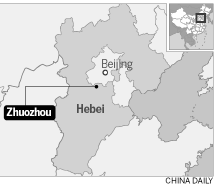

Zhuozhou city in North China's Hebei province has carried out extensive disinfection since the weekend after it was seriously flooded by heavy rainfall and overflow from nearby rivers.
A red cross rescue team from Huaibei city in Anhui province came to a local school in Zhuozhou on Monday to disinfect the campus and classrooms.
Dressed in protective clothing, a team of 15 members sprayed disinfectant thoroughly over 9,200 square meters at the school in an effort to inhibit the growth of bacteria and viruses after the flooding.
Apart from the school, the team has also gone to residential communities and has disinfected more than 80,000 square meters of area, according to Wang Tao, a member of the team from Anhui.
After the disinfection, they will start another task of delivering necessities to the local residents who had suffered great lost from the flood disaster.
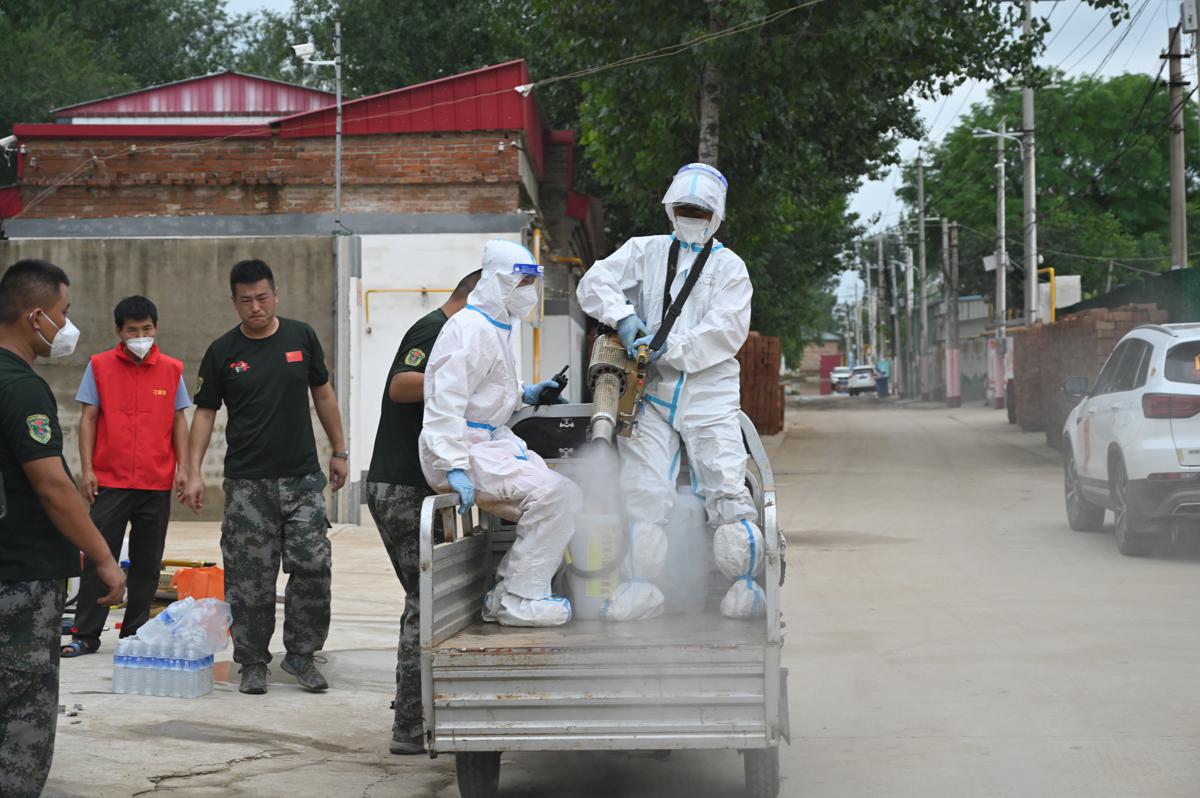


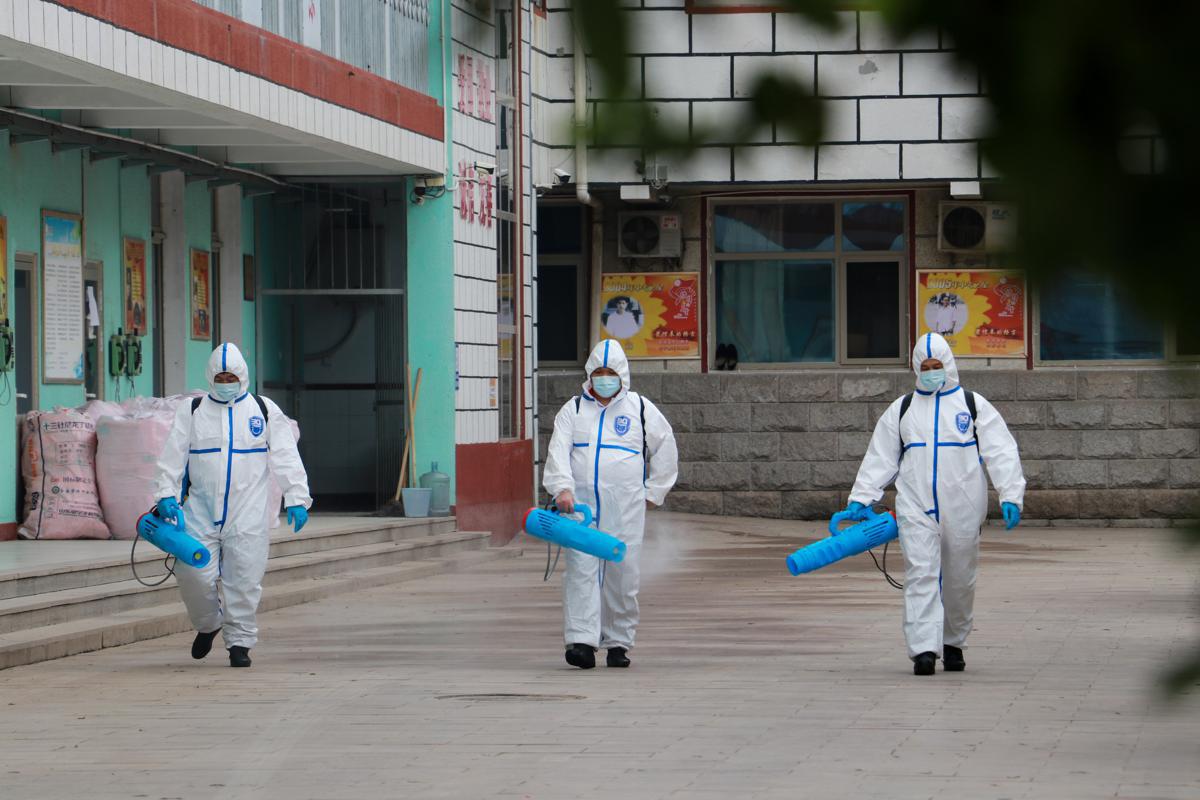

Residents evacuated from the flood in Zhuozhou, Hebei province, are asked not to return home without authorization as there are still risks for secondary disaster, local authorities said.
Water is receding after the homes of tens of thousands of people have been damaged by flooding since July 31, after Typhoon Doksuri brought a big rainstorm that swept across North China last week. However, during the recovery process, there is still danger of collapsing and contagion so residents should still remain cautions, according to a notice released by the publicity department of Zhuozhou on Sunday.
Residents are asked to stay away from rivers to avoid a fall or injury. To accelerate road clearing, disinfection and restoration of water and power supply infrastructure, private cars are asked not to park at major transport junctions and obey the guidance of on-site workers. Residents are also suggested to reduce the frequency of outings to save time and to spare channels for after-flood recovery, it said.
"In flooded areas, we will spare no effort to carry out silt removal, environmental disinfection and vector control for disease prevention. We kindly remind all citizens to pay attention to environmental hygiene and food safety, and take precautions against infectious diseases. To ensure personal safety, we urge all citizens to stay away from waterlogged areas, dilapidated buildings, and all types of power and gas facilities," the notice said.
The Hebei provincial government released measures to help prevent the spread of animal diseases after the flood. These measures include salvaging and transporting dead animals for harmless disposal, and monitoring high-risk areas to prevent diseases like African swine fever, avian influenza and anthrax. Other steps include enhancing the disinfection of slaughter and processing facilities and farms or trade markets that house livestock and poultry.
Hebei will carry out emergency monitoring of animal disease pathogenology from Aug 3 to 10. As of Saturday, all 1,786 samples have tested negative, according to the provincial agriculture and rural affairs department.
